Advanced Billing For WHMCS
(→About Advanced Billing For WHMCS) |
(→OpenStack VE VPS & Cloud Configuration) |
||
| (126 intermediate revisions by 5 users not shown) | |||
| Line 4: | Line 4: | ||
=About [https://www.modulesgarden.com/products/whmcs/advanced-billing Advanced Billing For WHMCS]= | =About [https://www.modulesgarden.com/products/whmcs/advanced-billing Advanced Billing For WHMCS]= | ||
{| | {| | ||
| − | |style="padding: 10px 0px 10px 0px;"|'''Advanced Billing For WHMCS''' | + | |style="padding: 10px 0px 10px 0px;"|'''Advanced Billing For WHMCS''' enables you to implement flexible billing models based on the actual usage of resources such as bandwidth, CPU, and other server capabilities.<br /> |
| − | + | This module supports multiple currencies and offers various billing options, including hourly billing, credit billing, and recurring billing.<br/> It automatically generates invoices according to your preferred settings and at customizable intervals, sending them directly to your customers.<br/> | |
| − | + | Additionally, clients can set up email reminders to notify them when they reach or exceed specified resource usage limits.<br/> | |
| − | + | ||
| − | Advanced Billing For WHMCS is | + | Advanced Billing For WHMCS is compatible with many popular modules, including cPanel, Plesk, and SolusVM, as well as a variety of ModulesGarden products.<br/> |
| + | |||
| + | The Wiki page for '''Advanced Billing For WHMCS 3.x''' can be found [https://www.docs.modulesgarden.com/Advanced_Billing_3.X_For_WHMCS here].<br/> | ||
|} | |} | ||
| − | |||
*'''Core Features:''' | *'''Core Features:''' | ||
{| | {| | ||
| Line 16: | Line 17: | ||
|} | |} | ||
{| | {| | ||
| − | |style="padding: 0px 0px 0px 30px;"|✔ | + | |style="padding: 0px 0px 0px 30px;"|✔ Specific Resources Billing For Integrated WHMCS Modules |
|} | |} | ||
{| | {| | ||
| − | |style="padding: 0px 0px 0px 30px;"|✔ Configure | + | |style="padding: 0px 0px 0px 30px;"|✔ Configure And Manage Individual Product Billing |
|} | |} | ||
{| | {| | ||
| − | |style="padding: 0px 0px 0px 30px;"|✔ | + | |style="padding: 0px 0px 0px 30px;"|✔ View Billing Calculated Per: |
|} | |} | ||
{| | {| | ||
| − | |style="padding: 0px 0px 0px | + | |style="padding: 0px 0px 0px 45px;"|✔ Single Service |
|} | |} | ||
{| | {| | ||
| − | |style="padding: 0px 0px 0px 30px;"|✔ View Resource Usage History | + | |style="padding: 0px 0px 0px 45px;"|✔ Cloud-Based Service Item - [https://www.modulesgarden.com/products/whmcs/proxmox-ve-cloud-vps Proxmox VE Cloud VPS For WHMCS], [https://www.modulesgarden.com/products/whmcs/solusvm-2-vps-and-cloud SolusVM 2 VPS & Cloud For WHMCS] |
| + | |} | ||
| + | {| | ||
| + | |style="padding: 0px 0px 0px 30px;"|✔ View List Of Current And Archived Billable Items For Next Invoices | ||
| + | |} | ||
| + | {| | ||
| + | |style="padding: 0px 0px 0px 30px;"|✔ View Item Resource Usage History | ||
|} | |} | ||
{| | {| | ||
|style="padding: 0px 0px 0px 30px;"|✔ Manage Awaiting Invoices And Convert Them To Invoices | |style="padding: 0px 0px 0px 30px;"|✔ Manage Awaiting Invoices And Convert Them To Invoices | ||
| + | |} | ||
| + | {| | ||
| + | |style="padding: 0px 0px 0px 30px;"|✔ Define Summary Calculation Method | ||
|} | |} | ||
{| | {| | ||
| Line 37: | Line 47: | ||
|} | |} | ||
{| | {| | ||
| − | |style="padding: 0px 0px 0px 30px;"|✔ | + | |style="padding: 0px 0px 0px 30px;"|✔ Configure Multithreaded Cron Job Settings |
|} | |} | ||
{| | {| | ||
| − | |style="padding: 0px 0px 0px 30px;"|✔ | + | |style="padding: 0px 0px 0px 30px;"|✔ Set Clearance Automation For Item Archive |
|} | |} | ||
{| | {| | ||
| − | |style="padding: 0px 0px | + | |style="padding: 0px 0px 0px 30px;"|✔ Customize Module Language Files With "Translations" Tool |
|} | |} | ||
| − | |||
{| | {| | ||
| − | |style="padding: | + | |style="padding: 0px 0px 0px 30px;"|✔ Control Staff Access Level To Specific Resources With ACL |
|} | |} | ||
{| | {| | ||
| − | |style="padding: 0px 0px | + | |style="padding: 0px 0px 10px 30px;"|✔ View And Manage Logs |
|} | |} | ||
| + | |||
| + | *''''Credit Billing' Configuration:''' | ||
{| | {| | ||
| − | |style="padding: | + | |style="padding: 10px 0px 0px 30px;"|✔ Generate Invoice Every X Days |
|} | |} | ||
{| | {| | ||
| − | |style="padding: 0px 0px 0px 30px;"|✔ | + | |style="padding: 0px 0px 0px 30px;"|✔ Define Minimum Amount Of Credits To Charge |
|} | |} | ||
{| | {| | ||
| − | |style="padding: 0px 0px 0px 30px;"|✔ | + | |style="padding: 0px 0px 0px 30px;"|✔ Notify Clients Via Email About Low Credit Amount On Their Account |
|} | |} | ||
{| | {| | ||
| − | |style="padding: 0px 0px 0px 30px;"|✔ Automatically | + | |style="padding: 0px 0px 0px 30px;"|✔ Automatically Suspend Account When Client Is Out Of Credits - With Override Support |
|} | |} | ||
{| | {| | ||
| Line 68: | Line 79: | ||
|} | |} | ||
{| | {| | ||
| − | |style="padding: 0px 0px 0px 30px;"|✔ | + | |style="padding: 0px 0px 0px 30px;"|✔ List Summary Credit Billing Charges Of Any Hosting |
|} | |} | ||
{| | {| | ||
| − | |style="padding: 0px 0px 0px 30px;"|✔ | + | |style="padding: 0px 0px 0px 30px;"|✔ Refund Credit Payment To Client |
|} | |} | ||
{| | {| | ||
| − | |style="padding: 0px 0px 10px 30px;"|✔ | + | |style="padding: 0px 0px 10px 30px;"|✔ Use Client Credits To Pay Invoices |
|} | |} | ||
| − | *'''' | + | *''''Fixed Pricing' Configuration:''' |
{| | {| | ||
| − | |style="padding: 10px 0px 0px 30px;"|✔ | + | |style="padding: 10px 0px 0px 30px;"|✔ Bill Clients With Fixed Amount For Active Service Usage After X Hours |
|} | |} | ||
{| | {| | ||
| − | |style="padding: 0px 0px 0px 30px;"|✔ Define | + | |style="padding: 0px 0px 0px 30px;"|✔ Define Number Of Hours For Service To Be Active |
|} | |} | ||
{| | {| | ||
| − | |style="padding: 0px 0px 0px 30px;"|✔ | + | |style="padding: 0px 0px 0px 30px;"|✔ Automatically Apply Credits If Available In Client Balance |
|} | |} | ||
{| | {| | ||
| − | |style="padding: 0px 0px 0px 30px;"|✔ | + | |style="padding: 0px 0px 0px 30px;"|✔ Add Tax To Generated Invoices |
|} | |} | ||
{| | {| | ||
| − | |style="padding: 0px 0px 0px 30px;"|✔ | + | |style="padding: 0px 0px 0px 30px;"|✔ Define Invoice Payment Due Date |
|} | |} | ||
{| | {| | ||
| − | |style="padding: 0px 0px | + | |style="padding: 0px 0px 10px 30px;"|✔ Define Fixed Payment Amounts In Available Currencies |
|} | |} | ||
| + | *''''Prepaid Billing' Configuration:''' | ||
{| | {| | ||
| − | |style="padding: | + | |style="padding: 10px 0px 0px 30px;"|✔ Enable Clients To Top Up Account With Credits Available For Hosting |
|} | |} | ||
{| | {| | ||
| − | |style="padding: 0px 0px | + | |style="padding: 0px 0px 0px 30px;"|✔ Define Minimum Amount Of Credits To Top Up Account |
|} | |} | ||
| − | |||
{| | {| | ||
| − | |style="padding: | + | |style="padding: 0px 0px 0px 30px;"|✔ Generate Billing Overview Every X Days |
|} | |} | ||
{| | {| | ||
| − | |style="padding: 0px 0px 0px 30px;"|✔ | + | |style="padding: 0px 0px 0px 30px;"|✔ Access Billing Overview Of Credit Usage By Client |
|} | |} | ||
{| | {| | ||
| − | |style="padding: 0px 0px 0px 30px;"|✔ | + | |style="padding: 0px 0px 0px 30px;"|✔ Notify Clients Via Email About Low Credit Amount On Their Account |
|} | |} | ||
{| | {| | ||
| − | |style="padding: 0px 0px 0px 30px;"|✔ Automatically Suspend Account When Client Is Out Of Credits | + | |style="padding: 0px 0px 0px 30px;"|✔ Automatically Suspend Account When Client Is Out Of Credits |
|} | |} | ||
{| | {| | ||
| − | |style="padding: 0px 0px 0px 30px;"|✔ | + | |style="padding: 0px 0px 0px 30px;"|✔ Automatically Refill Client Credit Balance With Their WHMCS Credits |
|} | |} | ||
{| | {| | ||
| − | |style="padding: 0px 0px | + | |style="padding: 0px 0px 10px 30px;"|✔ Define Invoice Payment Due Date When Topping Up Account |
|} | |} | ||
| + | *''''Recurring Billing' Configuration:''' | ||
{| | {| | ||
| − | |style="padding: | + | |style="padding: 10px 0px 0px 30px;"|✔ Bill On Account Termination |
|} | |} | ||
{| | {| | ||
| − | |style="padding: 0px 0px 0px 30px;"|✔ | + | |style="padding: 0px 0px 0px 30px;"|✔ Bill When Invoice Is Generated For Hosting |
|} | |} | ||
{| | {| | ||
| − | |style="padding: 0px 0px | + | |style="padding: 0px 0px 0px 30px;"|✔ Bill On Specific Day Of Month |
|} | |} | ||
| − | |||
{| | {| | ||
| − | |style="padding: | + | |style="padding: 0px 0px 0px 30px;"|✔ Bill Every X Days |
|} | |} | ||
{| | {| | ||
| − | |style="padding: 0px 0px 0px 30px;"|✔ | + | |style="padding: 0px 0px 0px 30px;"|✔ Define Minimum Billing Amount |
|} | |} | ||
{| | {| | ||
| − | |style="padding: 0px 0px 0px | + | |style="padding: 0px 0px 0px 30px;"|✔ Automatically Generate Invoice |
|} | |} | ||
{| | {| | ||
| − | |style="padding: 0px 0px 0px | + | |style="padding: 0px 0px 0px 30px;"|✔ Define Invoice Payment Due Date |
|} | |} | ||
{| | {| | ||
| − | |style="padding: 0px 0px 0px | + | |style="padding: 0px 0px 0px 30px;"|✔ Automatically Apply Credits |
|} | |} | ||
{| | {| | ||
| − | |style="padding: 0px 0px 0px | + | |style="padding: 0px 0px 0px 30px;"|✔ Display Advanced Billing Information |
|} | |} | ||
{| | {| | ||
| − | |style="padding: 0px 0px | + | |style="padding: 0px 0px 10px 30px;"|✔ Apply Discounts To Client Groups |
|} | |} | ||
| + | *''''Notifications' Configuration:''' | ||
{| | {| | ||
| − | |style="padding: 0px 0px | + | |style="padding: 10px 0px 0px 30px;"|✔ Allow Clients To Create Multiple Resource Usage Reminders: |
|} | |} | ||
{| | {| | ||
| − | |style="padding: 0px 0px 0px | + | |style="padding: 0px 0px 0px 30px;"|✔ Define Frequency Of Resource Checks |
|} | |} | ||
{| | {| | ||
| − | |style="padding: 0px 0px 0px | + | |style="padding: 0px 0px 0px 30px;"|✔ Define Frequency Of Notifications |
|} | |} | ||
{| | {| | ||
| − | |style="padding: 0px 0px 0px | + | |style="padding: 0px 0px 0px 30px;"|✔ Define Resource Usage Limits |
|} | |} | ||
{| | {| | ||
| − | |style="padding: 0px 0px 0px | + | |style="padding: 0px 0px 0px 30px;"|✔ Define Maximum Number Of Reminders That Clients May Create |
|} | |} | ||
{| | {| | ||
| − | |style="padding: 0px 0px 0px | + | |style="padding: 0px 0px 0px 30px;"|✔ Send Email Reminders To Clients Once Limit Is Reached Or Exceeded |
|} | |} | ||
{| | {| | ||
| − | |style="padding: 0px 0px | + | |style="padding: 0px 0px 10px 30px;"|✔ Choose Reminder Email Template |
|} | |} | ||
| + | *''''Usage Records' Configuration:''' | ||
{| | {| | ||
| − | |style="padding: 0px 0px | + | |style="padding: 10px 0px 0px 30px;"|✔ Define Period For Counted Resource Usage |
|} | |} | ||
{| | {| | ||
| − | |style="padding: 0px 0px 0px | + | |style="padding: 0px 0px 0px 30px;"|✔ Define Resource Usage Counting Precision |
|} | |} | ||
{| | {| | ||
| − | |style="padding: 0px 0px 0px | + | |style="padding: 0px 0px 0px 30px;"|✔ Show History Of Resource Usage |
|} | |} | ||
{| | {| | ||
| − | |style="padding: 0px 0px 0px | + | |style="padding: 0px 0px 0px 30px;"|✔ Display Usage Records Pricing |
|} | |} | ||
{| | {| | ||
| − | |style="padding: 0px 0px | + | |style="padding: 0px 0px 10px 30px;"|✔ Show Usage Details Per Subitem |
|} | |} | ||
| + | |||
| + | *''''Free Limit' Configuration:''' | ||
{| | {| | ||
| − | |style="padding: | + | |style="padding: 10px 0px 10px 30px;"|✔ Use Product Configurable Options To Define Maximum Amount Of Usage Records That Will Not Be Charged |
|} | |} | ||
| − | *'''' | + | *''''Graphs' Configuration:''' |
{| | {| | ||
| − | |style="padding: 10px 0px 0px 30px;"|✔ | + | |style="padding: 10px 0px 0px 30px;"|✔ View Graphs In Admin And Client Area |
|} | |} | ||
{| | {| | ||
| − | |style="padding: 0px 0px 0px 30px;"|✔ | + | |style="padding: 0px 0px 0px 30px;"|✔ Generate Time Graphs Of Chosen Resource Usage |
|} | |} | ||
{| | {| | ||
| − | |style="padding: 0px 0px 0px 30px;"|✔ | + | |style="padding: 0px 0px 0px 30px;"|✔ Show Data For Selected Time Period |
|} | |} | ||
{| | {| | ||
| − | |style="padding: 0px 0px | + | |style="padding: 0px 0px 10px 30px;"|✔ View Disk Storage Used To Archive Data |
|} | |} | ||
| + | *''''Product Auto Upgrade' Configuration:''' | ||
{| | {| | ||
| − | |style="padding: | + | |style="padding: 10px 0px 0px 30px;"|✔ Live Upgrade/Downgrade Of Products Along With Their Configurable Options Depending On Used Resources |
|} | |} | ||
{| | {| | ||
| − | |style="padding: 0px 0px | + | |style="padding: 0px 0px 0px 30px;"|✔ Admin Area: |
|} | |} | ||
| − | |||
{| | {| | ||
| − | |style="padding: | + | |style="padding: 0px 0px 0px 45px;"|✔ Define Product Auto Upgrade Groups |
|} | |} | ||
{| | {| | ||
| − | |style="padding: 0px 0px 0px 45px;"|✔ | + | |style="padding: 0px 0px 0px 45px;"|✔ Enable/Disable Product Auto Upgrade Groups |
|} | |} | ||
{| | {| | ||
| − | |style="padding: 0px 0px 0px 45px;"|✔ | + | |style="padding: 0px 0px 0px 45px;"|✔ Create Product Auto Upgrade Options |
|} | |} | ||
{| | {| | ||
| − | |style="padding: 0px 0px 0px 45px;"|✔ | + | |style="padding: 0px 0px 0px 45px;"|✔ Assign Product To Option - Configurable Options Support |
|} | |} | ||
{| | {| | ||
| − | |style="padding: 0px 0px 0px | + | |style="padding: 0px 0px 0px 45px;"|✔ Define Options Upgrade/Downgrade Rules |
|} | |} | ||
{| | {| | ||
| − | |style="padding: 0px 0px 0px | + | |style="padding: 0px 0px 0px 45px;"|✔ Set Up Minimum Upgrade/Downgrade Interval |
|} | |} | ||
{| | {| | ||
| − | |style="padding: 0px 0px | + | |style="padding: 0px 0px 0px 45px;"|✔ Enable/Disable Any Product Auto Upgrade Option |
|} | |} | ||
| − | |||
{| | {| | ||
| − | |style="padding: | + | |style="padding: 0px 0px 0px 45px;"|✔ Drag & Drop To Reorder Options |
|} | |} | ||
{| | {| | ||
| − | |style="padding: 0px 0px 0px | + | |style="padding: 0px 0px 0px 45px;"|✔ Define Client Area Features |
|} | |} | ||
{| | {| | ||
| − | |style="padding: 0px 0px 0px | + | |style="padding: 0px 0px 0px 45px;"|✔ View List Of Hosting Accounts Altered By Product Auto Upgrade |
|} | |} | ||
{| | {| | ||
| − | |style="padding: 0px 0px | + | |style="padding: 0px 0px 0px 45px;"|✔ Access Product Auto Upgrade History Of Any Hosting |
|} | |} | ||
| − | |||
{| | {| | ||
| − | |style="padding: | + | |style="padding: 0px 0px 0px 30px;"|✔ Client Area: |
|} | |} | ||
{| | {| | ||
| − | |style="padding: 0px 0px 0px | + | |style="padding: 0px 0px 0px 45px;"|✔ Enable/Disable Product Auto Upgrade And Product Auto Upgrade Options |
|} | |} | ||
{| | {| | ||
| − | |style="padding: 0px 0px 0px | + | |style="padding: 0px 0px 0px 45px;"|✔ Manage Product Auto Upgrade Option Rules |
|} | |} | ||
{| | {| | ||
| − | |style="padding: 0px 0px 0px | + | |style="padding: 0px 0px 0px 45px;"|✔ Set Up Minimum Upgrade/Downgrade Interval |
|} | |} | ||
{| | {| | ||
| − | |style="padding: 0px 0px | + | |style="padding: 0px 0px 0px 45px;"|✔ View Product Auto Upgrade History Per Product |
|} | |} | ||
| − | |||
| − | |||
{| | {| | ||
| − | |style="padding: | + | |style="padding: 0px 0px 0px 45px;"|✔ Set Up Notifications Rules |
|} | |} | ||
| − | |||
| − | |||
{| | {| | ||
| − | |style="padding: | + | |style="padding: 0px 0px 10px 45px;"|✔ Define Minimum Notification Interval |
| + | |} | ||
| + | *'''Service Cancellation' Configuration:''' | ||
| + | {| | ||
| + | |style="padding: 10px 0px 0px 30px;"|✔ Allow Clients To Instantly Terminate Their Services, Stop Billing And Issue Applicable Refund | ||
|} | |} | ||
*'''Supported Modules:''' | *'''Supported Modules:''' | ||
{| | {| | ||
| − | |style="padding: 10px 0px 0px 30px;"|✔ | + | |style="padding: 10px 0px 0px 30px;"|✔ [https://www.modulesgarden.com/products/whmcs/cpanel-extended cPanel Extended] & cPanel Integration: Hourly, Bandwidth, Storage, Databases, Addon Domains, Subdomains, Parked Domains, Domain Forwarders, FTP Accounts, Installed Applications, Email Accounts |
|} | |} | ||
{| | {| | ||
| Line 279: | Line 292: | ||
|} | |} | ||
{| | {| | ||
| − | |style="padding: 0px 0px 0px 30px;"|✔ | + | |style="padding: 0px 0px 0px 30px;"|✔ [https://www.modulesgarden.com/products/whmcs/directadmin-extended DirectAdmin Extended] & DirectAdmin Integration: Hourly, Bandwidth, Storage, Subdomains, Domain Pointers, FTP Accounts, MySQL Databases, Virtual Domains, Mailing Lists, POP Accounts, Email Forwarders, Email Autoresponders |
|} | |} | ||
{| | {| | ||
| − | |style="padding: 0px 0px 0px 30px;"|✔ [https://www.modulesgarden.com/products/whmcs/easydcim-dedicated-servers EasyDCIM Dedicated Servers] Integration: Bandwidth, 95th Percentile Bandwidth Overages | + | |style="padding: 0px 0px 0px 30px;"|✔ [https://www.modulesgarden.com/products/whmcs/easydcim-dedicated-servers EasyDCIM Dedicated Servers] Integration: Bandwidth IN/OUT/TOTAL, 95th Percentile IN/OUT/TOTAL Bandwidth Overages |
|} | |} | ||
{| | {| | ||
| − | |style="padding: 0px 0px 0px 30px;"|✔ [https://www.modulesgarden.com/products/whmcs/easydcim-colocation EasyDCIM Colocation] Integration: Bandwidth, 95th Percentile Bandwidth Overages, Power Usage | + | |style="padding: 0px 0px 0px 30px;"|✔ [https://www.modulesgarden.com/products/whmcs/easydcim-colocation EasyDCIM Colocation] Integration: Bandwidth IN/OUT/TOTAL, 95th Percentile Bandwidth IN/OUT/TOTAL Overages, Power Usage |
|} | |} | ||
{| | {| | ||
| − | |style="padding: 0px 0px 0px 30px;"|✔ [https://www.modulesgarden.com/products/whmcs/hetzner- | + | |style="padding: 0px 0px 0px 30px;"|✔ [https://www.modulesgarden.com/products/whmcs/hetzner-cloud-servers Hetzner Cloud Servers] Integration: Backups, CPU Usage, CPUs, Disk, Disk Bandwidth Read, Disk Bandwidth Write, Disk IOPS Read, Disk IOPS Write, Floating IP Addresses, Hourly, Ingoing Traffic, Memory, Network Bandwidth In, Network Bandwidth Out,<br/> Network PPS In, Network PPS Out, Outgoing Traffic, Snapshots, Volumes |
|} | |} | ||
{| | {| | ||
| − | |style="padding: 0px 0px 0px 30px;"|✔ [https://www.modulesgarden.com/products/whmcs/openstack-projects OpenStack Projects] Integration: | + | |style="padding: 0px 0px 0px 30px;"|✔ [https://www.modulesgarden.com/products/whmcs/openstack-projects OpenStack Projects] Integration (V1.11.0 And Higher): |
|} | |} | ||
{| | {| | ||
| − | |style="padding: 0px 0px 0px | + | |style="padding: 0px 0px 0px 45px;"|✔ Gnocci: CPU Time, Disk Device Read Bandwidth, Disk Device Read Requests, Disk Device Write Bandwidth, Disk Device Write Requests, (Custom) Floating IPs, Image Size, (Custom) IP Addresses, Load Balancers, Memory, Memory Usage, (Custom) Network Incoming Bytes Bandwidth, (Custom) Network Incoming Packets, (Custom) Network Outgoing Bytes Bandwidth, (Custom) Network Outgoing Packets, OS Images, Snapshot Size, Storage Volumes, S3 Storage, VCPU Cores, Volume Size |
|} | |} | ||
{| | {| | ||
| − | |style="padding: 0px 0px 0px | + | |style="padding: 0px 0px 0px 45px;"|✔ Quota Usage: Backups, Cores, Endpoint Groups, Fixed IP Addresses, Floating IP Addresses, Gigabytes, Groups, IKE Policies, Injected File Content Bytes, Injected File Path Bytes, Injected Files, Instances, IPsec Site Connections, IPsec Policies, Key Pairs, Metadata Items, Networks, Per Volume Gigabytes, Ports, RAM, RBAC Policies, Routers, S3 Storage, Security Groups, Security Group Devices, Security Group Rules, Server Groups, Server Group Members, Snapshots, Subnets, Subnet Pools, Volumes, VPN Services |
|} | |} | ||
{| | {| | ||
| − | |style="padding: 0px 0px 0px 30px;"|✔ [https://www.modulesgarden.com/products/whmcs/ | + | |style="padding: 0px 0px 0px 30px;"|✔ [https://www.modulesgarden.com/products/whmcs/openstack-vps-and-cloud OpenStack VPS & Cloud] Integration: Hourly, vCPU Cores, Memory Usage, CPU Utilization, Incoming Bandwidth, Outgoing Bandwidth, Disk Root Used, Disk I/O Read, Disk I/O Write, Floating IP Address, Fixed IP Address, Backups Number, Load Balancers |
|} | |} | ||
{| | {| | ||
| − | |style="padding: 0px 0px 0px 30px;"|✔ [https://www.modulesgarden.com/products/whmcs/proxmox-vps Proxmox VE VPS] Integration: Hourly, Disk Usage (LXC), Bandwidth IN, Bandwidth OUT, Bandwidth Total, Memory Usage, Backups Usage, CPU Number, CPU Usage | + | |style="padding: 0px 0px 0px 30px;"|✔ [https://www.modulesgarden.com/products/whmcs/plesk-extended Plesk Extended] & Plesk Integration: Hourly, Subdomains, Disk Space, Email Boxes, Sites, Redirects, Mail Groups, Autoresponders, Mailing Lists, Users, Databases, Webapps, Traffic |
| + | |} | ||
| + | {| | ||
| + | |style="padding: 0px 0px 0px 30px;"|✔ [https://www.modulesgarden.com/products/whmcs/proxmox-ve-cloud-vps Proxmox VE Cloud VPS] Integration: Disk Usage (LXC), Disk Size, Bandwidth IN, Bandwidth OUT, Bandwidth Total, Memory Usage, Memory Size, Backups, CPU Number, CPU Usage, CPU Cores Usage, Snapshots | ||
| + | |} | ||
| + | {| | ||
| + | |style="padding: 0px 0px 0px 30px;"|✔ [https://www.modulesgarden.com/products/whmcs/proxmox-ve-vps-and-cloud Proxmox VE VPS & Cloud] Integration: Hourly, Disk Usage (LXC), Bandwidth IN, Bandwidth OUT, Bandwidth Total, Memory Usage, Backups Usage, CPU Number, CPU Usage, CPU Cores Usage, Snapshots | ||
|} | |} | ||
{| | {| | ||
| Line 312: | Line 331: | ||
|} | |} | ||
{| | {| | ||
| − | |style="padding: 0px 0px 0px 30px;"|✔ | + | |style="padding: 0px 0px 0px 30px;"|✔ [https://www.modulesgarden.com/products/whmcs/solusvm-extended-vps SolusVM Extended VPS] & SolusVM Integration: Hourly, Disk Usage, Available Disk Size, Memory Usage (except KVM virtualization), Available Memory, Bandwidth Used, Bandwidth Total, CPU Number, Swap-Burst, IPv4, IPv6, Internal IP Addresses |
| + | |} | ||
| + | {| | ||
| + | |style="padding: 0px 0px 0px 30px;"|✔ [https://www.modulesgarden.com/products/whmcs/solusvm-2-vps-and-cloud SolusVM 2 VPS & Cloud] & SolusVM 2.0 Integration: Backups, CPU Units, Disk, Hourly, Images, IPv4, IPv6, Memory Usage | ||
|} | |} | ||
{| | {| | ||
| Line 318: | Line 340: | ||
|} | |} | ||
{| | {| | ||
| − | |style="padding: 0px 0px 0px 30px;"|✔ [https://www.modulesgarden.com/products/whmcs/virtuozzo- | + | |style="padding: 0px 0px 0px 30px;"|✔ [https://www.modulesgarden.com/products/whmcs/virtuozzo-hybrid-infrastructure-s3 Virtuozzo Hybrid Infrastructure S3] Integration: OPS Other, OPS GET, OPS PUT, OPS LIST, OPS Total and Uploaded, Downloaded, Storage |
|} | |} | ||
{| | {| | ||
| − | |style="padding: 0px 0px | + | |style="padding: 0px 0px 0px 30px;"|✔ [https://www.modulesgarden.com/products/whmcs/virtuozzo-hybrid-server Virtuozzo Hybrid Server] Integration: Templates, CPU Usage, Memory, Bandwidth IN, Bandwidth OUT, Disk Used, Backups Usage |
|} | |} | ||
| − | |||
{| | {| | ||
| − | |style="padding: | + | |style="padding: 0px 0px 10px 30px;"|✔ [https://www.modulesgarden.com/products/whmcs/zimbra-and-carbonio-email Zimbra & Carbonio Email] Integration: Hourly, Mailboxes, Email Aliases, Domain Aliases, Storage |
|} | |} | ||
| + | *'''General Info:''' | ||
{| | {| | ||
| − | |style="padding: | + | |style="padding: 10px 0px 0px 30px;"|✔ Count Usage Of All Accounts Assigned To Reseller - cPanel, [https://www.modulesgarden.com/products/whmcs/cpanel-extended#features cPanel Extended], DirectAdmin & [https://www.modulesgarden.com/products/whmcs/directadmin-extended#features DirectAdmin Extended] |
|} | |} | ||
{| | {| | ||
| Line 337: | Line 359: | ||
|} | |} | ||
{| | {| | ||
| − | |style="padding: 0px 0px 0px 30px;"|✔ Multi-Language Support | + | |style="padding: 0px 0px 0px 30px;"|✔ Multi-Language Support With Custom Translations Tool |
|} | |} | ||
{| | {| | ||
| − | |style="padding: 0px 0px 0px 30px;"|✔ Supports PHP | + | |style="padding: 0px 0px 0px 30px;"|✔ Supports PHP 8.3 Back To PHP 8.1 |
|} | |} | ||
{| | {| | ||
| Line 346: | Line 368: | ||
|} | |} | ||
{| | {| | ||
| − | |style="padding: 0px 0px 0px 30px;"|✔ Supports WHMCS V8. | + | |style="padding: 0px 0px 0px 30px;"|✔ Supports WHMCS V8.13 Back To WHMCS V8.10 |
|} | |} | ||
{| | {| | ||
| − | |style="padding: 0px 0px 30px 30px;"|✔ Easy Module Upgrade To [https://www.modulesgarden.com/products/whmcs/advanced-billing#open-source-version Open Source Version] | + | |style="padding: 0px 0px 0px 30px;"|✔ Requires ionCube Loader V14 Or Later |
| + | |} | ||
| + | {| | ||
| + | |style="padding: 0px 0px 30px 30px;"|✔ Easy [https://www.docs.modulesgarden.com/How_To_Upgrade_WHMCS_Module Module Upgrade] To [https://www.modulesgarden.com/products/whmcs/advanced-billing#open-source-version Open Source Version] | ||
|} | |} | ||
=Installation= | =Installation= | ||
{| | {| | ||
| − | |style="padding: 10px 0px 0px 0px;"|'''In this tutorial we will show you how to successfully install and manage [https://www.modulesgarden.com/products/whmcs/advanced-billing Advanced Billing For WHMCS.]'''<br /> | + | |style="padding: 10px 0px 0px 0px;"|'''In this tutorial, we will show you how to successfully install and manage [https://www.modulesgarden.com/products/whmcs/advanced-billing Advanced Billing For WHMCS.]'''<br /> |
We will guide you step by step through the whole installation and configuration process. | We will guide you step by step through the whole installation and configuration process. | ||
|} | |} | ||
| Line 361: | Line 386: | ||
|} | |} | ||
{| | {| | ||
| − | |style="padding: 0px 0px 20px 25px;"|[[File: | + | |style="padding: 0px 0px 20px 25px;"|[[File:AB4_1.png]] |
|} | |} | ||
{| | {| | ||
| − | |style="padding: 0px 0px 15px 15px;"|'''2. | + | |style="padding: 0px 0px 15px 15px;"|'''2. Extract the package and upload its content into the main WHMCS directory. |
| − | + | The content of the package to upload should look like this. | |
|} | |} | ||
{| | {| | ||
| − | |style="padding: 0px 0px 20px 25px;"|[[File: | + | |style="padding: 0px 0px 20px 25px;"|[[File:AB4_2.png]] |
|} | |} | ||
{| | {| | ||
| − | |style="padding: 0px 0px 15px 15px;"|''' | + | |style="padding: 0px 0px 15px 15px;"|'''3. When you install Advanced Billing For WHMCS for the first time you have to rename '' 'license_RENAME.php' '' file.'''<br /> |
| − | + | File is located in '' 'modules/addons/AdvancedBilling4/license_RENAME.php'. '' Rename it from '' 'license_RENAME.php' '' to '' 'license.php'. '' | |
| − | ''''' | + | |
|} | |} | ||
{| | {| | ||
| − | |style="padding: 0px 0px 20px 25px;"|[[File: | + | |style="padding: 0px 0px 20px 25px;"|[[File:AB4_2_1.png]] |
|} | |} | ||
{| | {| | ||
| − | |style="padding: 0px 0px | + | |style="padding: 0px 0px 15px 15px;"|'''4. In order to configure your license key, you have to edit a previously renamed '' 'license.php' '' file.'''<br /> |
| + | Enter your license key between the quotation marks as presented on the following screen. You can find your license key in our client area'' → 'My Products'. '' | ||
|} | |} | ||
{| | {| | ||
| − | |style="padding: 0px 0px | + | |style="padding: 0px 0px 20px 25px;"|[[File:AB4_2_2.png]] |
| − | + | ||
|} | |} | ||
{| | {| | ||
| − | |style="padding: 0px 0px | + | |style="padding: 0px 0px 15px 15px;"|'''5. Now you have to activate the module in your WHMCS system.'''<br /> |
| + | Log in to your WHMCS admin area. Click '' 'System Settings' '', then choose '' 'Addon Modules'. ''<br /> | ||
| + | Afterward, find '' 'Advanced Billing' '' and press the '' 'Activate' '' button. | ||
|} | |} | ||
{| | {| | ||
| − | |style="padding: 0px 0px | + | |style="padding: 0px 0px 20px 25px;"|[[File:AB4_3.png]] |
| − | + | ||
| − | + | ||
|} | |} | ||
{| | {| | ||
| − | |style="padding: 0px 0px | + | |style="padding: 0px 0px 15px 15px;"|'''6. In the next step, you need to permit access to this module.'''<br /> |
| + | To do so, click on the '' 'Configure' '' button, tick the desired admin roles, and press '' 'Save Changes'. ''<br /> | ||
|} | |} | ||
{| | {| | ||
| − | + | |style="padding: 0px 0px 20px 25px;"|[[File:AB4_4.png]] | |
| − | + | ||
| − | + | ||
| − | + | ||
| − | + | ||
| − | + | ||
| − | + | ||
| − | + | ||
| − | + | ||
| − | + | ||
| − | + | ||
| − | + | ||
| − | + | ||
| − | + | ||
| − | + | ||
| − | + | ||
| − | + | ||
| − | + | ||
| − | + | ||
| − | |style="padding: 0px 0px 20px 25px;"|[[File: | + | |
|} | |} | ||
| + | {| | ||
| + | |style="padding: 0px 0px 20px 15px;"|'''<div id="kotwica"></div>7. The final step is to configure the cron job.'''<br/> | ||
| + | Navigate to: '''WHMCS → Addons → Advanced Billing → Settings → [[#Cron_Job_Settings|Cron Job Settings]]''' page to obtain the correct cron command. <br/> Once you have the command, manually add it to your server's crontab. We recommend setting it to run every 5 minutes: | ||
| + | php -q /your_WHMCS/modules/addons/AdvancedBilling4/cron/cron.php cron | ||
| − | + | '''''Note:''' This cron starts a background, continuous process. The 5-minute interval is a backup mechanism that ensures the process restarts automatically if it stops for any reason.<br/> In normal operation, only one process remains active at a time.'' | |
| − | + | ||
| − | + | ||
| − | + | ||
| − | + | ||
| − | + | ||
| − | + | ||
| − | + | ||
| − | + | ||
| − | + | ||
| − | + | ||
| − | + | ||
| − | + | ||
| − | + | ||
| − | + | ||
|} | |} | ||
=Configuration and Management= | =Configuration and Management= | ||
{| | {| | ||
| − | |style="padding: 10px 0px | + | |style="padding: 10px 0px 30px 15px;"|'''Advanced Billing For WHMCS is a module that allows you to set up flexible billing models based on your client's actual usage of resources like bandwidth and CPU.'''<br/> |
| − | + | Refer to the manual below to learn how to configure the module and make full use of its extensive features. | |
| − | + | ||
| − | + | ||
|} | |} | ||
| + | ==Products== | ||
{| | {| | ||
| − | |style="padding: 0px | + | |style="padding: 10px 0px 20px 15px;"|To enable Advanced Billing For WHMCS features for a product, navigate to '' 'Addons' '' → '' 'Advanced Billing' '' → '' 'Products' '' and click on the '' 'Add Product' '' button.<br/> |
| + | Select your product from the dropdown list. | ||
|} | |} | ||
| − | |||
{| | {| | ||
| − | |style="padding: | + | |style="padding: 0px 0px 20px 25px;"|[[File:AB4_6.png]] |
| − | + | ||
|} | |} | ||
| − | |||
{| | {| | ||
| − | |style="padding: | + | |style="padding: 0px 0px 15px 15px;"|Once your products are added use the action buttons to: |
| − | + | *'''Set Pricing''' | |
| − | + | *'''Configure Settings''' | |
| − | * | + | *'''Show Related Items''' |
| − | + | *'''Delete Product from the List''' | |
| − | + | ||
| − | + | ||
| − | + | ||
| − | + | ||
|} | |} | ||
{| | {| | ||
| − | |style="padding: 0px 0px 30px 25px;"|[[File: | + | |style="padding: 0px 0px 30px 25px;"|[[File:AB4_7.png]] |
|} | |} | ||
| − | === | + | ===Pricing=== |
{| | {| | ||
| − | |style="padding: 10px 0px 15px 15px;"| | + | |style="padding: 10px 0px 15px 15px;"|Set pricing for each usage record for a product.<br/> |
| + | The pricing list includes information on each usage record: | ||
| + | *'''Name''' | ||
| + | *'''Unit''' | ||
| + | *'''Billing Status''' | ||
| + | *'''Extended Pricing''' | ||
| + | Click on the '' 'Edit' '' button to set up billing for a usage record. | ||
|} | |} | ||
{| | {| | ||
| − | |style="padding: 0px 0px | + | |style="padding: 0px 0px 20px 25px;"|[[File:AB4_8.png]] |
|} | |} | ||
{| | {| | ||
| − | |style="padding: 0px 0px 15px 15px;"| | + | |style="padding: 0px 0px 15px 15px;"|Under the general tab you can: |
| − | + | *'''Enable or Disable Billing for the Record''' | |
| + | *'''Select Billing Type''' | ||
| + | **Last - calculates the total based on the most recent reading only. | ||
| + | **Summary - sums all collected records and bills based on the cumulative amount. | ||
| + | **Hourly - averages hourly readings and bills according to that average. | ||
| + | **Highest - charges based on the highest recorded value during the billing period. | ||
| + | *'''Select Unit''' | ||
|} | |} | ||
{| | {| | ||
| − | |style="padding: 0px 0px | + | |style="padding: 0px 0px 20px 25px;"|[[File:AB4_9.png]] |
|} | |} | ||
| − | |||
| − | |||
{| | {| | ||
| − | |style="padding: | + | |style="padding: 0px 0px 15px 15px;"|The pricing tab is where you set: |
| + | *'''Price''' - the value per unit that clients will be billed with. | ||
| + | *'''Free Usage Amount''' - the number of set units that, when exceeded, will enable billing. | ||
|} | |} | ||
{| | {| | ||
| − | |style="padding: 0px 0px | + | |style="padding: 0px 0px 30px 25px;"|[[File:AB4_10.png]] |
|} | |} | ||
| − | |||
| − | |||
| − | |||
| − | |||
| − | |||
| − | |||
| − | |||
| − | |||
| − | |||
| − | |||
| − | + | ===Product Configuration=== | |
| − | + | ||
{| | {| | ||
| − | |style="padding: 0px | + | |style="padding: 10px 0px 10px 15px;"|The '' 'Settings' '' action will take you to the configuration window where you can adjust various features for the product. |
| − | + | ||
| − | + | ||
| − | + | ||
| − | + | ||
| − | + | ||
|} | |} | ||
| − | === | + | ====Product Settings==== |
{| | {| | ||
| − | |style="padding: 10px 0px 15px 15px;"| | + | |style="padding: 10px 0px 15px 15px;"|Set general product settings related to summaries, cron frequency and client area integration. |
| − | + | *'''Cron Frequency''' - define how often the cron will run for the product. Use seconds as the unit. | |
| − | + | *'''Summary Calculation Method''' - choose how summaries are calculated: | |
| − | + | **Total Sum | |
| − | + | **Total Average (Hourly only) | |
| − | + | *'''Client Area Integration''' - toggle to enable client area integration for the product, this option does not add features on its own but is a requisite for other functions to be displayed in the client area. | |
|} | |} | ||
{| | {| | ||
| − | |style="padding: 0px 0px | + | |style="padding: 0px 0px 30px 25px;"|[[File:AB4_11.png]] |
|} | |} | ||
| + | |||
| + | ====Module Settings==== | ||
{| | {| | ||
| − | |style="padding: 0px | + | |style="padding: 10px 0px 15px 15px;"|Configure product module-specific settings such as: |
| − | + | '''cPanel Extended''' | |
| − | + | *Application Manager | |
| + | *cPanel Theme | ||
| + | '''Proxmox VE Cloud VPS''' | ||
| + | *Free IPv4 Addresses | ||
| + | *Free IPv6 Addresses | ||
| + | '''OpenStack''' | ||
| + | *OpenStack Timezone | ||
| + | *Local Timezone | ||
| + | and more. | ||
|} | |} | ||
{| | {| | ||
| − | |style="padding: 0px 0px | + | |style="padding: 0px 0px 30px 25px;"|[[File:AB4_12.png]] |
|} | |} | ||
| − | === | + | ====Credit Billing==== |
{| | {| | ||
| − | |style="padding: 10px 0px 15px 15px;"| | + | |style="padding: 10px 0px 15px 15px;"|Credit Billing allows your clients to be charged with their credits instead of the standard methods.<br/>'''''Note:''' This function is separate from the WHMCS 'Credit Balance'.''<br/> |
| − | + | Enable the functionality with the '' 'Enable Credit Billing' '' toggle and configure the details: | |
| − | + | *'''Create Invoice Every''' - dictates how often invoices are generated for the product. | |
| + | *'''Minimum Credit''' - the minimum amount that will be charged from the client account credit balance. | ||
| + | *'''Low Credit Notification''' - if this value is higher than the credits on the client's account, an email will be sent to your client regarding the low credit amount. | ||
| + | *'''Email Interval''' - defines how often low credit notification email will be sent, the interval refers to the number of days. | ||
| + | *'''Autosuspend''' - when the credit balance reaches 0, the product ordered by the client is automatically suspended and an invoice reminding of the lacking amount will be generated.<br />'' '''Note:''' This function also takes account of the '[https://docs.whmcs.com/Products_Management#Overide_Auto_Suspension 'Override Auto-Suspend'] feature.'' | ||
| + | *'''Due Date''' - determines how many days after the invoice is generated the payment is due. | ||
| + | *'''Use Client Credits''' - if enabled, the invoices can be paid with the client credits. If disabled, the default payment method will be used. | ||
|} | |} | ||
{| | {| | ||
| − | |style="padding: 0px 0px | + | |style="padding: 0px 0px 30px 25px;"|[[File:AB4_13.png]] |
|} | |} | ||
| + | |||
| + | ====Fixed Pricing==== | ||
{| | {| | ||
| − | |style="padding: | + | |style="padding: 10px 0px 15px 15px;"|Fixed Billing charges clients a set amount after a specified number of hours of active service usage.<br/> This feature lets you define a fixed price per product, billed automatically once the usage threshold is reached. |
| + | *'''Auto Apply Credits''' - enable to automatically apply user credits if available. | ||
| + | *'''Tax''' - if enabled, the tax will be added to the created invoice. | ||
| + | *'''Hours''' - define a number of hours that must pass before the service is billed at a monthly rate. | ||
| + | *'''Due Date''' - define payment due date. | ||
| + | *'''Currency''' - set the pricing amount in any currency to bill clients after a declared number of hours has passed. | ||
|} | |} | ||
{| | {| | ||
| − | |style="padding: 0px 0px | + | |style="padding: 0px 0px 30px 25px;"|[[File:AB4_14.png]] |
|} | |} | ||
| + | |||
| + | ====Prepaid Billing==== | ||
{| | {| | ||
| − | |style="padding: | + | |style="padding: 10px 0px 15px 15px;"|Prepaid Billing enables charging clients directly from their prepaid credit balance.<br/> It also provides summary billing, combining charges into a single summary instead of generating separate invoices. |
| − | + | *'''Billing Overview Interval (Days)''' - define how often billing overviews should be refreshed. | |
| + | *'''Minimum Credit''' - determine the minimum amount that will be charged from the client's account. | ||
| + | *'''Low Credit Notification''' - define the credit balance low point when an email notification will be sent. | ||
| + | *'''Email Interval''' - set interval for email notifications, measured in days. | ||
| + | *'''Autosuspend''' - suspend the account automatically if the user does not have sufficient funds. | ||
| + | *'''Due Date''' - number of days between the invoice being generated and due date. | ||
|} | |} | ||
{| | {| | ||
| − | |style="padding: 0px 0px 20px 25px;"|[[File: | + | |style="padding: 0px 0px 20px 25px;"|[[File:AB4_15.png]] |
|} | |} | ||
{| | {| | ||
| − | |style="padding: 0px 0px | + | |style="padding: 0px 0px 15px 15px;"|The client area will include the summations and a way for the client to top up his credit balance.<br/> |
| + | After the client indicates the amount of credits to be added to his account, an invoice will be generated for it.<br/> | ||
| + | Only after the invoice is paid, will the client receive the credits. | ||
|} | |} | ||
| − | |||
| − | |||
{| | {| | ||
| − | |style="padding: | + | |style="padding: 0px 0px 30px 25px;"|[[File:AB4_13_1.png]] |
|} | |} | ||
| − | ==== | + | ====Recurring Billing==== |
{| | {| | ||
| − | |style="padding: 10px 0px 15px 15px;"| | + | |style="padding: 10px 0px 15px 15px;"|Recurring Billing automatically charges clients on a regular schedule for their products.<br/> This feature simplifies ongoing payments by setting up recurring billing cycles. |
| − | + | *'''Invoice on Termination''' - when the account connected with your module is terminated, an invoice for the account will be generated. | |
| − | '' ''' | + | *'''Billing Type''' - enables you to choose how to bill your client. |
| + | **'''Bill On Invoice Generated''' - new items will appear on the renewal invoice for the hosting account just as it is generated by WHMCS. | ||
| + | **'''Bill On Specific Day''' - generates invoices each month on the day specified in the 'Billing Type Value'. | ||
| + | **'''Bill Every X Days''' - generates an invoice each X days where X is the number specified in the 'Billing Type Value' field. | ||
| + | *'''Due Date''' - the number of days in which your customers will have to pay the invoice. | ||
| + | *'''Auto Generate Invoice''' - if enabled, the invoices are automatically generated and sent directly to your customers. | ||
| + | *'''Auto Apply Credits''' - automatically applies any available credits when an invoice is created. Works only if the 'Auto Generate Invoice' option is enabled. | ||
| + | *'''Show Advanced Billing Information''' - this will replace any 'Billing Cycle' with 'Hourly Billing' on the product management page in the client area. | ||
| + | *'''Apply Group Discount''' - enable if you want to apply the discount to the invoice set in the [https://docs.whmcs.com/Client_Groups client group]. | ||
|} | |} | ||
{| | {| | ||
| − | |style="padding: 0px 0px | + | |style="padding: 0px 0px 30px 25px;"|[[File:AB4_16.png]] |
|} | |} | ||
| + | |||
| + | ====Notifications==== | ||
{| | {| | ||
| − | |style="padding: | + | |style="padding: 10px 0px 15px 15px;"|Notifications allow clients to set up email reminders that are sent when their resource usage reaches or exceeds specified limits.<br/> This feature helps clients stay informed about their usage and avoid unexpected charges. |
| + | *'''Reminder Limit''' - limit how many reminders a client can create. | ||
| + | *'''Email Template''' - email template that will be used.<br/> | ||
|} | |} | ||
{| | {| | ||
| − | |style="padding: 0px 0px 20px 25px;"|[[File: | + | |style="padding: 0px 0px 20px 25px;"|[[File:AB4_17.png]] |
|} | |} | ||
{| | {| | ||
| − | |style="padding: 0px 0px 15px 15px;"|The | + | |style="padding: 0px 0px 15px 15px;"|The predefined '' 'Advanced Billing Resource Usage Reminder' '' features variables that you can also use in your own templates: |
| − | '' '' | + | *'''{$reminder_name}''' - the name of a reminder set by a client. |
| + | *'''{$type}''' - the resource type for which the limit has been set by a client. E. g. '' 'Storage' '', '' 'Bandwidth' '' etc. | ||
| + | *'''{$usage}''' - the current recorded usage value of the resource type the limit is set for. | ||
| + | *'''{$limit}''' - the limit value defined by a client whose reaching or exceeding results in sending the notification. | ||
| + | *'''{$unit}''' - the unit of the billed record. E.g. '' 'MB' '', '' 'GB' '' etc. | ||
|} | |} | ||
{| | {| | ||
| − | |style="padding: 0px 0px 20px 25px;"|[[File: | + | |style="padding: 0px 0px 20px 25px;"|[[File:AB4_17_2.png]] |
|} | |} | ||
{| | {| | ||
| − | |style="padding: 0px 0px | + | |style="padding: 0px 0px 15px 15px;"|Once the function is enabled, clients will see the '' 'Reminders' '' table where they can add and manage their notifications.<br/> |
| + | To add a new notification click on the '' 'Add Reminder' '' button. | ||
|} | |} | ||
{| | {| | ||
| − | |style="padding: 0px 0px | + | |style="padding: 0px 0px 20px 25px;"|[[File:AB4_17_1.png]] |
|} | |} | ||
| − | |||
| − | |||
{| | {| | ||
| − | |style="padding: | + | |style="padding: 0px 0px 15px 15px;"|Provide the following: |
| − | + | *'''Name''' - name your reminder, it is used in the default notification template. | |
| + | *'''Checks Frequency''' - how often a resource check is performed, in hours. | ||
| + | *'''Reminders Frequency''' - limits how often a reminder can be sent, in hours. | ||
|} | |} | ||
{| | {| | ||
| − | |style="padding: 0px 0px 20px 25px;"|[[File: | + | |style="padding: 0px 0px 20px 25px;"|[[File:AB4_17_3.png]] |
|} | |} | ||
{| | {| | ||
| − | |style="padding: 0px 0px | + | |style="padding: 0px 0px 15px 15px;"|Once the reminder is added, it can be managed using the action buttons: |
| + | *'''Edit Reminder''' | ||
| + | *'''Define Limits''' | ||
| + | *'''Delete''' | ||
|} | |} | ||
{| | {| | ||
| − | |style="padding: 0px 0px | + | |style="padding: 0px 0px 20px 25px;"|[[File:AB4_17_4.png]] |
|} | |} | ||
| − | |||
| − | |||
{| | {| | ||
| − | |style="padding: | + | |style="padding: 0px 0px 15px 15px;"|While defining the limits, you can scroll the list of resources horizontally.<br/> The fields for each include: |
| − | + | *'''Used''' - current recorded usage of the given resource. | |
| + | *'''Operator''' - logical operator used for the argument. | ||
| + | *'''Value''' - the value for the logical operation. | ||
| + | For example, we can set the reminder to be sent after the bandwidth is '' 'is more' '' than 20000MB, as shown on the screen below. | ||
|} | |} | ||
{| | {| | ||
| − | |style="padding: 0px 0px 20px 25px;"|[[File: | + | |style="padding: 0px 0px 20px 25px;"|[[File:AB4_17_5.png]] |
|} | |} | ||
{| | {| | ||
| − | |style="padding: 0px 0px 20px 15px;"| | + | |style="padding: 0px 0px 20px 15px;"|Make sure to enable the reminder after the limits are defined for it. |
| − | + | ||
|} | |} | ||
{| | {| | ||
| − | |style="padding: 0px 0px 30px 25px;"|[[File: | + | |style="padding: 0px 0px 30px 25px;"|[[File:AB4_17_6.png]] |
|} | |} | ||
| − | == | + | ====Usage Records==== |
{| | {| | ||
| − | |style="padding: 10px 0px 15px 15px;"| | + | |style="padding: 10px 0px 15px 15px;"|Usage Records displays clients' resource usage data and usage history directly on the product page in the client area.<br/> This feature allows clients to easily track their resource consumption over time. |
| − | ''' | + | *'''Display Summary From''' - defines the period for which usage records will be counted. |
| − | + | *'''Usage Records Precision''' - the number of decimal digits indicating the precision of usage records. | |
| − | '' ''' | + | *'''Records History''' - displays history of usage records. |
| − | + | *'''Display Usage Records Pricing''' - displays usage record pricing for the product during the order process. | |
| − | + | *'''Show Usage Details Per Subitem''' - display detailed usage history for subitems in cloud services. <br/>Additional usage details will be listed in the 'Usage Details Per Subitems' on the service page in the client area. | |
| − | + | ||
|} | |} | ||
{| | {| | ||
| − | |style="padding: 0px 0px 20px 25px;"|[[File: | + | |style="padding: 0px 0px 20px 25px;"|[[File:AB4_18.png]] |
|} | |} | ||
{| | {| | ||
| − | |style="padding: 0px 0px 15px 15px;"| | + | |style="padding: 0px 0px 15px 15px;"|Enabling the extension will display the current usage in the client area.<br/> Enabling the '' 'Records History' '' function will also display usage from previous periods. |
| − | + | ||
| − | + | ||
|} | |} | ||
{| | {| | ||
| − | |style="padding: 0px 0px | + | |style="padding: 0px 0px 20px 25px;"|[[File:AB4_18_2.png]] |
|} | |} | ||
| − | |||
| − | |||
{| | {| | ||
| − | |style="padding: | + | |style="padding: 0px 0px 20px 15px;"|The '' 'Display Usage Records Pricing' '' will display the pricing table when clients prepare thier order. |
| − | + | ||
| − | + | ||
| − | + | ||
| − | + | ||
| − | + | ||
| − | + | ||
| − | + | ||
| − | + | ||
|} | |} | ||
{| | {| | ||
| − | |style="padding: 0px 0px 20px 25px;"|[[File: | + | |style="padding: 0px 0px 20px 25px;"|[[File:AB4_18_1.png]] |
|} | |} | ||
{| | {| | ||
| − | |style="padding: 0px 0px 20px 15px;"| | + | |style="padding: 0px 0px 20px 15px;"|The '' 'Show Usage Details Per Subitem' '' will display detailed usage history for subitems in '''cloud services'''. <br/> Additional usage details will be listed in the '''Usage Details Per Subitems''' on the service page in the client area.<br/> |
| + | '''''Note:''' The screen below is taken from the Proxmox VE Cloud VPS product view, not cPanel Extended, as all other illustrations in this section.'' | ||
|} | |} | ||
{| | {| | ||
| − | |style="padding: 0px 0px | + | |style="padding: 0px 0px 30px 25px;"|[[File:AB4_18_3.png]] |
|} | |} | ||
| + | |||
| + | ====Free Limit==== | ||
{| | {| | ||
| − | |style="padding: 0px | + | |style="padding: 10px 0px 15px 15px;"|Free Limit allows you to set free usage limits for a product based on its Configurable Options. |
| + | This feature enables precise control over complimentary usage thresholds before charges apply.<br/> | ||
| + | After enabling the feature with the '' 'Enable Free Limit' '' toggle, select the configurable options responsible for the resources below.<br/> | ||
| + | The configurable option has to be created for the product first. The configurable option value represents the resource in units selected under '' 'Products' '' → '' 'Pricing'.''<br/> | ||
| + | Leave fields empty, to not enable the free limit on selected resources. | ||
|} | |} | ||
{| | {| | ||
| − | |style="padding: 0px 0px 30px 25px;"|[[File: | + | |style="padding: 0px 0px 30px 25px;"|[[File:AB4_19.png]] |
|} | |} | ||
| − | === | + | ====Graphs==== |
{| | {| | ||
| − | |style="padding: 10px 0px 15px 15px;"| | + | |style="padding: 10px 0px 15px 15px;"|Graphs provide a graphical display of usage records for each configured service.<br/> This feature helps visualize resource consumption trends over time.<br/> Use the '' 'Show Enabled Records Only' '' option to hide records with no pricing enabled. |
| − | + | ||
|} | |} | ||
{| | {| | ||
| − | |style="padding: 0px 0px 20px 25px;"|[[File: | + | |style="padding: 0px 0px 20px 25px;"|[[File:AB4_20.png]] |
|} | |} | ||
{| | {| | ||
| − | |style="padding: 0px 0px | + | |style="padding: 0px 0px 15px 15px;"|With the functionality enabled, clients will find a graph of their usage displayed in the client area.<br/> |
| − | + | They will be able to change the graph's scope and resources displayed. | |
| − | + | ||
| − | + | ||
| − | + | ||
| − | + | ||
| − | + | ||
| − | + | ||
| − | + | ||
| − | + | ||
| − | + | ||
| − | + | ||
|} | |} | ||
{| | {| | ||
| − | + | |style="padding: 0px 0px 30px 25px;"|[[File:AB4_20_1.png]] | |
| − | + | ||
| − | + | ||
| − | + | ||
| − | + | ||
| − | + | ||
| − | + | ||
| − | + | ||
| − | + | ||
| − | + | ||
| − | + | ||
| − | + | ||
| − | + | ||
| − | + | ||
| − | + | ||
| − | |style="padding: 0px 0px 30px 25px;"|[[File: | + | |
|} | |} | ||
| − | === | + | ====Product Auto Upgrade==== |
{| | {| | ||
| − | |style="padding: 10px 0px 15px 15px;"| | + | |style="padding: 10px 0px 15px 15px;"|Product Auto Upgrade automatically upgrades or downgrades products based on resource usage, following the rules you set.<br/> Clients can choose whether to allow automatic adjustments and can even configure their own rules for product resizing.<br/> |
| − | + | For more information on available settings, visit the [[#Product_Auto_Upgrade_Management| Product Auto Upgrade Management]] section. | |
| − | + | ||
| − | + | ||
| − | + | ||
| − | + | ||
| − | + | ||
| − | + | ||
|} | |} | ||
{| | {| | ||
| − | |style="padding: 0px 0px | + | |style="padding: 0px 0px 20px 25px;"|[[File:AB4_21.png]] |
|} | |} | ||
| − | |||
| − | |||
{| | {| | ||
| − | |style="padding: | + | |style="padding: 0px 0px 15px 15px;"|Depending on the settings, clients will be able to: |
| − | + | *Enable/disable automatic upgrades for their product. | |
| − | + | *Set a minimum time interval that has to pass between upgrades. | |
| − | + | *Include/exclude certain upgrade options. | |
| − | * | + | *See and/or change upgrade conditions. |
| − | + | *See their upgrade history. | |
| − | * | + | *Set upgrade notifications based on resource usage. |
| − | * | + | |
| − | + | ||
| − | * | + | |
| − | + | ||
| − | * | + | |
| − | * | + | |
| − | + | ||
|} | |} | ||
{| | {| | ||
| − | |style="padding: 0px 0px 30px 25px;"|[[File: | + | |style="padding: 0px 0px 30px 25px;"|[[File:AB4_21_1.png]] |
|} | |} | ||
| − | === | + | ====Service Cancellation==== |
{| | {| | ||
| − | |style="padding: 10px 0px | + | |style="padding: 10px 0px 15px 15px;"|When enabled, this setting allows clients to immediately terminate their service directly from the product page in the client area.<br/> |
| + | The cancellation bypasses the standard queue, and the service is terminated right away.<br/> Billing is stopped instantly, and if applicable, any remaining balance is refunded. | ||
|} | |} | ||
{| | {| | ||
| − | |style="padding: 0px 0px 20px 25px;"|[[File: | + | |style="padding: 0px 0px 20px 25px;"|[[File:AB4_21_2.png]] |
|} | |} | ||
{| | {| | ||
| − | |style="padding: 0px 0px 15px 15px;"| | + | |style="padding: 0px 0px 15px 15px;"|In the client area, an additional box will appear at the very bottom of the product page with a "Cancel Service" button.<br/> Clients can click this button, provide a reason for cancellation, and confirm the action. The service will then be terminated immediately. |
| − | + | ||
| − | + | ||
| − | + | ||
| − | + | ||
| − | + | ||
| − | + | ||
|} | |} | ||
{| | {| | ||
| − | |style="padding: 0px 0px 30px 25px;"|[[File: | + | |style="padding: 0px 0px 30px 25px;"|[[File:AB4_21_3.png]] |
|} | |} | ||
| − | |||
| − | |||
{| | {| | ||
| − | |style="padding: | + | |style="padding: 0px 0px 30px 25px;"|[[File:AB4_21_4.png]] |
|} | |} | ||
| + | |||
| + | ==Items== | ||
{| | {| | ||
| − | |style="padding: 0px | + | |style="padding: 10px 0px 10px 15px;"|Items with resource usage counted can be found in the '' 'Items' '' section.<br/> |
| + | The '' 'Item List' '' includes current billable items, while the '' 'Item Archive' '' lists historical items that are already billed. | ||
|} | |} | ||
| + | ===Item List=== | ||
{| | {| | ||
| − | |style="padding: | + | |style="padding: 10px 0px 15px 15px;"|You can find the '' 'Item List' '' under '' 'Items'.''<br/> |
| − | + | The list includes information such as: | |
| − | + | *'''Item ID''' | |
| − | + | *'''Hosting Name''' | |
| − | + | *'''Client Name''' | |
| − | + | *'''Total Amount''' | |
| − | + | *'''Last update''' | |
| − | + | And action button responsible for: | |
| − | + | *'''Viewing details''' | |
| + | *'''Viewing the graph''' | ||
| + | *'''Deleting the item from the list''' | ||
|} | |} | ||
{| | {| | ||
| − | |style="padding: 0px 0px 20px 25px;"|[[File: | + | |style="padding: 0px 0px 20px 25px;"|[[File:AB4_22.png]] |
|} | |} | ||
{| | {| | ||
| − | |style="padding: 0px 0px | + | |style="padding: 0px 0px 20px 15px;"|You can mark multiple items with the mass delete function when necessary as well. |
| − | + | ||
| − | + | ||
| − | + | ||
| − | + | ||
| − | + | ||
| − | + | ||
| − | + | ||
| − | + | ||
|} | |} | ||
| − | |||
| − | |||
{| | {| | ||
| − | |style="padding: | + | |style="padding: 0px 0px 20px 25px;"|[[File:AB4_23.png]] |
|} | |} | ||
{| | {| | ||
| − | |style="padding: 0px 0px | + | |style="padding: 0px 0px 15px 15px;"|Clicking on the '' 'View Details' '' button will display the page with all the usage recorded for ''Fresh'' and ''Houly'' usage records.<br/> |
| + | The page includes action buttons responsible for: | ||
| + | *'''Deleting the item''' | ||
| + | *'''Generating an invoice for the item''' - if "Auto Generate Invoice" option is enabled in the ''Recurring Billing'' settings. | ||
|} | |} | ||
{| | {| | ||
| − | |style="padding: 0px 0px 20px | + | |style="padding: 0px 0px 20px 25px;"|[[File:AB4_24.png]] |
|} | |} | ||
{| | {| | ||
| − | |style="padding: 0px 0px 20px 25px;"|[[File: | + | |style="padding: 0px 0px 20px 25px;"|[[File:AB4_24_1.png]] |
|} | |} | ||
{| | {| | ||
| − | |style="padding: 0px 0px 15px 15px;"| | + | |style="padding: 0px 0px 15px 15px;"|The '' 'View Graph' '' button will, in turn, display a resource usage graph for the item.<br/> You can change aspects of the graph scope by clicking on the '' 'Edit' '' button. |
|} | |} | ||
{| | {| | ||
| − | |style="padding: 0px 0px 20px 25px;"|[[File: | + | |style="padding: 0px 0px 20px 25px;"|[[File:AB4_25.png]] |
|} | |} | ||
{| | {| | ||
| − | |style="padding: 0px 0px | + | |style="padding: 0px 0px 20px 15px;"|Select the resources and time scope you would like the graph to include. |
|} | |} | ||
{| | {| | ||
| − | |style="padding: 0px 0px | + | |style="padding: 0px 0px 30px 25px;"|[[File:AB4_26.png]] |
|} | |} | ||
| + | |||
| + | ===Item Archive=== | ||
{| | {| | ||
| − | |style="padding: | + | |style="padding: 10px 0px 15px 15px;"|You can find the '' 'Item Archive' '' under '' 'Items'.''<br/> It included items that are already billed.<br/> |
| + | The list includes information such as: | ||
| + | *'''Item ID''' | ||
| + | *'''Hosting Name''' | ||
| + | *'''Client Name''' | ||
| + | And action button responsible for: | ||
| + | *'''Viewing details''' | ||
| + | *'''Deleting the item from the list''' | ||
|} | |} | ||
{| | {| | ||
| − | |style="padding: 0px 0px 20px 25px;"|[[File: | + | |style="padding: 0px 0px 20px 25px;"|[[File:AB4_27.png]] |
|} | |} | ||
{| | {| | ||
| − | |style="padding: 0px 0px | + | |style="padding: 0px 0px 20px 15px;"|You can mark multiple items with the mass delete function when necessary as well. |
|} | |} | ||
{| | {| | ||
| − | |style="padding: 0px 0px | + | |style="padding: 0px 0px 20px 25px;"|[[File:AB4_28.png]] |
|} | |} | ||
| − | |||
| − | |||
{| | {| | ||
| − | |style="padding: | + | |style="padding: 0px 0px 20px 15px;"|Finally, you can flush your archive, deleting items meeting the criteria set in [[#Item_Archive_Configuration|Item Archive Configuration]]. |
|} | |} | ||
{| | {| | ||
| − | |style="padding: 0px 0px | + | |style="padding: 0px 0px 30px 25px;"|[[File:AB4_28_1.png]] |
|} | |} | ||
| + | |||
| + | ==Billing== | ||
{| | {| | ||
| − | |style="padding: 0px | + | |style="padding: 10px 0px 10px 15px;"|All billing related management can be found under the '' 'Billing' '' section.<br/> |
| + | This includes '' 'Invoices' '' and '' 'Credits'.'' | ||
|} | |} | ||
| + | ===Invoices=== | ||
{| | {| | ||
| − | |style="padding: 0px | + | |style="padding: 10px 0px 15px 15px;"|Invoices created both automatically and manually can be found here. The invoice list includes: |
| + | *'''Invoice ID''' | ||
| + | *'''Client Name''' | ||
| + | *'''Hosting Name''' | ||
| + | *'''Product Name''' | ||
| + | *'''Total''' | ||
| + | *'''Date''' | ||
| + | *'''Due Date''' | ||
| + | And action buttons are responsible for: | ||
| + | *'''Generating the invoice''' | ||
| + | *'''Displaying details''' | ||
| + | *'''Deleting the invoice'''<br/> | ||
| + | |||
| + | '''''Important: Awaiting invoices will not be issued automatically until you manually approve them.''' <br/>This ensures full control over the billing process, allowing you to safely explore the features of the Advanced Billing module without triggering unexpected charges.<br/> To activate this setting, navigate to '''Products → Settings → Recurring Billing''' and turn off the '''Auto Generate Invoice''' option.'' | ||
|} | |} | ||
{| | {| | ||
| − | |style="padding: 0px 0px | + | |style="padding: 0px 0px 20px 25px;"|[[File:AB4_30.png]] |
| − | + | ||
| − | + | ||
| − | + | ||
| − | + | ||
| − | + | ||
| − | + | ||
| − | + | ||
|} | |} | ||
{| | {| | ||
| − | |style="padding: 0px 0px | + | |style="padding: 0px 0px 15px 15px;"|You can also utilize the mass function to generate or delete multiple invoices at once. |
|} | |} | ||
{| | {| | ||
| − | |style="padding: 0px 0px | + | |style="padding: 0px 0px 20px 25px;"|[[File:AB4_31.png]] |
|} | |} | ||
{| | {| | ||
| − | |style="padding: 0px 0px | + | |style="padding: 0px 0px 15px 15px;"|Invoice details consist of editable fields such as: |
| + | *'''Invoice Date''' | ||
| + | *'''Invoice Due Date''' | ||
| + | and every billed item with its: | ||
| + | *'''Description''' | ||
| + | *'''Amount''' | ||
| + | *'''Tax toggle''' | ||
|} | |} | ||
{| | {| | ||
| − | |style="padding: 0px 0px | + | |style="padding: 0px 0px 30px 25px;"|[[File:AB4_32.png]] |
| − | + | ||
|} | |} | ||
| + | |||
| + | ===Credits=== | ||
{| | {| | ||
| − | |style="padding: 0px | + | |style="padding: 10px 0px 15px 15px;"|This tab lists all credit top-ups issued by the clients with the '' 'Credit Billing' '' function.<br/> |
| + | The list includes: | ||
| + | *'''Client Name''' | ||
| + | *'''Hosting''' | ||
| + | *'''Credits Reserved''' | ||
| + | *'''Amount Paid''' | ||
| + | and an action button allowing the admin to '' 'Refund' '' the credits to WHMCS '' 'Credit Balance'.'' | ||
|} | |} | ||
{| | {| | ||
| − | |style="padding: 0px 0px 20px | + | |style="padding: 0px 0px 20px 25px;"|[[File:AB4_33.png]] |
|} | |} | ||
{| | {| | ||
| − | |style="padding: 0px 0px 20px | + | |style="padding: 0px 0px 20px 15px;"|Multiple top-ups can be selected to refund them at the same time. |
|} | |} | ||
{| | {| | ||
| − | |style="padding: 0px 0px | + | |style="padding: 0px 0px 30px 25px;"|[[File:AB4_33_1.png]] |
|} | |} | ||
| + | |||
| + | ==Product Auto Upgrade Management== | ||
{| | {| | ||
| − | |style="padding: 0px | + | |style="padding: 10px 0px 10px 15px;"|Under the '' 'Product auto Upgrade' '' you will be able to find tools to create and manage the auto upgrades based on resource usage.<br/> |
| + | This section is only relevant for products with the [[#Product_Auto_Upgrade|Product Auto Upgrade]] function enabled. | ||
|} | |} | ||
| + | ===Configuration=== | ||
{| | {| | ||
| − | |style="padding: 0px | + | |style="padding: 10px 0px 20px 15px;"|Find the '' 'Configuration' '' tab under ' ''Product Auto Upgrade' '' and click on '' 'Add Group' '' to add a new group. |
| − | + | ||
|} | |} | ||
{| | {| | ||
| − | |style="padding: 0px 0px 20px 25px;"|[[File: | + | |style="padding: 0px 0px 20px 25px;"|[[File:AB4_34.png]] |
|} | |} | ||
{| | {| | ||
| − | |style="padding: 0px 0px 15px 15px;"| | + | |style="padding: 0px 0px 15px 15px;"|As you create the group, complete the following fields: |
| − | + | *'''Name''' - name the group, the name will not be visible to clients. | |
| + | *'''Product''' - select the product the group will be applicable for. | ||
| + | *'''Configurable Options Group''' - optionally include a configurable options group. | ||
|} | |} | ||
{| | {| | ||
| − | |style="padding: 0px 0px | + | |style="padding: 0px 0px 20px 25px;"|[[File:AB4_34_1.png]] |
|} | |} | ||
| − | |||
| − | |||
{| | {| | ||
| − | |style="padding: | + | |style="padding: 0px 0px 20px 15px;"|Once the group is added, the action buttons will allow you to: |
| − | + | *'''Edit the group's settings.''' | |
| − | + | *'''Add and manage upgrade options within the group.''' | |
| − | ''' | + | *'''Delete the group from the list.''' |
|} | |} | ||
{| | {| | ||
| − | |style="padding: 0px 0px | + | |style="padding: 0px 0px 20px 25px;"|[[File:AB4_35.png]] |
|} | |} | ||
{| | {| | ||
| − | |style="padding: 0px 0px | + | |style="padding: 0px 0px 15px 15px;"|While editing the settings you will be able to change: |
| + | *'''Group Name''' | ||
| + | *'''Server Type''' | ||
| + | *'''Time Interval''' - how often upgrades can happen (in minutes). | ||
| + | *'''Notification Time Interval''' - how often the notification can be sent (in minutes). | ||
|} | |} | ||
{| | {| | ||
| − | |style="padding: 0px 0px 20px 25px;"|[[File: | + | |style="padding: 0px 0px 20px 25px;"|[[File:AB4_36.png]] |
|} | |} | ||
{| | {| | ||
| − | |style="padding: 0px 0px 15px 15px;"| | + | |style="padding: 0px 0px 15px 15px;"|You can also change what the client is allowed to do: |
| + | *'''Client Rules Configuration''' - display rules configuration in the client area. | ||
| + | *'''Rules Configuration''' - enable clients to change the upgrade rules for themselves. | ||
| + | *'''Rules Disable''' - permit clients to disable some of the upgrade rules. | ||
| + | *'''Time Interval''' - give clients the option to modify upgrades time interval. | ||
| + | *'''Time Interval Values''' - define the allowed range for upgrades time interval (minutes). | ||
| + | *'''Notifications''' - allow clients to manage notifications. | ||
| + | *'''Notifications Time Interval ''' - allow clients to modify notifications time interval. | ||
| + | *'''Notifications Time Interval Values''' - define the allowed range for notifications time interval (minutes).<br/> | ||
| + | |||
| + | '''Notification Email Template:'''<br/> | ||
| + | The module uses a dedicated email template to send notification messages to clients. You can edit this template to adjust the content and tone of the emails.<br/> | ||
| + | Template location: ''WHMCS → System Settings → Email Templates → "Product Auto Update Notification Email."'' Open the template and modify its content as needed. | ||
|} | |} | ||
{| | {| | ||
| − | |style="padding: 0px 0px | + | |style="padding: 0px 0px 20px 25px;"|[[File:AB4_37.png]] |
|} | |} | ||
| − | ====Configuration==== | + | ====Option Configuration==== |
{| | {| | ||
| − | |style="padding: 10px 0px 15px 15px;"| | + | |style="padding: 10px 0px 15px 15px;"|The '' 'Options' '' action will take you to a page where you can define upgrade/downgrade options within the group and manage their status.<br/> |
| − | + | ||
| + | Before you can enable the Product Auto Upgrade single option, make sure the following configuration steps are completed: | ||
| + | * '''Define "Upgrade Rules"''' – Go to the "Upgrade Rules" tab and set how resources or products should be upgraded. ''(Use '''Edit''' icon in action buttons).'' | ||
| + | * '''Define "Downgrade Rules"''' – Open the "Downgrade Rules" tab and set up the conditions for product downgrades. ''(Use '''Edit''' icon in action buttons).'' | ||
| + | * '''Confirm the "Change Package"''' – Once the rules are set, complete the configuration by approving the '''Change Package''' process. | ||
| + | |||
| + | All three steps must be completed before the toggle can be set to '''Enabled'''. Otherwise, you may encounter the following error message: ''You cannot enable the option. Please check the option configuration.''<br/> | ||
| + | |||
| + | To start, simply click the '''Add Option''' button and name your new option. | ||
|} | |} | ||
{| | {| | ||
| − | |style="padding: 0px 0px 20px 25px;"|[[File: | + | |style="padding: 0px 0px 20px 25px;"|[[File:AB4_38.png]] |
|} | |} | ||
{| | {| | ||
| − | |style="padding: | + | |style="padding: 0px 0px 15px 15px;"|After the option is added, it will appear on the list. Use the action buttons to perform actions: |
| − | + | * '''Edit''' – Define the upgrade and downgrade rules by selecting the appropriate '''Comparison Type''' and '''Threshold''' for each option. | |
|} | |} | ||
{| | {| | ||
| − | |style="padding: 0px 0px 20px 25px;"|[[File: | + | |style="padding: 0px 0px 20px 25px;"|[[File:AB4_41.png]] |
|} | |} | ||
{| | {| | ||
| − | |style="padding: | + | |style="padding: 0px 0px 20px 15px;"| |
| − | + | * '''Change Package''' – Select the package that will be used for this option. This step is required to finalize the rule configuration. | |
|} | |} | ||
{| | {| | ||
| − | |style="padding: 0px 0px 20px 25px;"|[[File: | + | |style="padding: 0px 0px 20px 25px;"|[[File:AB4_39.png]] |
|} | |} | ||
{| | {| | ||
| − | |style="padding: 0px 0px 15px 15px;"| | + | |style="padding: 0px 0px 15px 15px;"| |
| − | + | * '''Change Description''' – Add custom descriptions for each option configuration. | |
| − | + | * '''Delete''' – Remove the option from the group. | |
|} | |} | ||
{| | {| | ||
| − | |style="padding: 0px 0px 20px 25px;"|[[File: | + | |style="padding: 0px 0px 20px 25px;"|[[File:AB4_39_0.png]] |
|} | |} | ||
{| | {| | ||
| − | |style="padding: 0px 0px 20px 15px;"| | + | |style="padding: 0px 0px 20px 15px;"|You can also use the mass action tools to delete or change packages for multiple options at once. |
|} | |} | ||
{| | {| | ||
| − | |style="padding: 0px 0px | + | |style="padding: 0px 0px 30px 25px;"|[[File:AB4_40.png]] |
|} | |} | ||
| + | |||
| + | ===Accounts=== | ||
{| | {| | ||
| − | |style="padding: | + | |style="padding: 10px 0px 15px 15px;"|Services or '' 'Accounts' '' that make use of the '' 'Product Auto Upgrade' '' are recorded and listed in the '' 'Accounts' '' section under '' 'Product Auto Upgrades'.'' <br/> |
| − | + | The list includes information such as: | |
| − | + | *'''Hosting ID''' | |
| + | *'''Client Name''' | ||
| + | *'''Product Name''' | ||
| + | *'''Option ID''' | ||
| + | The '' 'Details' '' action button will display more information on a specific account. | ||
|} | |} | ||
{| | {| | ||
| − | |style="padding: 0px 0px | + | |style="padding: 0px 0px 20px 25px;"|[[File:AB4_43.png]] |
|} | |} | ||
| − | |||
{| | {| | ||
| − | |style="padding: | + | |style="padding: 0px 0px 20px 15px;"|The details include a list of auto upgrades complete with: |
| − | *''' | + | *'''Date of the update''' |
| − | *''' | + | *'''Type''' |
| − | *''' | + | *'''Option before the upgrade''' |
| − | *''' | + | *'''Option after the upgrade''' |
| + | *'''Message regarding the action taken''' | ||
|} | |} | ||
{| | {| | ||
| − | |style="padding: 0px 0px | + | |style="padding: 0px 0px 30px 25px;"|[[File:AB4_44.png]] |
|} | |} | ||
| + | ===Client Area=== | ||
{| | {| | ||
| − | |style="padding: | + | |style="padding: 10px 0px 15px 15px;"|Depending on the option's setting, several features can be made available to the client.<br/> |
| − | + | Assuming '' 'Client Rules Configuration' '' is enabled, clients will be able to change how their service interacts with the system by clicking on the '' 'Settings' '' icon under '' 'Auto Upgrade'.'' | |
| − | + | ||
| − | + | ||
| − | + | ||
| − | + | ||
| − | + | ||
| − | + | ||
| − | + | ||
|} | |} | ||
{| | {| | ||
| − | |style="padding: 0px 0px | + | |style="padding: 0px 0px 20px 25px;"|[[File:AB4_44_1.png]] |
|} | |} | ||
| − | |||
| − | |||
{| | {| | ||
| − | |style="padding: | + | |style="padding: 0px 0px 20px 15px;"|Options may include: |
| − | + | *'''Enable Auto Upgrade''' - can be turned off to disable auto upgrades altogether. | |
| + | *'''Time Interval''' - change the minimum time that has to pass between upgrades. | ||
|} | |} | ||
{| | {| | ||
| − | |style="padding: 0px 0px 20px 25px;"|[[File: | + | |style="padding: 0px 0px 20px 25px;"|[[File:AB4_44_2.png]] |
|} | |} | ||
{| | {| | ||
| − | |style="padding: 0px 0px | + | |style="padding: 0px 0px 20px 15px;"|Under the '' 'Rules Options' '' tab, the client can select which rules to enable. |
| − | + | ||
|} | |} | ||
{| | {| | ||
| − | |style="padding: 0px 0px 20px 25px;"|[[File: | + | |style="padding: 0px 0px 20px 25px;"|[[File:AB4_44_3.png]] |
|} | |} | ||
{| | {| | ||
| − | |style="padding: 0px 0px | + | |style="padding: 0px 0px 20px 15px;"|Service upgrades are recorded and displayed in the '' 'Auto Upgrade History' '' table. |
| − | + | ||
|} | |} | ||
{| | {| | ||
| − | |style="padding: 0px 0px 20px 25px;"|[[File: | + | |style="padding: 0px 0px 20px 25px;"|[[File:AB4_44_4.png]] |
|} | |} | ||
{| | {| | ||
| − | |style="padding: 0px 0px | + | |style="padding: 0px 0px 20px 15px;"|Notification messages for upgrades can be set up by the user, first, click on the additional actions button. |
| − | + | ||
| − | + | ||
|} | |} | ||
{| | {| | ||
| − | |style="padding: 0px 0px 20px 25px;"|[[File: | + | |style="padding: 0px 0px 20px 25px;"|[[File:AB4_44_5.png]] |
|} | |} | ||
{| | {| | ||
| − | |style="padding: 0px 0px | + | |style="padding: 0px 0px 20px 15px;"|Enable the function and select the interval between each message. |
|} | |} | ||
{| | {| | ||
| − | |style="padding: 0px 0px 20px 25px;"|[[File: | + | |style="padding: 0px 0px 20px 25px;"|[[File:AB4_44_6.png]] |
|} | |} | ||
{| | {| | ||
| − | |style="padding: 0px 0px | + | |style="padding: 0px 0px 20px 15px;"|To add a new notification use the '' 'Add Notification' '' button. |
| − | + | ||
| − | ''' | + | |
|} | |} | ||
{| | {| | ||
| − | |style="padding: 0px 0px 20px 25px;"|[[File: | + | |style="padding: 0px 0px 20px 25px;"|[[File:AB4_44_7.png]] |
|} | |} | ||
{| | {| | ||
| − | |style="padding: 0px 0px 20px 15px;"| | + | |style="padding: 0px 0px 20px 15px;"|Select the resource, comparison and unit for the notification. |
|} | |} | ||
{| | {| | ||
| − | |style="padding: 0px 0px | + | |style="padding: 0px 0px 20px 25px;"|[[File:AB4_44_8.png]] |
|} | |} | ||
{| | {| | ||
| − | |style="padding: 0px 0px 15px 15px;"| | + | |style="padding: 0px 0px 15px 15px;"|You can add as many notifications as you would like.<br/>Action buttons allow you to edit or delete the notification. |
| − | + | ||
|} | |} | ||
{| | {| | ||
| − | |style="padding: 0px 0px 20px 25px;"|[[File: | + | |style="padding: 0px 0px 20px 25px;"|[[File:AB4_44_9.png]] |
|} | |} | ||
| + | |||
| + | ==Settings== | ||
| + | ===Cron Job Settings=== | ||
{| | {| | ||
| − | |style="padding: 0px | + | |style="padding: 10px 0px 5px 15px;"|This section provides the command required to initiate the billing process handled by the module. The cron job is essential to perform automated billing actions in the background. <br/> |
| + | Please manually add the below command to the crontab, remember to adjust the path to match your WHMCS installation: | ||
| + | php -q /your_WHMCS/modules/addons/AdvancedBilling4/cron/cron.php cron | ||
|} | |} | ||
{| | {| | ||
| − | |style="padding: 0px 0px | + | |style="padding: 0px 0px 15px 15px;"|The cron can be customized with the following options: |
| + | *'''Cron Memory Limit''' - limit how much memory the cron can use (in megabytes). If exceeded, the cron will restart. Leave empty or set to '' 0' '' to disable the limit. | ||
| + | *'''Cron Threads''' - toggle to enable cron threading. | ||
| + | *'''Threads Limit''' - limit the number of threads for the above function. | ||
| + | *'''Thread Accounts''' - limit the number of accounts per thread | ||
| + | *'''Clear Logs''' - toggle to have the cron clear logs. | ||
| + | *'''Clear After [days]''' - enter how old the logs have to be to be subject to clearing (in days). The default is 365 days. | ||
|} | |} | ||
{| | {| | ||
| − | |style="padding: 0px 0px 20px | + | |style="padding: 0px 0px 20px 25px;"|[[File:AB4_5.png]] |
|} | |} | ||
{| | {| | ||
| − | |style="padding: 0px 0px | + | |style="padding: 0px 0px 30px 15px;"|'''Cron job additional options:''' |
| + | * <code>--force</code> → Runs a single cron loop immediately. | ||
| + | * <code>--single</code> → Forces execution of the module-specific cron. | ||
| + | * <code>--ignore-product-frequency</code> → Runs cron without applying product frequency settings. <br/ > '''''Note:''' If you prefer not to run the module in daemon mode (as the module runs continuously by default), you can use these cron options to control execution manually.'' | ||
|} | |} | ||
| + | |||
| + | ===Item Archive Configuration=== | ||
{| | {| | ||
| − | |style="padding: | + | |style="padding: 10px 0px 15px 15px;"|In this section, you can set up the item archive to your preferences. The top of the tab includes a counter that lists the total archived items and how much disk space it occupies. |
| + | *'''Clear Automatically''' - Enable to automatically clear the item archive under specified conditions. | ||
| + | *'''Flush Interval''' - Decide how often (in days) the flush should happen. | ||
| + | *'''Delete Archive Items Older than''' - Decide how old the archive items have to be to be subject for deletion during flush. | ||
|} | |} | ||
{| | {| | ||
| − | |style="padding: 0px 0px 30px 25px;"|[[File: | + | |style="padding: 0px 0px 30px 25px;"|[[File:AB4_5_1.png]] |
|} | |} | ||
| − | == | + | ==Other== |
{| | {| | ||
| − | |style="padding: 10px 0px | + | |style="padding: 10px 0px 10px 15px;"|Other useful tools and features directly related to the module functioning can be found in the '' 'Other' '' section.<br/> |
| − | + | This includes: | |
| − | + | *'''Translations Tool''' | |
| + | *'''Access Control''' | ||
| + | *'''Module Logs''' | ||
|} | |} | ||
| + | ===[https://www.docs.modulesgarden.com/Translations_Tool Translations]=== | ||
{| | {| | ||
| − | |style="padding: 0px | + | |style="padding: 10px 0px 15px 15px;"|Customizing language files is now extremely easy with the '' "Translations" '' tool that is now available directly in the addon.<br.> Its user-friendly design makes managing various language file tweaks a smooth and efficient process. <br/> |
| + | Prepare translations for the original English files with this handy built-in tool. For specific instructions on how to use this tool please refer to its dedicated article, you will find it [https://www.docs.modulesgarden.com/Translations_Tool here]. | ||
|} | |} | ||
{| | {| | ||
| − | |style="padding: 0px 0px | + | |style="padding: 0px 0px 30px 25px;"|[[File:AB4_tr.png]] |
|} | |} | ||
| + | |||
| + | ===Access Control=== | ||
{| | {| | ||
| − | |style="padding: 0px | + | |style="padding: 10px 0px 10px 15px;"|'' 'Access Control' '' allows you to specify and control exactly which sections of the module can be accessed by your administrators. <br/>The way it works is that you create access control rules in which you decide if a specific admin, or admin role has full access, or is restricted to only specific sections.<br/> |
| + | For more detailed information on the available modules that include this tool, please refer to the [https://www.docs.modulesgarden.com/Access_Control_Tool Access Control Tools Wiki Page]. | ||
|} | |} | ||
| − | ==== | + | ====Rules==== |
{| | {| | ||
| − | |style="padding: 10px 0px | + | |style="padding: 10px 0px 20px 15px;"| |
| − | + | Start with creating a new rule, click on the 'Create Rule' button and a dedicated form will appear. Below you will find a description of every field required in the form. | |
| − | + | ||
|} | |} | ||
{| | {| | ||
| − | |style="padding: 0px 0px 20px 25px;"|[[File: | + | |style="padding: 0px 0px 20px 25px;"|[[File:AB4_46.png]] |
|} | |} | ||
{| | {| | ||
| − | |style="padding: 0px 0px 15px 15px;"| | + | |style="padding: 0px 0px 15px 15px;"|Fill out the following fields to create resources access rule: |
| − | + | *'''Rule Name''' - Pick a name for your rule. | |
| + | *'''Grant Full Access''' - Enable to grant full access to all sections of the module to the specified personnel. Disable to specify in two additional fields below, to which resources access will be granted, and to which it will be denied. | ||
| + | *'''Allow Access To''' - Designate the resources that the specified personnel will have access to. | ||
| + | *'''Restrict Access To''' - Specify the resources that the specified personnel will not have access to. | ||
| + | *'''Administrators''' - Specify which singular administrators will be subject to the new rule. If the specific administrator is already included in the group you have picked, you do not need to add him separately. <br/> '''''Note:''' All restrictions for specific administrators are summed with the restrictions on their role groups, across all rules.'' | ||
| + | *'''Administrator Roles''' - Specify which administrator role groups will be subject to the new rule.<br/> | ||
| + | '''Important:''' When picking specific sections, keep in mind that allowing a parent section '''will also allow all of its children.''' <br/> | ||
| + | For example by allowing 'Access Control' you allow every section of it<br/> | ||
| + | If you would like to give access to everything about Access Control, but the ability to delete logs, you can pick 'Access Control' in 'Allow Access To' and then 'Access Control → Logs → Delete' in 'Restrict Access To.'<br/> '''Restrict''' takes precedence over '''Allow,''' so if a specific section is included in both, it will be restricted. | ||
|} | |} | ||
{| | {| | ||
| − | |style="padding: 0px 0px 20px 25px;"|[[File: | + | |style="padding: 0px 0px 20px 25px;"|[[File:AB4_47.png]] |
|} | |} | ||
{| | {| | ||
| − | |style="padding: 0px 0px | + | |style="padding: 0px 0px 20px 15px;"|To edit or delete existing rules, use the icons to the right. |
| − | + | ||
|} | |} | ||
{| | {| | ||
| − | |style="padding: 0px 0px | + | |style="padding: 0px 0px 30px 25px;"|[[File:AB4_48.png]] |
|} | |} | ||
| + | |||
| + | ====Resources==== | ||
{| | {| | ||
| − | |style="padding: | + | |style="padding: 10px 0px 15px 15px;"|Use the toggles in the 'Resources' section to specify which of them should be subject to logging, found in the 'Logs' section. <br/> Every time an administrator requests a toggled resource, it will be recorded. |
| − | + | ||
|} | |} | ||
{| | {| | ||
| − | |style="padding: 0px 0px | + | |style="padding: 0px 0px 30px 25px;"|[[File:AB4_49.png]] |
|} | |} | ||
| + | |||
| + | ====Access Control Logs==== | ||
{| | {| | ||
| − | |style="padding: 0px | + | |style="padding: 10px 0px 15px 15px;"|The logs section includes: |
| + | *Log ID | ||
| + | *Name of the administrator | ||
| + | *Requested resource | ||
| + | *Applied Resource | ||
| + | *Rule Name | ||
| + | *Date | ||
| + | Use the trash bin icons to delete specific logs, or utilize the mass action function to delete multiple logs at once. | ||
|} | |} | ||
{| | {| | ||
| − | |style="padding: 0px 0px | + | |style="padding: 0px 0px 30px 25px;"|[[File:AB4_50.png]] |
|} | |} | ||
| + | |||
| + | ===Logs=== | ||
{| | {| | ||
| − | |style="padding: | + | |style="padding: 10px 0px 15px 15px;"|The '' 'Logs' '' section under '' 'Other' '' is where the module logs are stored.<br/> |
| − | + | You can filter the module logs by type with the '' 'Show' '' buttons: | |
| − | + | *'''Error''' | |
| + | *'''Info''' | ||
| + | *'''Both (Total)''' | ||
|} | |} | ||
{| | {| | ||
| − | |style="padding: 0px 0px | + | |style="padding: 0px 0px 20px 25px;"|[[File:AB4_51.png]] |
|} | |} | ||
| − | |||
| − | |||
{| | {| | ||
| − | |style="padding: | + | |style="padding: 0px 0px 20px 15px;"|You can delete logs either one by one or with the mass function. |
|} | |} | ||
{| | {| | ||
| − | |style="padding: 0px 0px 20px | + | |style="padding: 0px 0px 20px 25px;"|[[File:AB4_52.png]] |
|} | |} | ||
{| | {| | ||
| − | |style="padding: 0px 0px | + | |style="padding: 0px 0px 15px 15px;"|Additional actions include: |
| + | *'''Logging Settings''' | ||
| + | *'''Log Export''' | ||
| + | *'''Rule Based Deletion''' | ||
|} | |} | ||
{| | {| | ||
| − | |style="padding: 0px 0px | + | |style="padding: 0px 0px 20px 25px;"|[[File:AB4_53.png]] |
| − | + | ||
| − | + | ||
| − | + | ||
| − | + | ||
|} | |} | ||
{| | {| | ||
| − | |style="padding: 0px 0px | + | |style="padding: 0px 0px 15px 15px;"|In the settings you may decide: |
| + | *'''Log Types''' - which type of logs should be recorded. | ||
| + | *'''Clear automatically''' - if you would like to automatically delete logs older than defined number of days. | ||
| + | *'''Delete Logs Older Than''' - how many days should pass before logs are automatically deleted. | ||
|} | |} | ||
{| | {| | ||
| − | |style="padding: 0px 0px | + | |style="padding: 0px 0px 20px 25px;"|[[File:AB4_54.png]] |
| − | + | ||
| − | + | ||
| − | + | ||
| − | + | ||
| − | + | ||
| − | + | ||
| − | + | ||
|} | |} | ||
{| | {| | ||
| − | |style="padding: 0px 0px | + | |style="padding: 0px 0px 15px 15px;"|While exporting you will have to specify which logs to export: |
| + | *'''From''' | ||
| + | *'''To''' | ||
| + | *'''Log Types''' | ||
|} | |} | ||
{| | {| | ||
| − | |style="padding: 0px 0px | + | |style="padding: 0px 0px 20px 25px;"|[[File:AB4_55.png]] |
| − | + | ||
| − | + | ||
| − | + | ||
| − | + | ||
| − | + | ||
| − | + | ||
| − | + | ||
| − | + | ||
| − | + | ||
| − | + | ||
|} | |} | ||
{| | {| | ||
| − | |style="padding: 0px 0px | + | |style="padding: 0px 0px 15px 15px;"|You may also delete specific logs without finding them manually.<br/> Simply define: |
| − | + | *'''Log Types''' | |
| − | + | *'''Delete Logs Older Than''' | |
| − | + | ||
| − | + | ||
| − | + | ||
|} | |} | ||
| − | |||
| − | |||
{| | {| | ||
| − | |style="padding: | + | |style="padding: 0px 0px 30px 25px;"|[[File:AB4_56.png]] |
| − | + | ||
| − | + | ||
| − | + | ||
|} | |} | ||
| + | |||
| + | ==OpenStack Projects Configuration== | ||
| + | === Configuration in Files === | ||
{| | {| | ||
| − | |style="padding: | + | |style="padding: 10px 0px 30px 15px;"|To use this feature, the client must have [https://www.modulesgarden.com/products/whmcs/openstack-projects OpenStack Projects For WHMCS] version '''1.11.0 or later'''.<br/> |
| − | + | Additionally, the default metric provider must be changed in the following file: <code>modules/addons/AdvancedBilling4/app/Config/openstackprojects/metrics.yml</code><br/> | |
| − | + | At the top of this file, you will find the following lines: | |
| − | + | #metricProvider: "quotas" | |
| − | + | metricProvider: "gnocchi" | |
| − | + | ||
| − | + | The <code>metricProvider</code> variable defines which metric source Advanced Billing should use for OpenStack Projects.<br/> | |
| + | Supported values: | ||
| + | * '''"gnocchi"''' - Standard metrics returned by Gnocchi ''(method used by default).'' [https://wiki.openstack.org/wiki/Gnocchi Read more] | ||
| + | * '''"quotas"''' - Metrics based on OpenStack project quota usage ''(alternative method).'' [https://wiki.openstack.org/wiki/Quotas Read more]<br/> | ||
| + | The rest of the <code>app/Config/metrics.yml</code> file contains detailed configuration for retrieving and calculating specific metrics. | ||
|} | |} | ||
| + | ====Example Configuration - Quotas==== | ||
{| | {| | ||
| − | |style="padding: 0px | + | |style="padding: 10px 0px 15px 15px;"| |
| + | |||
| + | quotas: | ||
| + | metrics: | ||
| + | cores: | ||
| + | resource: | ||
| + | unit: "Core-Hours" | ||
| + | availableUnits: | ||
| + | "Core-Hours": 1 | ||
| + | fixed_ips: | ||
| + | resource: | ||
| + | availableTypes: | ||
| + | "Hourly": "Hourly" | ||
| + | "Highest": "Highest" | ||
| + | availableUnits: | ||
| + | "Qnty-Hours": 1 | ||
| + | "Qnty": 1 | ||
| + | floating_ips: | ||
| + | resource: | ||
| + | unit: "Qnty-Hours" | ||
| + | availableTypes: | ||
| + | "Hourly": "Hourly" | ||
| + | "Highest": "Highest" | ||
| + | availableUnits: | ||
| + | "Qnty-Hours": 1 | ||
| + | "Qnty": 1 | ||
| + | injected_file_content_bytes: | ||
| + | resource: | ||
| + | unit: "Byte-Hours" | ||
| + | availableUnits: | ||
| + | Byte-Hours: 1 | ||
| + | KiB-Hours: 1024 | ||
| + | MiB-Hours: 1048576 | ||
| + | GiB-Hours: 1073741824 | ||
| + | injected_file_path_bytes: | ||
| + | resource: | ||
| + | unit: "Byte-Hours" | ||
| + | availableUnits: | ||
| + | Byte-Hours: 1 | ||
| + | KiB-Hours: 1024 | ||
| + | MiB-Hours: 1048576 | ||
| + | GiB-Hours: 1073741824 | ||
| + | .... | ||
|} | |} | ||
{| | {| | ||
| − | |style="padding: 0px 0px 15px 15px;"| | + | |style="padding: 0px 0px 15px 15px;"|For any quota not defined in this file, a default configuration will be used: |
| + | |||
| + | friendlyName: "quota_name" | ||
| + | description: "Billing for quota_name" | ||
| + | unit: "Qnty" | ||
| + | availableTypes: | ||
| + | Hourly: "Hourly" | ||
| + | availableUnits: | ||
| + | Qnty: 1 | ||
| + | GiB-Hours: 1 | ||
| + | MiB-Hours: 1 | ||
| + | Qnty-Hours: 1 | ||
|} | |} | ||
{| | {| | ||
| − | |style="padding: 0px 0px | + | |style="padding: 0px 0px 30px 15px;"|'''Explanation of configuration fields:''' |
| + | * '''friendlyName''' - Display name of the metric in Advanced Billing | ||
| + | * '''description''' - Description shown in the billing configuration. | ||
| + | * '''unit''' "Qnty" - Default metric unit, must match one of the <code>availableUnits</code>. | ||
| + | * '''availableTypes''' - Available billing types defined as <code>Type: "Type"</code>, for example: <code>Hourly: "Hourly"</code>: | ||
| + | ** <code>Average</code> | ||
| + | ** <code>Highest</code> | ||
| + | ** <code>Hourly</code> | ||
| + | ** <code>Last</code> | ||
| + | ** <code>Summary</code> | ||
| + | * '''availableUnits''' - Allowed units for the metric, defined as <code>unit: multiplier</code> for example: <code>GiB-Hours: 1</code>: | ||
|} | |} | ||
| + | ====Example Configuration - Gnocchi==== | ||
{| | {| | ||
| − | |style="padding: | + | |style="padding: 10px 0px 15px 15px;"| |
| + | |||
| + | providers: | ||
| + | gnocchi: | ||
| + | metrics: | ||
| + | "memory": | ||
| + | query: | ||
| + | resource_type: 'instance' | ||
| + | operations: "(aggregate sum (metric memory mean))" | ||
| + | search: 'project_id={$project_id}' | ||
| + | request: | ||
| + | start: "{$start}" | ||
| + | stop: "{$stop}" | ||
| + | groupby: 'project_id' | ||
| + | details: "False" | ||
| + | needed_overlap: "0.0" | ||
| + | metricUnit: 'mb' | ||
| + | unit: 'gb' | ||
| + | .... | ||
| + | |||
|} | |} | ||
{| | {| | ||
| − | |style="padding: 0px 0px | + | |style="padding: 0px 0px 15px 15px;"|'''Explanation of configuration fields:''' |
| + | * '''"memory"''' - Metric name | ||
| + | * '''query''' - Filtering and aggregation, sent in request body. Please refer to the [https://gnocchi.osci.io/rest.html gnocchi documentation] for more. | ||
| + | * '''request''' - Pagination and grouping, sent in request URL query string. Please refer to the [https://gnocchi.osci.io/rest.html gnocchi documentation] for more. | ||
| + | * '''metricUnit''' - Unit in which metrics are retrieved from gnocchi. Available values: 'b', 'kb', 'mb', 'gb', 'tb', 'pb'. Leave an empty string to use the default. | ||
| + | * '''unit''' - Display unit to which metricUnit will be converted. Available values: 'b', 'kb', 'mb', 'gb', 'tb', 'pb'. Leave an empty string to use the default. | ||
|} | |} | ||
| − | |||
{| | {| | ||
| − | |style="padding: | + | |style="padding: 0px 0px 30px 15px;"|'''Replacement fields'''<br/> Several replacement fields dynamically pulling values from the module can be used: |
| − | + | ||
| + | {| class="wikitable" | ||
| + | |- | ||
| + | !'''Replacement Fields | ||
| + | ! '''Description''' | ||
| + | |- | ||
| + | | $project_id | ||
| + | | Project ID | ||
| + | |- | ||
| + | | $start | ||
| + | | Start of timeframe | ||
| + | |- | ||
| + | | $stop | ||
| + | | End of timeframe | ||
| + | |- | ||
| + | | $volumes | ||
| + | | Array of volumes | ||
| + | |- | ||
| + | | $volume.type_id | ||
| + | | Volume type ID | ||
| + | |- | ||
| + | | $volume.type_name | ||
| + | | Volume type name | ||
| + | |- | ||
| + | | $images | ||
| + | | Array of images | ||
| + | |- | ||
| + | | $image.type | ||
| + | | Image type name | ||
|} | |} | ||
| + | |} | ||
| + | ====Additional Configuration Files==== | ||
{| | {| | ||
| − | |style="padding: 0px | + | |style="padding: 10px 0px 15px 15px;"|In the <code>modules/addons/AdvancedBilling4/app/Config/openstackprojects/</code> directory, apart from <code>metrics.yml</code> you will also find: <code>auth.yml</code> and <code>quotas.json</code> files. |
| + | *'''auth.yml'''- Defines the scope configuration used by Advanced Billing when querying OpenStack for metrics. Further explanation is available in the OpenStack Projects For WHMCS [https://www.docs.modulesgarden.com/OpenStack_Projects_For_WHMCS#Custom_Scope_Configuration documentation]. | ||
| + | * '''quotas.json''' - Lists the quotas whose usage will be tracked by Advanced Billing when metricProvider: "quotas" is selected. Adding or removing a quota in this file will automatically add or remove corresponding metrics in Advanced Billing.<br/> It is strongly recommended to keep this file aligned with the quota definitions in the OpenStack Projects module. See the [https://www.docs.modulesgarden.com/OpenStack_Projects_For_WHMCS#Quota_Configuraton_Guide Quota Configuration Guide] for more details. | ||
|} | |} | ||
| + | |||
| + | === Configuration in Addon === | ||
{| | {| | ||
| − | |style="padding: 0px | + | |style="padding: 10px 0px 5px 15px;"|The addon interface allows for configuration of key OpenStack Projects billing parameters directly from the WHMCS admin area.<br/> Available settings: |
| + | * '''OpenStack TimeZone''' | ||
| + | * '''Local TimeZone''' | ||
| + | *'''Billing Mode''' - Determines whether metrics should be collected per project or for an entire domain (all projects within it): | ||
| + | ** Project ''(default setting)'' | ||
| + | ** Domain - If '' 'Domain-Only Mode' '' is enabled in the [https://www.docs.modulesgarden.com/OpenStack_Projects_For_WHMCS#General_Configuration OpenStack Projects module], this should be set to '''Domain'''. In all other cases, the default setting '''Project''' should be used. | ||
| + | *'''S3 Storage Configuration''' - To enable S3 Storage metric collection, the following S3 credentials must be provided: | ||
| + | ** '''S3 Host''' | ||
| + | ** '''S3 Access Key''' | ||
| + | ** '''S3 Secret Key'''<br/> | ||
| + | The '''"S3 Storage"''' metric is available for both gnocchi and quotas providers. It only works when '''Billing Mode''' is set to '''Domain'''. If set to '''Project''', the metric value will always be 0.<br/> | ||
| + | When a domain contains multiple projects, the metric is applied only to the first project in that domain. | ||
|} | |} | ||
{| | {| | ||
| − | |style="padding: 0px 0px | + | |style="padding: 0px 0px 20px 15px;"|'''Quotas Configuration Example''': |
|} | |} | ||
| − | |||
| − | |||
{| | {| | ||
| − | |style="padding: | + | |style="padding: 0px 0px 20px 25px;"|[[File:AB4_51_0.png]] |
|} | |} | ||
| − | |||
{| | {| | ||
| − | |style="padding: | + | |style="padding: 0px 0px 20px 15px;"|Related metrisc list: |
| − | + | ||
|} | |} | ||
{| | {| | ||
| − | |style="padding: 0px 0px 20px 25px;"|[[File: | + | |style="padding: 0px 0px 20px 25px;"|[[File:AB4_51_1.png]] |
|} | |} | ||
{| | {| | ||
| − | |style="padding: 0px 0px 15px 15px;"| | + | |style="padding: 0px 0px 15px 15px;"|'''Gnocchi Configuration Example'''<br/> |
| − | + | The following options are managed directly in the Advanced Billing addon, apart from the standard ones mentioned above: | |
| − | + | * '''Full-Hour Billing''' - When enabled, metrics are only collected using timestamps aligned to full hours. | |
| + | * '''Billed Networks''' - Defines which networks should be included in the Custom Network metrics (e.g., incoming/outgoing bytes and packets). | ||
| + | * '''Billed IP Versions''' - Specifies which IP versions (IPv4/IPv6) should be counted in Custom IP metrics, such as Custom IPs and Custom Floating IPs. <br/> | ||
| + | |||
| + | '''''Important:''' Virtual Machines are billed only when they are directly connected to a custom network marked for billing by the administrator.<br/> If a VM is connected to the administrator's network via an intermediary router, that network will not be billed. Only networks directly assigned to the VM are considered billable.'' | ||
|} | |} | ||
{| | {| | ||
| − | |style="padding: 0px 0px 20px 25px;"|[[File: | + | |style="padding: 0px 0px 20px 25px;"|[[File:AB4_51_2.png]] |
|} | |} | ||
{| | {| | ||
| − | |style="padding: 0px 0px | + | |style="padding: 0px 0px 20px 15px;"|Related metrisc prewiev: |
|} | |} | ||
{| | {| | ||
| − | |style="padding: 0px 0px 20px 25px;"|[[File: | + | |style="padding: 0px 0px 20px 25px;"|[[File:AB4_51_3.png]] |
|} | |} | ||
{| | {| | ||
| − | |style="padding: 0px 0px | + | |style="padding: 0px 0px 30px 15px;"|'''''Important:''' Changing the ''<code>metricProvider</code>'' setting ''(in <code>metrics.yml</code>)'' will alter the available metrics shown in the interface. <br/>The S3 Storage metric is the only one that remains consistent across both providers.'' |
| − | + | ||
| − | + | ||
|} | |} | ||
| + | |||
| + | =Use Cases= | ||
{| | {| | ||
| − | |style="padding: | + | |style="padding: 10px 0px 30px 15px;"|'''This section provides sample scenarios that demonstrate common use cases, showing how the module’s features can be applied in real-world situations.'''<br/> |
| + | Explore the examples below for practical insights into how the module works. | ||
|} | |} | ||
| − | == | + | ==Flexible Cloud Services with Prepaid Billing and Cost Control== |
{| | {| | ||
| − | |style="padding: 10px 0px | + | |style="padding: 10px 0px 30px 15px;"|With '''Advanced Billing For WHMCS''', you can deliver a cloud-like experience that gives clients full control over resource selection, deployment, and billing preferences.<br/> Clients can top up their account balance and then deploy and manage virtual machines on demand, eliminating the need for separate orders.<br/> |
| − | + | ||
| + | You benefit from full cost transparency, a secure prepaid system, and automated billing, while your clients enjoy fast provisioning and real-time insights into their usage and expenses. | ||
|} | |} | ||
| + | ===Key Benefits=== | ||
{| | {| | ||
| − | |style="padding: 0px | + | |style="padding: 10px 0px 15px 15px;"| |
| + | * '''Client autonomy''' - Clients pay once, top up their accounts, and deploy services anytime, without additional steps for approval. | ||
| + | * '''Real-time cost overview''' - Clients can monitor daily costs, projected expenses, and pricing per resource (CPU, RAM, bandwidth). | ||
| + | * '''Secure prepaid billing''' - Services activate only after funds are deposited, eliminating unpaid usage risks. | ||
| + | * '''Self-service top-ups''' - Clients add credit anytime from the WHMCS client area. | ||
|} | |} | ||
{| | {| | ||
| − | |style="padding: 0px 0px | + | |style="padding: 0px 0px 20px 25px;"|[[File:AB4_56_0.png]] |
| − | + | ||
| − | + | ||
| − | + | ||
|} | |} | ||
{| | {| | ||
| − | |style="padding: 0px 0px 20px | + | |style="padding: 0px 0px 20px 15px;"| |
| + | * '''Usage analytics''' - Clients gain access to detailed, near real-time tracking of individual resource usage. | ||
|} | |} | ||
{| | {| | ||
| − | |style="padding: 0px 0px 20px | + | |style="padding: 0px 0px 20px 25px;"|[[File:AB4_56_1.png]] |
|} | |} | ||
{| | {| | ||
| − | |style="padding: 0px 0px 20px | + | |style="padding: 0px 0px 20px 15px;"| |
| + | * '''Visual insights''' - Clients can view usage patterns through clear, intuitive graphical representations. | ||
|} | |} | ||
{| | {| | ||
| − | |style="padding: 0px 0px | + | |style="padding: 0px 0px 20px 25px;"|[[File:AB4_56_2.png]] |
| − | + | ||
| − | + | ||
|} | |} | ||
{| | {| | ||
| − | |style="padding: 0px 0px 30px | + | |style="padding: 0px 0px 30px 15px;"|'''Billing options available in the module:''' |
| + | * '''[[#Prepaid_Billing|Prepaid Billing]]''' - Deducts charges from the client's prepaid credit balance, consolidating multiple charges into a single summary invoice, making it ideal for dynamic cloud environments. | ||
| + | * '''[[#Credit_Billing|Credit Billing]]''' - Deducts costs from a client's available credit instead of using standard payment methods. | ||
| + | * '''[[#Recurring_Billing|Recurring Billing]]''' - Automatically charges clients at set intervals for their services. | ||
| + | * '''[[#Fixed_Pricing|Fixed Pricing]]''' - Bills a fixed amount after a defined number of usage hours. Suitable for predefined pricing plans. | ||
|} | |} | ||
| − | == | + | ===Recommended Integrations=== |
{| | {| | ||
| − | |style="padding: 10px 0px | + | |style="padding: 10px 0px 30px 15px;"|For '''cloud deployments''', we recommend starting with: |
| − | * | + | * '''[https://www.modulesgarden.com/products/whmcs/proxmox-ve-cloud-vps#features Proxmox VE Cloud VPS For WHMCS]''' |
| + | * '''[https://www.modulesgarden.com/products/whmcs/solusvm-2-vps-and-cloud#features SolusVM 2 VPS & Cloud For WHMCS]''' | ||
| + | For '''enterprise-level solutions''', you may use: | ||
| + | * '''[https://www.modulesgarden.com/products/whmcs/openstack-projects#features OpenStack Projects For WHMCS]''' - fully compatible with Virtuozzo Hybrid Infrastructure. | ||
|} | |} | ||
| − | + | ===Configuration steps=== | |
{| | {| | ||
| − | |style=" | + | |style="padding: 10px 0px 15px 15px;"|'''1.''' Install and configure your provisioning module. In this example, we use '''OpenStack Projects For WHMCS''' module. <br/> Follow the [https://www.docs.modulesgarden.com/OpenStack_Projects_For_WHMCS#Installation_and_Configuration installation guide] to prepare the product for Advanced Billing integration. |
| − | + | ||
| − | + | ||
| − | + | ||
| − | + | ||
| − | + | ||
| − | + | ||
| − | + | ||
| − | + | ||
| − | + | ||
| − | + | ||
| − | + | ||
| − | + | ||
| − | + | ||
| − | + | ||
| − | + | ||
| − | + | ||
| − | + | ||
| − | + | ||
| − | + | ||
| − | + | ||
| − | + | ||
| − | + | ||
| − | + | ||
| − | + | ||
| − | + | ||
|} | |} | ||
| − | |||
{| | {| | ||
| − | |style=" | + | |style="padding: 0px 0px 20px 25px;"|[[File:AB4_57_5.png]] |
| − | + | ||
| − | + | ||
| − | + | ||
| − | + | ||
| − | + | ||
| − | + | ||
| − | + | ||
| − | + | ||
| − | + | ||
| − | + | ||
| − | + | ||
| − | + | ||
| − | + | ||
| − | + | ||
| − | + | ||
| − | + | ||
| − | + | ||
| − | + | ||
| − | + | ||
| − | + | ||
| − | + | ||
| − | + | ||
| − | + | ||
| − | + | ||
| − | + | ||
| − | + | ||
| − | + | ||
| − | + | ||
| − | + | ||
| − | + | ||
| − | + | ||
| − | + | ||
| − | + | ||
| − | + | ||
| − | + | ||
| − | + | ||
| − | + | ||
| − | + | ||
| − | + | ||
| − | + | ||
| − | + | ||
| − | + | ||
| − | + | ||
| − | + | ||
| − | + | ||
| − | + | ||
| − | + | ||
|} | |} | ||
| − | |||
{| | {| | ||
| − | |style=" | + | |style="padding: 0px 0px 20px 15px;"|'''2.''' Define '''[[#Pricing|pricing]]''' for each usage record. |
| − | + | ||
| − | + | ||
| − | + | ||
| − | + | ||
| − | + | ||
| − | + | ||
| − | + | ||
| − | + | ||
| − | + | ||
| − | + | ||
| − | + | ||
| − | + | ||
| − | + | ||
| − | + | ||
| − | + | ||
| − | + | ||
| − | + | ||
| − | + | ||
| − | + | ||
| − | + | ||
| − | + | ||
| − | + | ||
| − | + | ||
| − | + | ||
| − | + | ||
| − | + | ||
| − | + | ||
| − | + | ||
| − | + | ||
| − | + | ||
| − | + | ||
| − | + | ||
| − | + | ||
| − | + | ||
| − | + | ||
| − | + | ||
| − | + | ||
| − | + | ||
| − | + | ||
| − | + | ||
| − | + | ||
| − | + | ||
| − | + | ||
| − | + | ||
| − | + | ||
| − | + | ||
| − | + | ||
| − | + | ||
| − | + | ||
| − | + | ||
| − | + | ||
| − | + | ||
| − | + | ||
| − | + | ||
|} | |} | ||
| − | |||
{| | {| | ||
| − | |style=" | + | |style="padding: 0px 0px 20px 25px;"|[[File:AB4_57_9.png]] |
| − | + | ||
| − | + | ||
| − | + | ||
| − | + | ||
| − | + | ||
| − | + | ||
| − | + | ||
| − | + | ||
| − | + | ||
| − | + | ||
| − | + | ||
| − | + | ||
| − | + | ||
| − | + | ||
| − | + | ||
| − | + | ||
| − | + | ||
| − | + | ||
| − | + | ||
| − | + | ||
| − | + | ||
| − | + | ||
| − | + | ||
| − | + | ||
| − | + | ||
| − | + | ||
| − | + | ||
| − | + | ||
| − | + | ||
| − | + | ||
| − | + | ||
|} | |} | ||
| − | |||
{| | {| | ||
| − | |style=" | + | |style="padding: 0px 0px 15px 15px;"|'''3.''' Move to '''[[#Product_Settings|Product Settings]]''' of the OpenStack Projects product and adjust the following: |
| − | + | *'''Cron Frequency''' - Set how often the cron should run (in seconds). | |
| − | + | *'''Summary Calculation Method''' - Choose between: | |
| − | + | **Total Sum | |
| − | + | **Total Average (Hourly only) | |
| − | + | *'''Client Area Integration''' - Enable to allow features like usage overviews and resource summaries to appear in the client area. | |
| − | + | ||
| − | + | ||
| − | + | ||
| − | + | ||
| − | + | ||
| − | + | ||
| − | + | ||
| − | + | ||
| − | + | ||
| − | + | ||
| − | + | ||
| − | + | ||
| − | + | ||
| − | * | + | |
| − | + | ||
| − | + | ||
| − | * | + | |
| − | + | ||
| − | * | + | |
| − | * | + | |
| − | * | + | |
| − | * | + | |
| − | * | + | |
| − | + | ||
| − | + | ||
| − | + | ||
|} | |} | ||
| − | |||
{| | {| | ||
| − | |style=" | + | |style="padding: 0px 0px 20px 25px;"|[[File:AB4_57_10.png]] |
| − | + | ||
| − | + | ||
| − | + | ||
| − | + | ||
| − | + | ||
| − | + | ||
| − | + | ||
| − | + | ||
| − | + | ||
| − | + | ||
| − | + | ||
| − | + | ||
| − | + | ||
| − | + | ||
| − | + | ||
| − | + | ||
| − | + | ||
| − | + | ||
| − | + | ||
| − | + | ||
| − | + | ||
| − | + | ||
| − | + | ||
| − | + | ||
| − | + | ||
| − | + | ||
| − | + | ||
| − | + | ||
| − | + | ||
| − | + | ||
| − | + | ||
| − | + | ||
| − | + | ||
| − | + | ||
| − | + | ||
| − | + | ||
| − | + | ||
| − | + | ||
| − | + | ||
| − | + | ||
| − | + | ||
| − | + | ||
|} | |} | ||
| − | |||
{| | {| | ||
| − | |style=" | + | |style="padding: 0px 0px 15px 15px;"|'''4.''' Enable and configure '''[[#Prepaid_Billing|Prepaid Billing]]''' for the product and fine-tune the billing behaviour: |
| − | + | *'''Billing Overview Interval (Days)''' - Frequency for generating billing summaries. | |
| − | + | *'''Minimum Credit''' - Minimum charge amount per deduction cycle. | |
| − | * | + | *'''Low Credit Notification''' - Credit threshold that triggers a low balance warning. |
| − | * | + | *'''Email Interval''' - Time (in days) between low balance reminder emails. |
| − | * | + | *'''Autosuspend''' - Automatically suspend service if the client has insufficient funds. |
| + | *'''Due Date''' - Days between invoice creation and due date (used if invoice generation is active). | ||
|} | |} | ||
| − | |||
| − | |||
{| | {| | ||
| − | |style="padding: | + | |style="padding: 0px 0px 20px 25px;"|[[File:AB4_57_6.png]] |
|} | |} | ||
{| | {| | ||
| − | |style="padding: 0px 0px | + | |style="padding: 0px 0px 15px 15px;"|'''5.''' Activate optional extensions for advanced usage visibility. We recommend activating: |
| + | * '''[[#Usage_Records|Usage Records]]''' – for precise, near real-time tracking of resource consumption. | ||
| + | * '''[[#Graphs|Graphs]]''' – for graphical visualization of usage trends in the client area. | ||
|} | |} | ||
{| | {| | ||
| − | |style="padding: 0px 0px | + | |style="padding: 0px 0px 20px 25px;"|[[File:AB4_57_7.png]] |
|} | |} | ||
{| | {| | ||
| − | |style="padding: 0px 0px | + | |style="padding: 0px 0px 15px 15px;"|'''6.''' That is all. Your configuration is complete. From this point on, Advanced Billing For WHMCS will handle cost tracking and charging automatically.<br/> |
| + | Your clients can now top up their balance, deploy services, monitor usage, and manage everything directly from the WHMCS client area. | ||
|} | |} | ||
{| | {| | ||
| − | |style="padding: 0px 0px | + | |style="padding: 0px 0px 30px 25px;"|[[File:AB4_57_8.png]] |
| − | + | ||
|} | |} | ||
| + | |||
| + | =Tips= | ||
{| | {| | ||
| − | |style="padding: | + | |style="padding: 10px 0px 30px 15px;"|1. '''In version 4.0, the "Extensions" section has been removed, so the module license must now be placed in the "license.php" file.'''<br/> If upgrading from version V3.X, re-add the license to the "license.php" file and reissue it from your client area panel. |
| − | + | ||
|} | |} | ||
=Update Instructions= | =Update Instructions= | ||
{| | {| | ||
| − | |style="padding: 10px 0px | + | |style="padding: 10px 0px 5px 15px;"|Essential guidance through the process of updating the module is offered '''[https://www.docs.modulesgarden.com/How_To_Update_WHMCS_Module here]'''<br/> |
| − | + | Ensure successful completion of the module update by carefully following each step, thereby preventing data loss or any unforeseen issues.<br/> Additionally, you will find a current list of supplementary actions necessary for a smooth update process there. | |
| − | + | |} | |
| − | + | ==Module Upgrade From V3.X to V4.X== | |
| − | + | {| | |
| + | |style="padding: 10px 0px 30px 15px;"|Upgrading from version 3.X to 4.0 requires additional steps due to the changes in the module structure. Please follow the instructions carefully to ensure a smooth transition. | ||
| + | # Optionally backup your language files and license.<br/> | ||
| + | # Delete all old module files.<br/> | ||
| + | # Upload new module files from version 4.0.<br/> | ||
| + | # Re-add the license to license.php and reissue it in your client area.<br/> | ||
| + | # Cron Job Update:<br/> | ||
| + | #* Delete the old cron job. | ||
| + | #* Kill the cron process. | ||
| + | #* Run the upgrade command: <pre>php -q whmcs/modules/addons/AdvancedBilling4/cron/cron.php upgrade run "4.0.0" </pre> | ||
| + | #* Set the new cron job, make sure to replace '' 'your_WHMCS' '' with your WHMCS directory path: <pre>php -q /your_WHMCS/modules/addons/AdvancedBilling4/cron/cron.php cron </pre> | ||
| + | |} | ||
| − | + | =Upgrade Guide= | |
| + | {| | ||
| + | |style="padding: 10px 0px 30px 15px;"|Seeking a solution that offers greater flexibility, customization tailored to your precise needs, and unrestricted availability?<br/> There is an option that not only proves to be cost-effective in the long run but also includes prioritized support services, making it a truly valuable investment.<br/> | ||
| − | + | Opt for the [https://www.modulesgarden.com/products/whmcs/advanced-billing#open-source-version Open Source version] of your Advanced Billing For WHMCS module to unlock these benefits.<br/> Simply click on either the '''Get Source Code''' or '''Upgrade To Lifetime''' button found on the product's page in our client area to complete the one-step upgrade process, with a '''dedicated discount''' already applied.<br/> | |
| − | + | Follow a [https://www.docs.modulesgarden.com/How_To_Upgrade_WHMCS_Module comprehensive guide] covering the transition process, the advantages it brings, and step-by-step instructions on what to do next after the order has been successfully finalized. | |
| − | + | ||
|} | |} | ||
=Common Problems= | =Common Problems= | ||
| − | |||
| − | |||
| − | |||
| − | |||
| − | |||
| − | |||
| − | |||
| − | |||
| − | |||
{| | {| | ||
|style="padding: 0px 0px 10px 15px;"|'''1. When you have problems with connection, check whether your SELinux or firewall does not block ports.''' | |style="padding: 0px 0px 10px 15px;"|'''1. When you have problems with connection, check whether your SELinux or firewall does not block ports.''' | ||
|} | |} | ||
{| | {| | ||
| − | |style="padding: 0px 0px | + | |style="padding: 0px 0px 5px 15px;"|2. Cron Threads feature currently does not work for the EasyDCIM submodule. In case you have enabled Cron Threads, cron tasks for EasyDCIM submodule will be executed in a basic way.<br/> |
| − | + | This option will be implemented in future releases of the Advanced Billing module. | |
| − | + | ||
| − | + | ||
| − | + | ||
| − | + | ||
|} | |} | ||
{| | {| | ||
| − | |style="padding: 0px 0px 10px 15px;"|3. If | + | |style="padding: 0px 0px 10px 15px;"|3. If you encounter metric calculation problems with OpenStack Projects products, make sure you are using version '''1.9.0 or newer''' of OpenStack Projects, as earlier versions are not supported. |
| − | + | ||
|} | |} | ||
{| | {| | ||
| − | |style="padding: 0px 0px 30px 15px;"|4. | + | |style="padding: 0px 0px 30px 15px;"|4. If you encounter the error message: <code>"You cannot enable the option. Please check the option configuration."</code> when trying to enable auto upgrade for a group, make sure all the conditions are met: |
| − | + | * ''Upgrade Rules'' have been properly defined under the Upgrade Rules tab. | |
| + | * ''Downgrade Rules'' have also been set in the Downgrade Rules tab. | ||
| + | * The ''Change Package'' process has been reviewed and confirmed. | ||
|} | |} | ||
Latest revision as of 11:24, 21 October 2025
Contents
|
[edit] About Advanced Billing For WHMCS
| Advanced Billing For WHMCS enables you to implement flexible billing models based on the actual usage of resources such as bandwidth, CPU, and other server capabilities. This module supports multiple currencies and offers various billing options, including hourly billing, credit billing, and recurring billing. Advanced Billing For WHMCS is compatible with many popular modules, including cPanel, Plesk, and SolusVM, as well as a variety of ModulesGarden products. The Wiki page for Advanced Billing For WHMCS 3.x can be found here. |
- Core Features:
| ✔ Hourly Billing For Any WHMCS Module |
| ✔ Specific Resources Billing For Integrated WHMCS Modules |
| ✔ Configure And Manage Individual Product Billing |
| ✔ View Billing Calculated Per: |
| ✔ Single Service |
| ✔ Cloud-Based Service Item - Proxmox VE Cloud VPS For WHMCS, SolusVM 2 VPS & Cloud For WHMCS |
| ✔ View List Of Current And Archived Billable Items For Next Invoices |
| ✔ View Item Resource Usage History |
| ✔ Manage Awaiting Invoices And Convert Them To Invoices |
| ✔ Define Summary Calculation Method |
| ✔ Define Time Period Between Resource Usage Checks |
| ✔ Configure Multithreaded Cron Job Settings |
| ✔ Set Clearance Automation For Item Archive |
| ✔ Customize Module Language Files With "Translations" Tool |
| ✔ Control Staff Access Level To Specific Resources With ACL |
| ✔ View And Manage Logs |
- 'Credit Billing' Configuration:
| ✔ Generate Invoice Every X Days |
| ✔ Define Minimum Amount Of Credits To Charge |
| ✔ Notify Clients Via Email About Low Credit Amount On Their Account |
| ✔ Automatically Suspend Account When Client Is Out Of Credits - With Override Support |
| ✔ Define Invoice Payment Due Date |
| ✔ List Summary Credit Billing Charges Of Any Hosting |
| ✔ Refund Credit Payment To Client |
| ✔ Use Client Credits To Pay Invoices |
- 'Fixed Pricing' Configuration:
| ✔ Bill Clients With Fixed Amount For Active Service Usage After X Hours |
| ✔ Define Number Of Hours For Service To Be Active |
| ✔ Automatically Apply Credits If Available In Client Balance |
| ✔ Add Tax To Generated Invoices |
| ✔ Define Invoice Payment Due Date |
| ✔ Define Fixed Payment Amounts In Available Currencies |
- 'Prepaid Billing' Configuration:
| ✔ Enable Clients To Top Up Account With Credits Available For Hosting |
| ✔ Define Minimum Amount Of Credits To Top Up Account |
| ✔ Generate Billing Overview Every X Days |
| ✔ Access Billing Overview Of Credit Usage By Client |
| ✔ Notify Clients Via Email About Low Credit Amount On Their Account |
| ✔ Automatically Suspend Account When Client Is Out Of Credits |
| ✔ Automatically Refill Client Credit Balance With Their WHMCS Credits |
| ✔ Define Invoice Payment Due Date When Topping Up Account |
- 'Recurring Billing' Configuration:
| ✔ Bill On Account Termination |
| ✔ Bill When Invoice Is Generated For Hosting |
| ✔ Bill On Specific Day Of Month |
| ✔ Bill Every X Days |
| ✔ Define Minimum Billing Amount |
| ✔ Automatically Generate Invoice |
| ✔ Define Invoice Payment Due Date |
| ✔ Automatically Apply Credits |
| ✔ Display Advanced Billing Information |
| ✔ Apply Discounts To Client Groups |
- 'Notifications' Configuration:
| ✔ Allow Clients To Create Multiple Resource Usage Reminders: |
| ✔ Define Frequency Of Resource Checks |
| ✔ Define Frequency Of Notifications |
| ✔ Define Resource Usage Limits |
| ✔ Define Maximum Number Of Reminders That Clients May Create |
| ✔ Send Email Reminders To Clients Once Limit Is Reached Or Exceeded |
| ✔ Choose Reminder Email Template |
- 'Usage Records' Configuration:
| ✔ Define Period For Counted Resource Usage |
| ✔ Define Resource Usage Counting Precision |
| ✔ Show History Of Resource Usage |
| ✔ Display Usage Records Pricing |
| ✔ Show Usage Details Per Subitem |
- 'Free Limit' Configuration:
| ✔ Use Product Configurable Options To Define Maximum Amount Of Usage Records That Will Not Be Charged |
- 'Graphs' Configuration:
| ✔ View Graphs In Admin And Client Area |
| ✔ Generate Time Graphs Of Chosen Resource Usage |
| ✔ Show Data For Selected Time Period |
| ✔ View Disk Storage Used To Archive Data |
- 'Product Auto Upgrade' Configuration:
| ✔ Live Upgrade/Downgrade Of Products Along With Their Configurable Options Depending On Used Resources |
| ✔ Admin Area: |
| ✔ Define Product Auto Upgrade Groups |
| ✔ Enable/Disable Product Auto Upgrade Groups |
| ✔ Create Product Auto Upgrade Options |
| ✔ Assign Product To Option - Configurable Options Support |
| ✔ Define Options Upgrade/Downgrade Rules |
| ✔ Set Up Minimum Upgrade/Downgrade Interval |
| ✔ Enable/Disable Any Product Auto Upgrade Option |
| ✔ Drag & Drop To Reorder Options |
| ✔ Define Client Area Features |
| ✔ View List Of Hosting Accounts Altered By Product Auto Upgrade |
| ✔ Access Product Auto Upgrade History Of Any Hosting |
| ✔ Client Area: |
| ✔ Enable/Disable Product Auto Upgrade And Product Auto Upgrade Options |
| ✔ Manage Product Auto Upgrade Option Rules |
| ✔ Set Up Minimum Upgrade/Downgrade Interval |
| ✔ View Product Auto Upgrade History Per Product |
| ✔ Set Up Notifications Rules |
| ✔ Define Minimum Notification Interval |
- Service Cancellation' Configuration:
| ✔ Allow Clients To Instantly Terminate Their Services, Stop Billing And Issue Applicable Refund |
- Supported Modules:
| ✔ cPanel Extended & cPanel Integration: Hourly, Bandwidth, Storage, Databases, Addon Domains, Subdomains, Parked Domains, Domain Forwarders, FTP Accounts, Installed Applications, Email Accounts |
| ✔ DigitalOcean Droplets Integration: Hourly, Memory, Disk, Backups, Volumes, vCPUs, Size, Snapshots |
| ✔ DirectAdmin Extended & DirectAdmin Integration: Hourly, Bandwidth, Storage, Subdomains, Domain Pointers, FTP Accounts, MySQL Databases, Virtual Domains, Mailing Lists, POP Accounts, Email Forwarders, Email Autoresponders |
| ✔ EasyDCIM Dedicated Servers Integration: Bandwidth IN/OUT/TOTAL, 95th Percentile IN/OUT/TOTAL Bandwidth Overages |
| ✔ EasyDCIM Colocation Integration: Bandwidth IN/OUT/TOTAL, 95th Percentile Bandwidth IN/OUT/TOTAL Overages, Power Usage |
| ✔ Hetzner Cloud Servers Integration: Backups, CPU Usage, CPUs, Disk, Disk Bandwidth Read, Disk Bandwidth Write, Disk IOPS Read, Disk IOPS Write, Floating IP Addresses, Hourly, Ingoing Traffic, Memory, Network Bandwidth In, Network Bandwidth Out, Network PPS In, Network PPS Out, Outgoing Traffic, Snapshots, Volumes |
| ✔ OpenStack Projects Integration (V1.11.0 And Higher): |
| ✔ Gnocci: CPU Time, Disk Device Read Bandwidth, Disk Device Read Requests, Disk Device Write Bandwidth, Disk Device Write Requests, (Custom) Floating IPs, Image Size, (Custom) IP Addresses, Load Balancers, Memory, Memory Usage, (Custom) Network Incoming Bytes Bandwidth, (Custom) Network Incoming Packets, (Custom) Network Outgoing Bytes Bandwidth, (Custom) Network Outgoing Packets, OS Images, Snapshot Size, Storage Volumes, S3 Storage, VCPU Cores, Volume Size |
| ✔ Quota Usage: Backups, Cores, Endpoint Groups, Fixed IP Addresses, Floating IP Addresses, Gigabytes, Groups, IKE Policies, Injected File Content Bytes, Injected File Path Bytes, Injected Files, Instances, IPsec Site Connections, IPsec Policies, Key Pairs, Metadata Items, Networks, Per Volume Gigabytes, Ports, RAM, RBAC Policies, Routers, S3 Storage, Security Groups, Security Group Devices, Security Group Rules, Server Groups, Server Group Members, Snapshots, Subnets, Subnet Pools, Volumes, VPN Services |
| ✔ OpenStack VPS & Cloud Integration: Hourly, vCPU Cores, Memory Usage, CPU Utilization, Incoming Bandwidth, Outgoing Bandwidth, Disk Root Used, Disk I/O Read, Disk I/O Write, Floating IP Address, Fixed IP Address, Backups Number, Load Balancers |
| ✔ Plesk Extended & Plesk Integration: Hourly, Subdomains, Disk Space, Email Boxes, Sites, Redirects, Mail Groups, Autoresponders, Mailing Lists, Users, Databases, Webapps, Traffic |
| ✔ Proxmox VE Cloud VPS Integration: Disk Usage (LXC), Disk Size, Bandwidth IN, Bandwidth OUT, Bandwidth Total, Memory Usage, Memory Size, Backups, CPU Number, CPU Usage, CPU Cores Usage, Snapshots |
| ✔ Proxmox VE VPS & Cloud Integration: Hourly, Disk Usage (LXC), Bandwidth IN, Bandwidth OUT, Bandwidth Total, Memory Usage, Backups Usage, CPU Number, CPU Usage, CPU Cores Usage, Snapshots |
| ✔ Rackspace Email Extended Integration: Hourly, Mailbox Storage, Mailboxes, Sync Licenses, Blackberry Licenses, Exchange Storage, Exchange Mailboxes |
| ✔ SolusVM Extended Cloud Integration: Available Disk Size, Disk Usage, Available Bandwidth, Available Memory, Cores, IP Addresses, Disk Usage, Memory Usage (except KVM virtualization), Bandwidth Used |
| ✔ SolusVM Extended VPS & SolusVM Integration: Hourly, Disk Usage, Available Disk Size, Memory Usage (except KVM virtualization), Available Memory, Bandwidth Used, Bandwidth Total, CPU Number, Swap-Burst, IPv4, IPv6, Internal IP Addresses |
| ✔ SolusVM 2 VPS & Cloud & SolusVM 2.0 Integration: Backups, CPU Units, Disk, Hourly, Images, IPv4, IPv6, Memory Usage |
| ✔ Virtualizor Integration: Bandwidth Usage, CPU Units, CPU Cores, CPU Usage, Disk Size, Disk Usage, RAM Size, RAM Usage, Network Speed IN, Network Speed OUT, I/O Disk Read, I/O Disk Write, IPv4 Addresses, IPv6 Addresses |
| ✔ Virtuozzo Hybrid Infrastructure S3 Integration: OPS Other, OPS GET, OPS PUT, OPS LIST, OPS Total and Uploaded, Downloaded, Storage |
| ✔ Virtuozzo Hybrid Server Integration: Templates, CPU Usage, Memory, Bandwidth IN, Bandwidth OUT, Disk Used, Backups Usage |
| ✔ Zimbra & Carbonio Email Integration: Hourly, Mailboxes, Email Aliases, Domain Aliases, Storage |
- General Info:
| ✔ Count Usage Of All Accounts Assigned To Reseller - cPanel, cPanel Extended, DirectAdmin & DirectAdmin Extended |
| ✔ Fast Billing Calculation Via Multithreading Cron Jobs |
| ✔ Multi-Currency Support |
| ✔ Multi-Language Support With Custom Translations Tool |
| ✔ Supports PHP 8.3 Back To PHP 8.1 |
| ✔ Supports WHMCS Themes "Six" And "Twenty-One" |
| ✔ Supports WHMCS V8.13 Back To WHMCS V8.10 |
| ✔ Requires ionCube Loader V14 Or Later |
| ✔ Easy Module Upgrade To Open Source Version |
[edit] Installation
| In this tutorial, we will show you how to successfully install and manage Advanced Billing For WHMCS. We will guide you step by step through the whole installation and configuration process. |
| 1. Log in to our client area and download the module. |
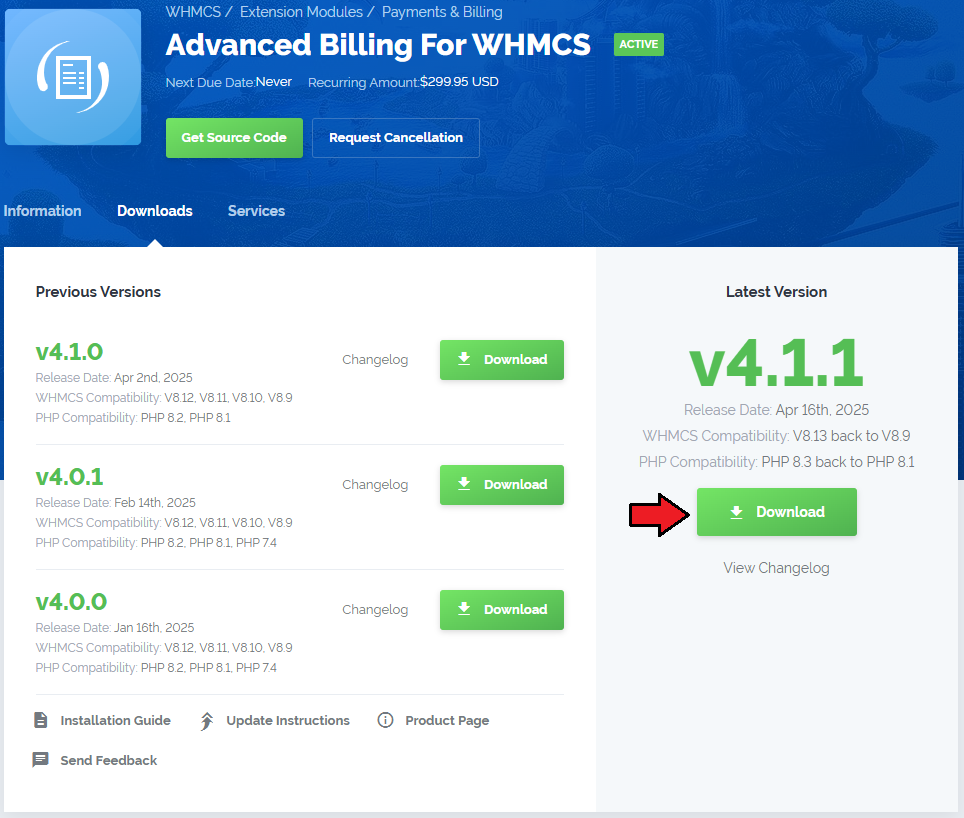
|
| 2. Extract the package and upload its content into the main WHMCS directory.
The content of the package to upload should look like this. |
| 3. When you install Advanced Billing For WHMCS for the first time you have to rename 'license_RENAME.php' file. File is located in 'modules/addons/AdvancedBilling4/license_RENAME.php'. Rename it from 'license_RENAME.php' to 'license.php'. |
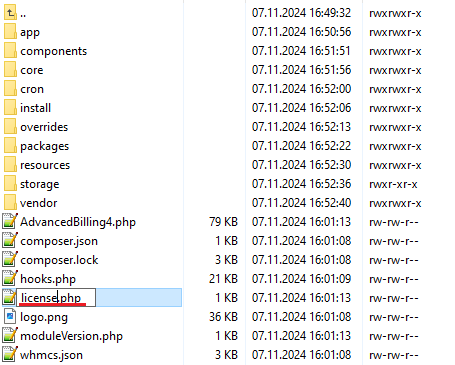
|
| 4. In order to configure your license key, you have to edit a previously renamed 'license.php' file. Enter your license key between the quotation marks as presented on the following screen. You can find your license key in our client area → 'My Products'. |

|
| 5. Now you have to activate the module in your WHMCS system. Log in to your WHMCS admin area. Click 'System Settings' , then choose 'Addon Modules'. |
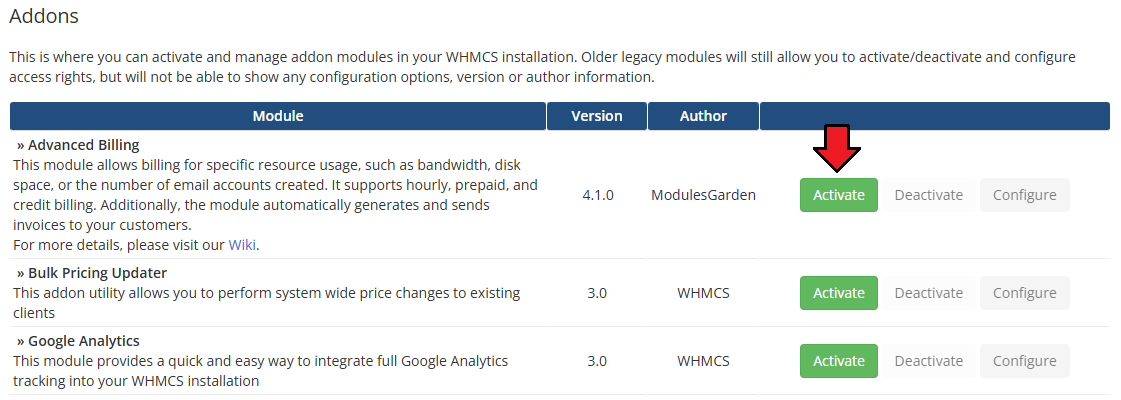
|
| 6. In the next step, you need to permit access to this module. To do so, click on the 'Configure' button, tick the desired admin roles, and press 'Save Changes'. |
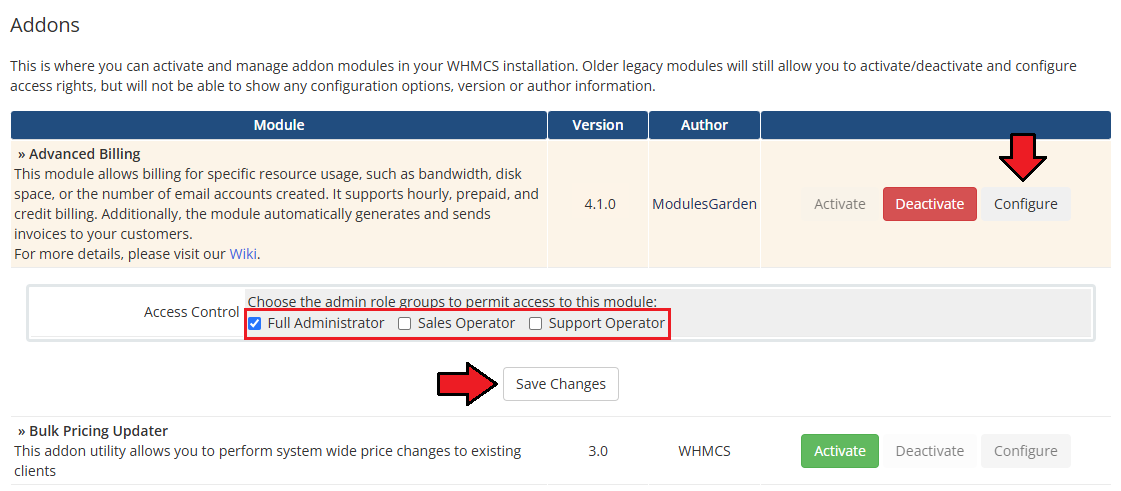
|
| 7. The final step is to configure the cron job. Navigate to: WHMCS → Addons → Advanced Billing → Settings → Cron Job Settings page to obtain the correct cron command. php -q /your_WHMCS/modules/addons/AdvancedBilling4/cron/cron.php cron Note: This cron starts a background, continuous process. The 5-minute interval is a backup mechanism that ensures the process restarts automatically if it stops for any reason. |
[edit] Configuration and Management
| Advanced Billing For WHMCS is a module that allows you to set up flexible billing models based on your client's actual usage of resources like bandwidth and CPU. Refer to the manual below to learn how to configure the module and make full use of its extensive features. |
[edit] Products
| To enable Advanced Billing For WHMCS features for a product, navigate to 'Addons' → 'Advanced Billing' → 'Products' and click on the 'Add Product' button. Select your product from the dropdown list. |
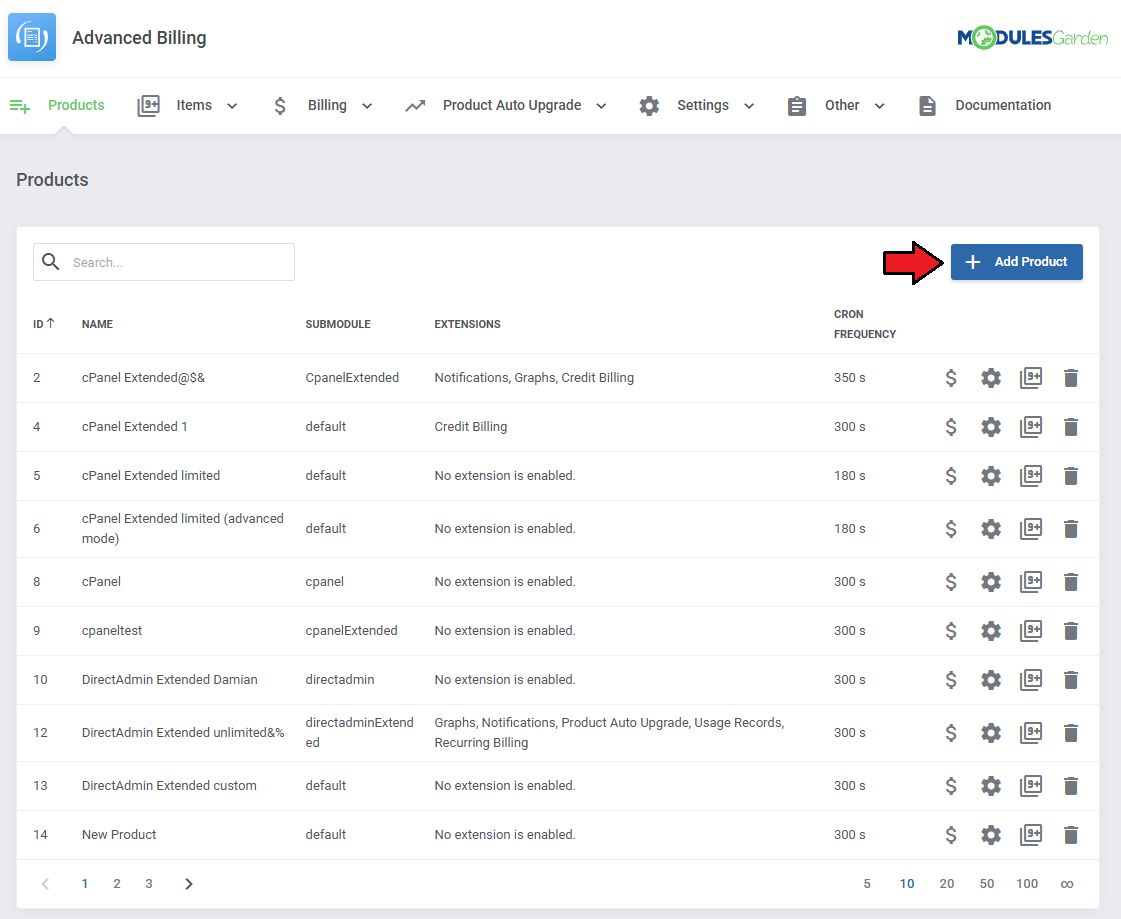
|
Once your products are added use the action buttons to:
|
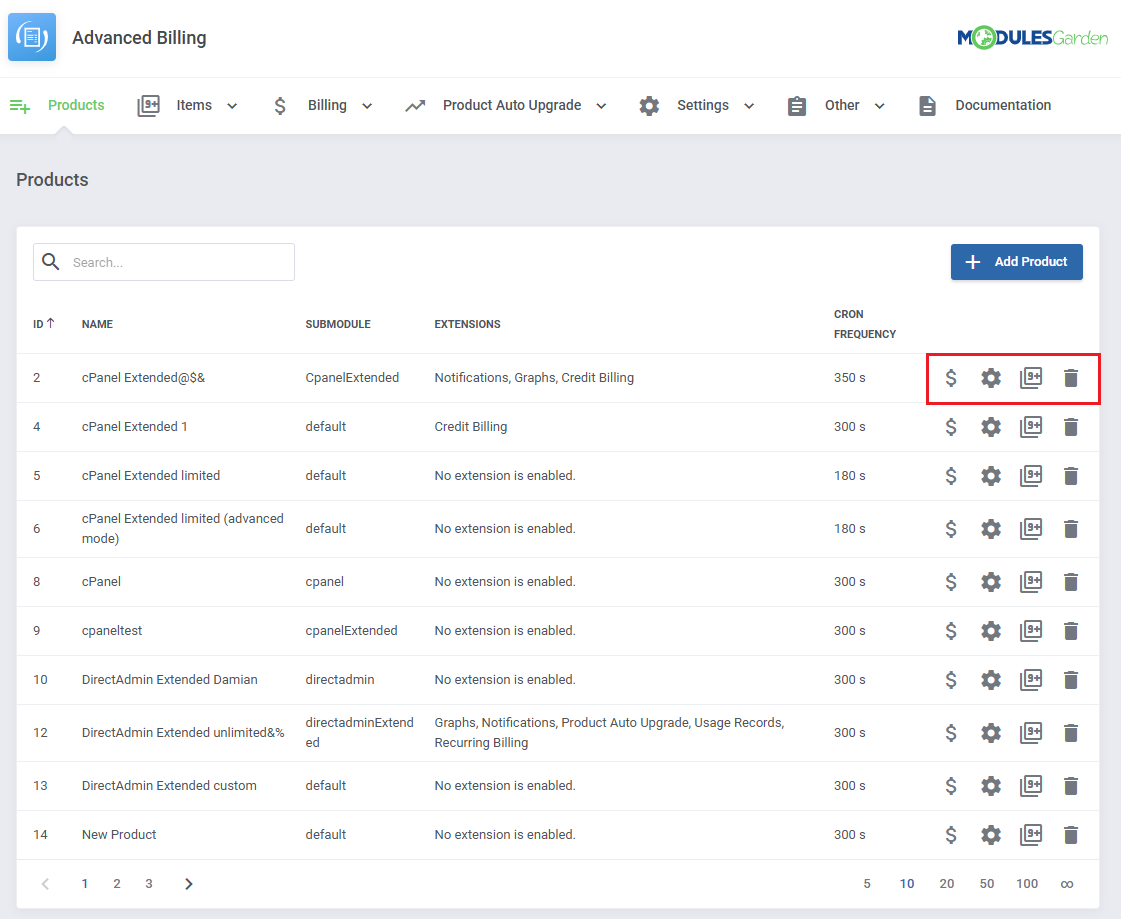
|
[edit] Pricing
| Set pricing for each usage record for a product. The pricing list includes information on each usage record:
Click on the 'Edit' button to set up billing for a usage record. |
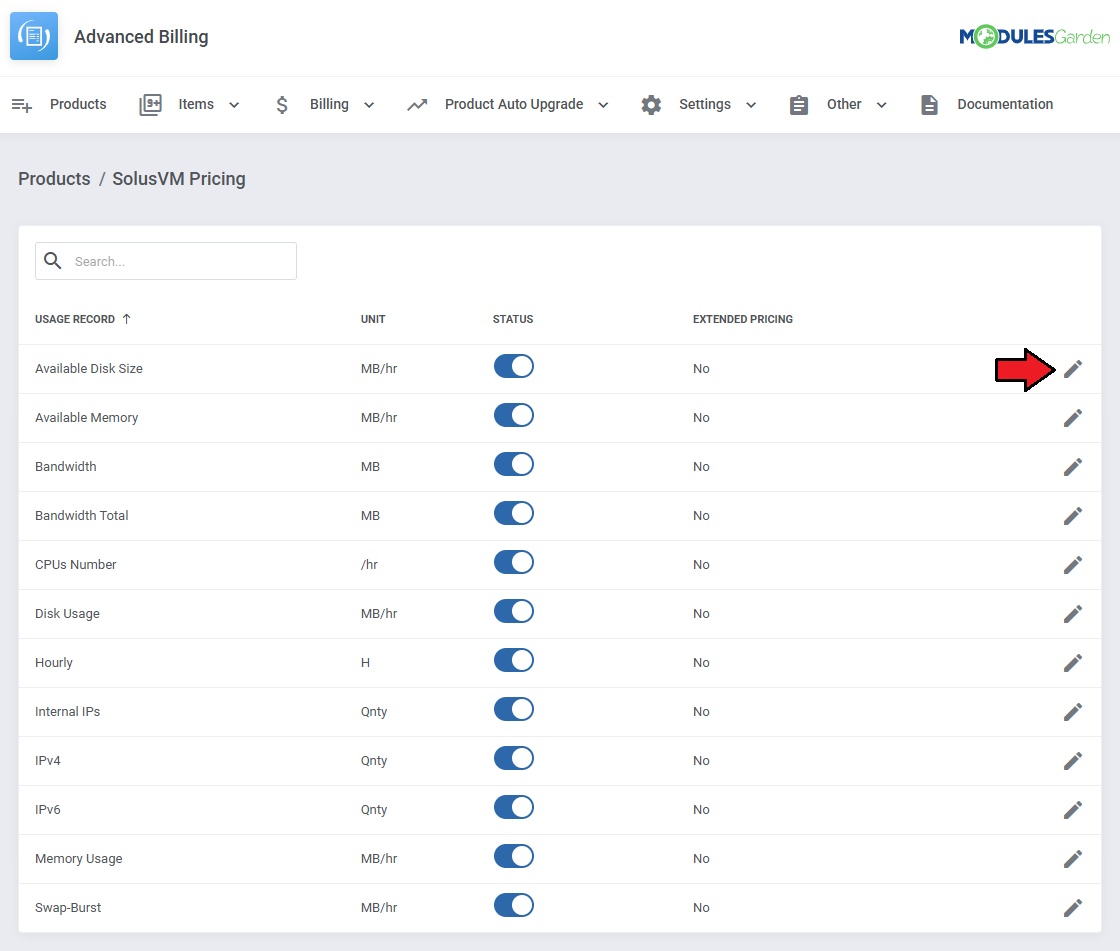
|
Under the general tab you can:
|
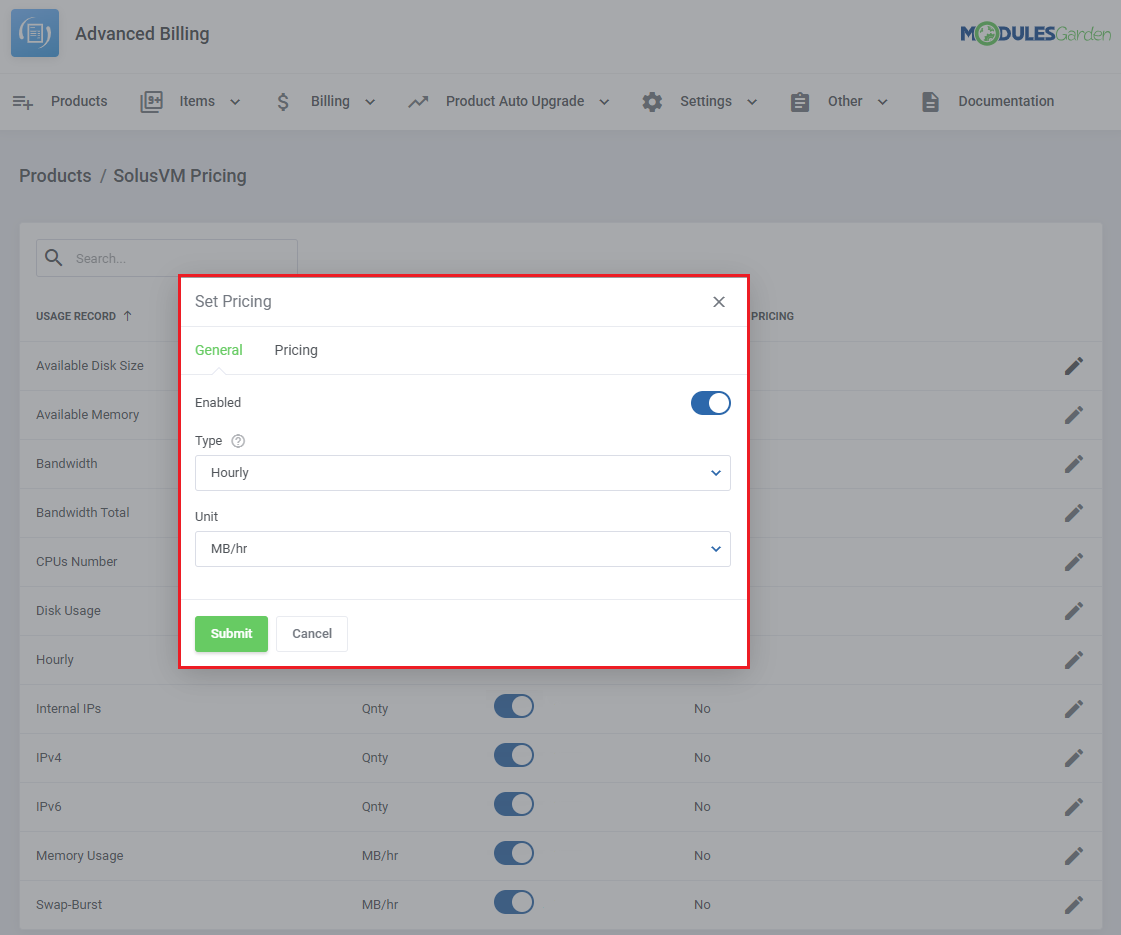
|
The pricing tab is where you set:
|
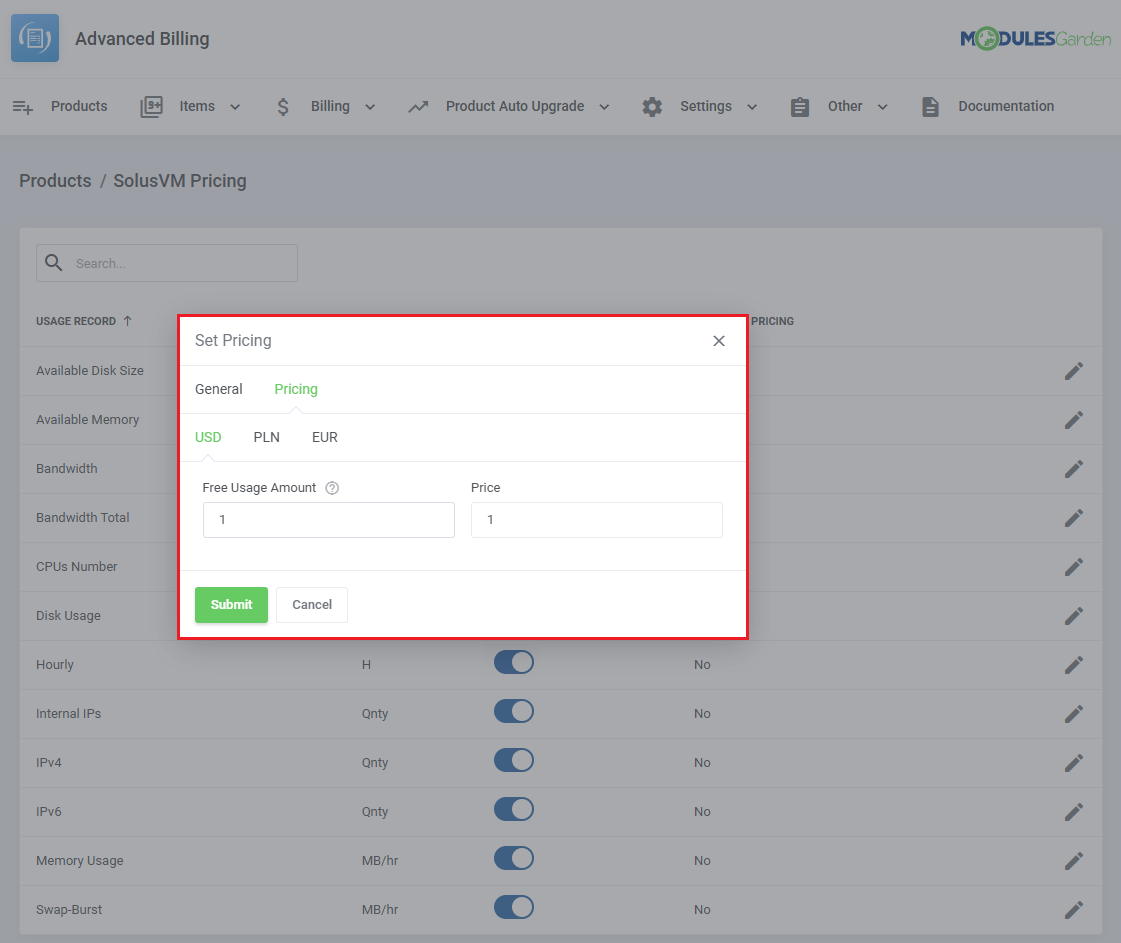
|
[edit] Product Configuration
| The 'Settings' action will take you to the configuration window where you can adjust various features for the product. |
[edit] Product Settings
Set general product settings related to summaries, cron frequency and client area integration.
|
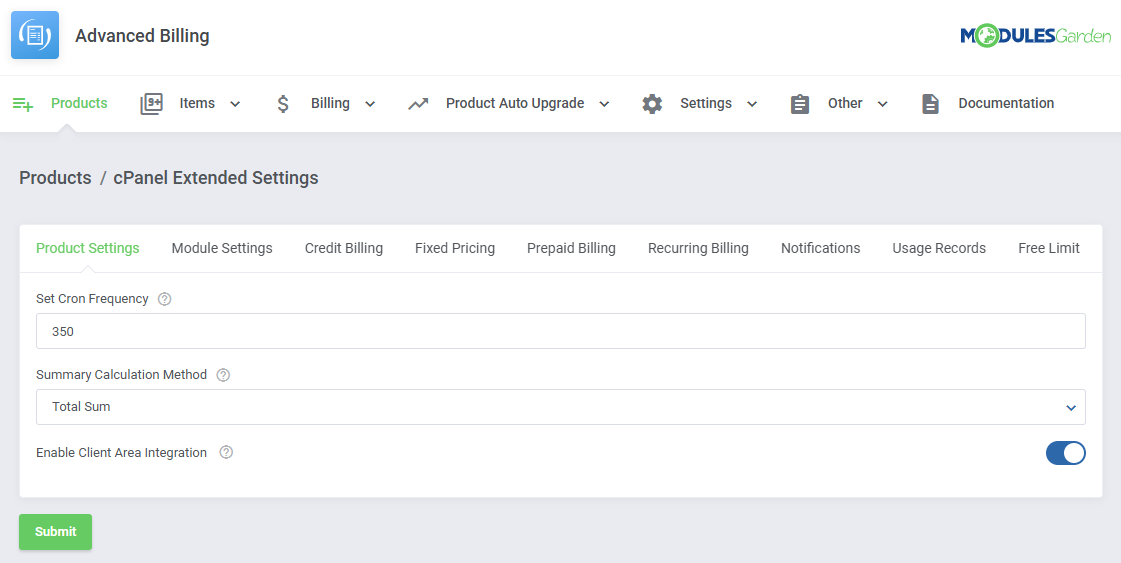
|
[edit] Module Settings
| Configure product module-specific settings such as:
cPanel Extended
Proxmox VE Cloud VPS
OpenStack
and more. |
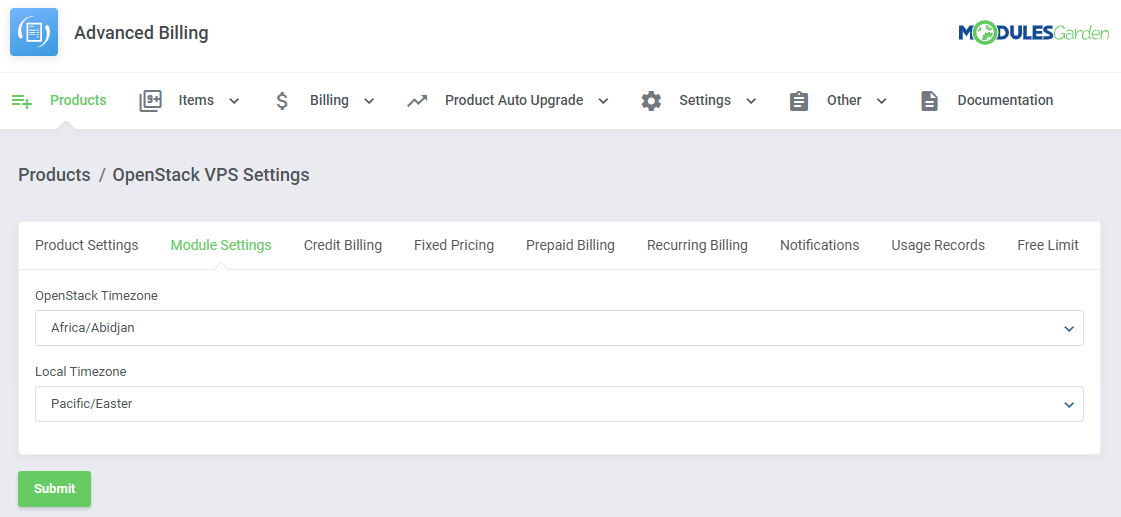
|
[edit] Credit Billing
| Credit Billing allows your clients to be charged with their credits instead of the standard methods. Note: This function is separate from the WHMCS 'Credit Balance'. Enable the functionality with the 'Enable Credit Billing' toggle and configure the details:
|
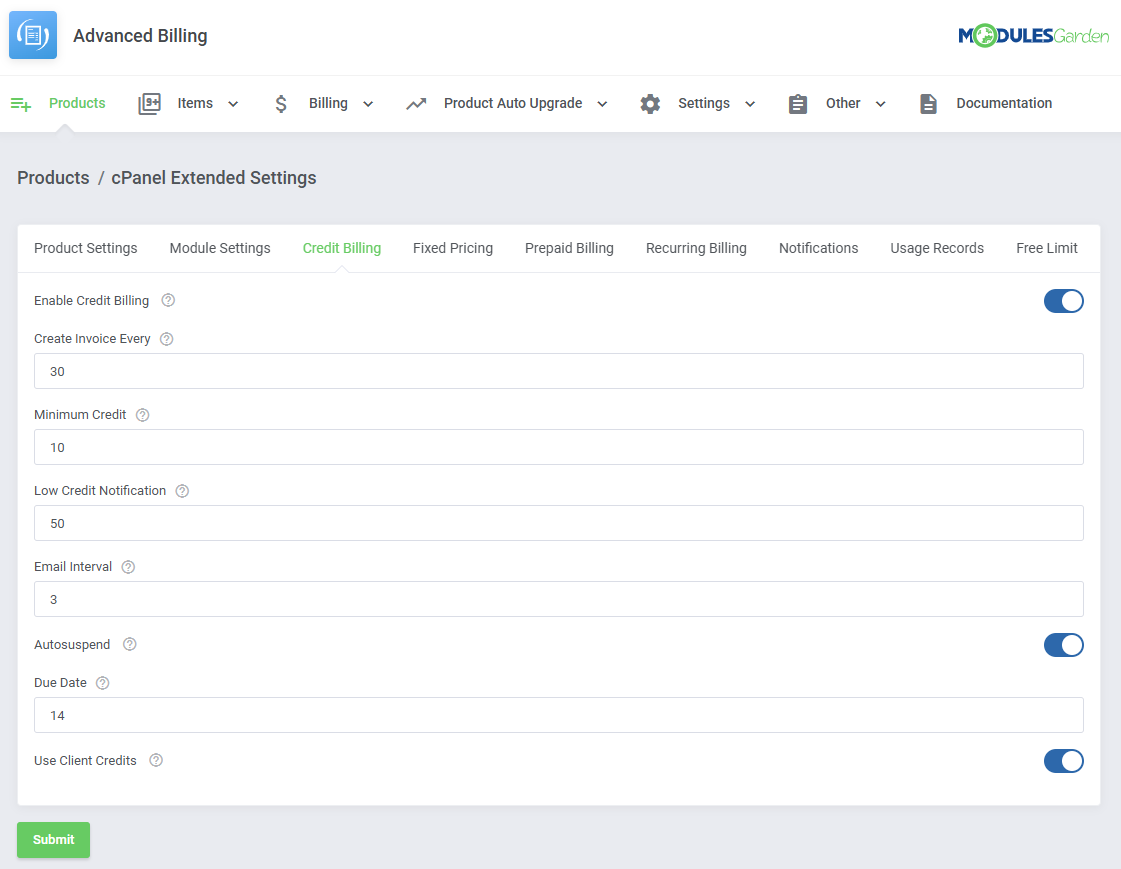
|
[edit] Fixed Pricing
| Fixed Billing charges clients a set amount after a specified number of hours of active service usage. This feature lets you define a fixed price per product, billed automatically once the usage threshold is reached.
|
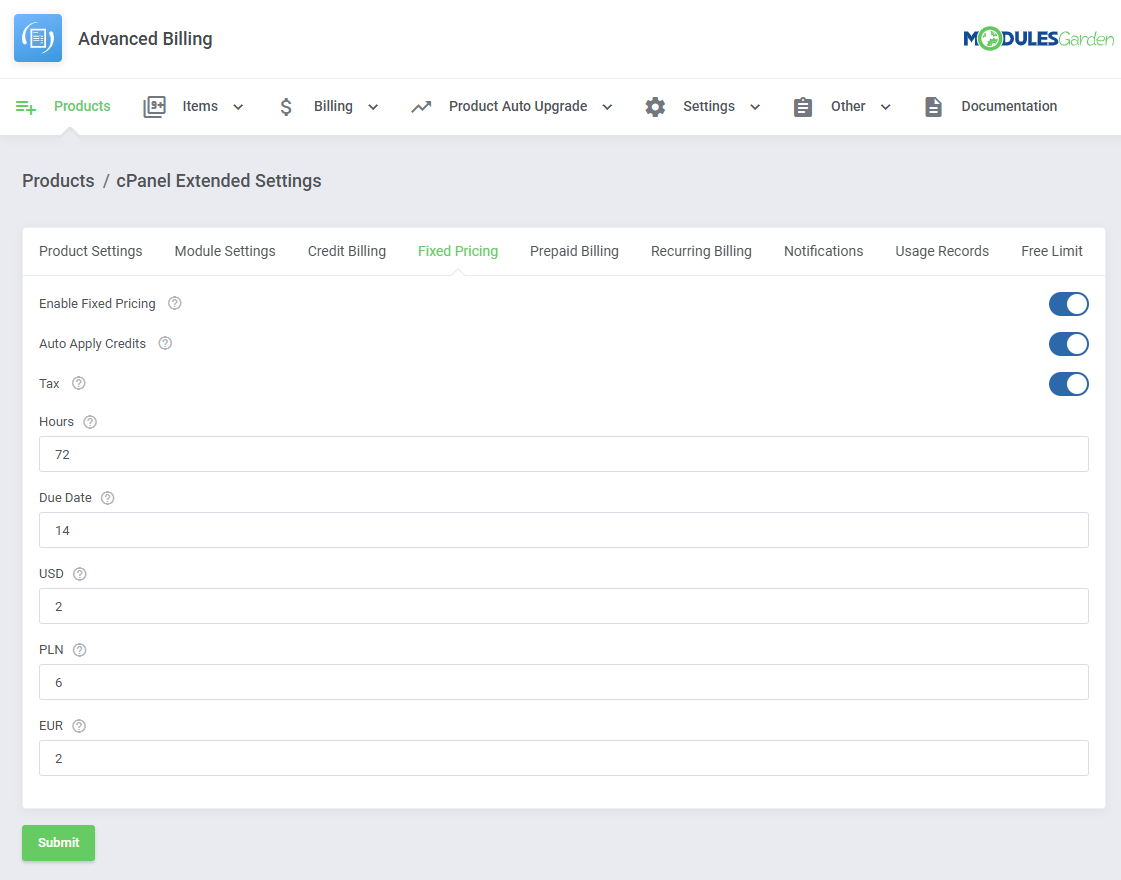
|
[edit] Prepaid Billing
| Prepaid Billing enables charging clients directly from their prepaid credit balance. It also provides summary billing, combining charges into a single summary instead of generating separate invoices.
|
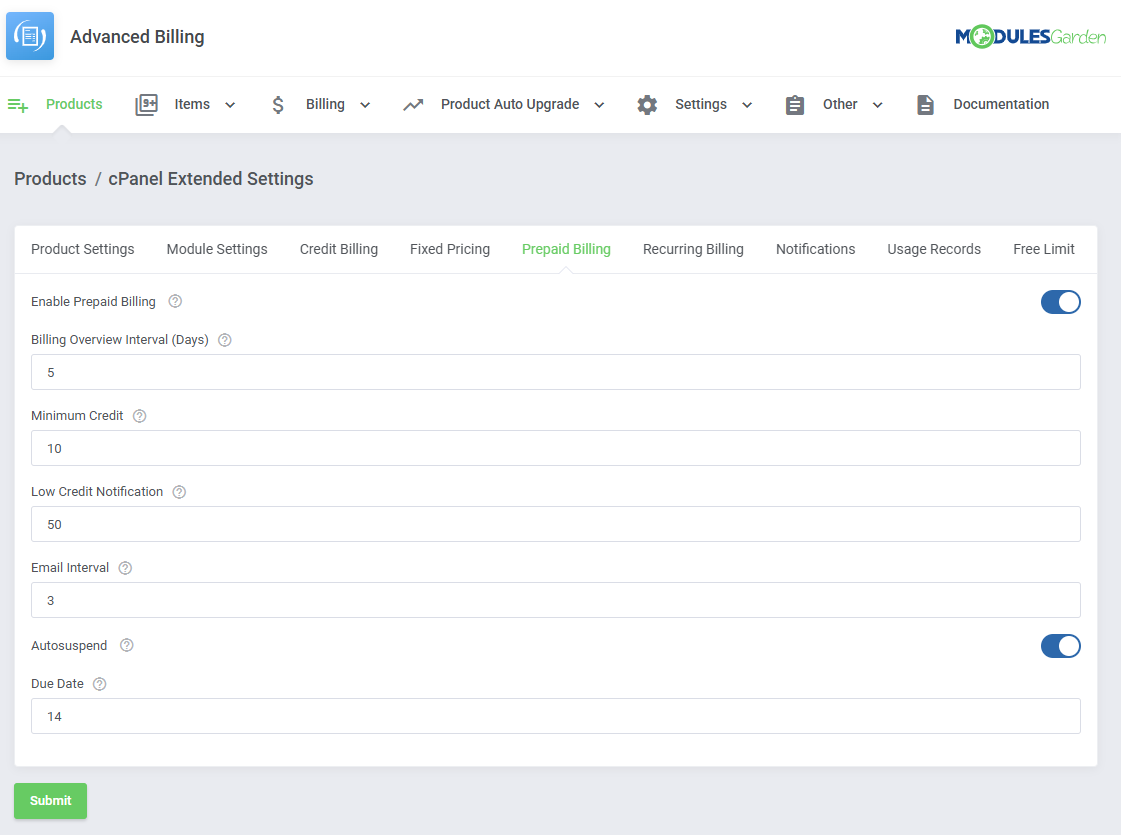
|
| The client area will include the summations and a way for the client to top up his credit balance. After the client indicates the amount of credits to be added to his account, an invoice will be generated for it. |
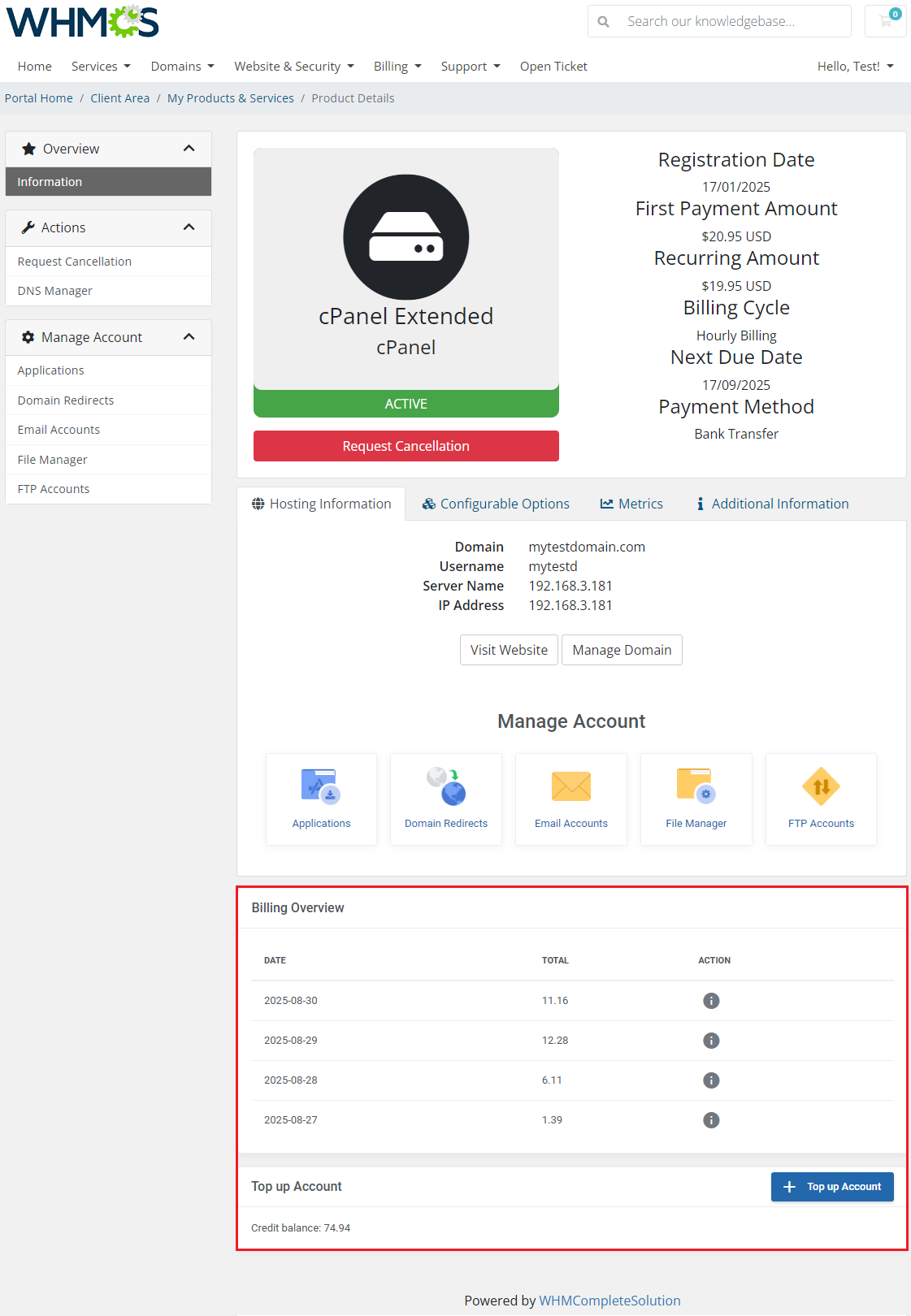
|
[edit] Recurring Billing
| Recurring Billing automatically charges clients on a regular schedule for their products. This feature simplifies ongoing payments by setting up recurring billing cycles.
|
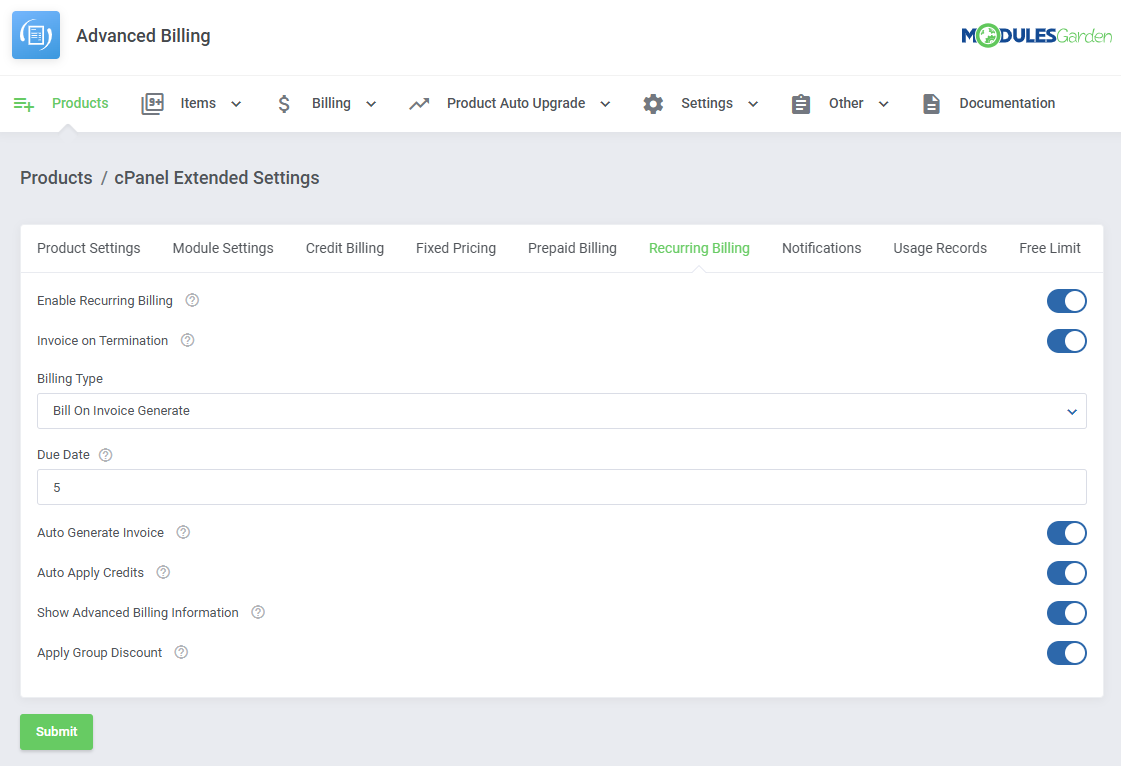
|
[edit] Notifications
| Notifications allow clients to set up email reminders that are sent when their resource usage reaches or exceeds specified limits. This feature helps clients stay informed about their usage and avoid unexpected charges.
|
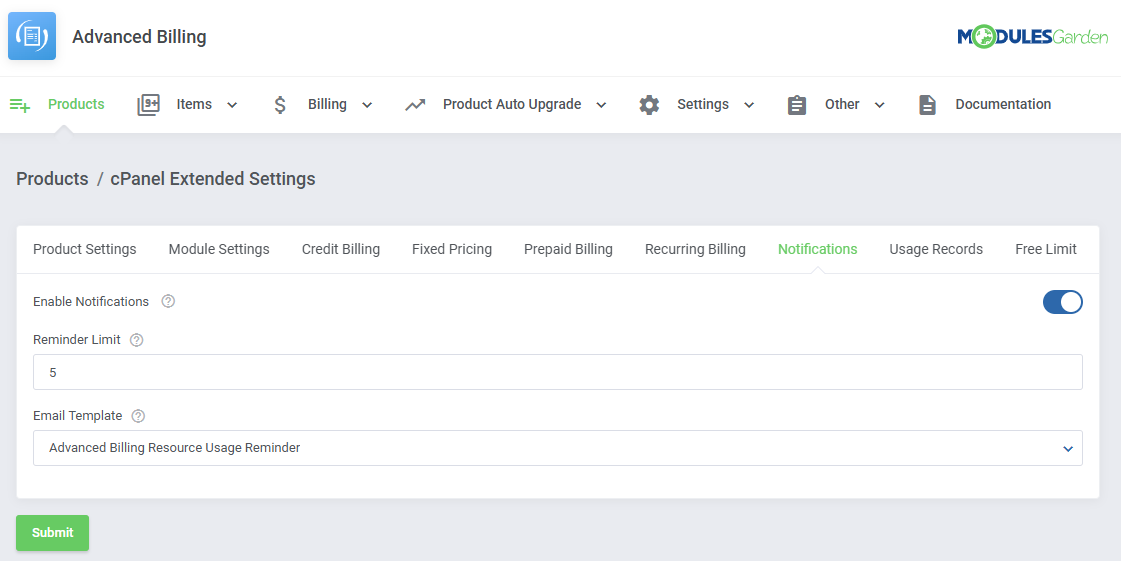
|
The predefined 'Advanced Billing Resource Usage Reminder' features variables that you can also use in your own templates:
|
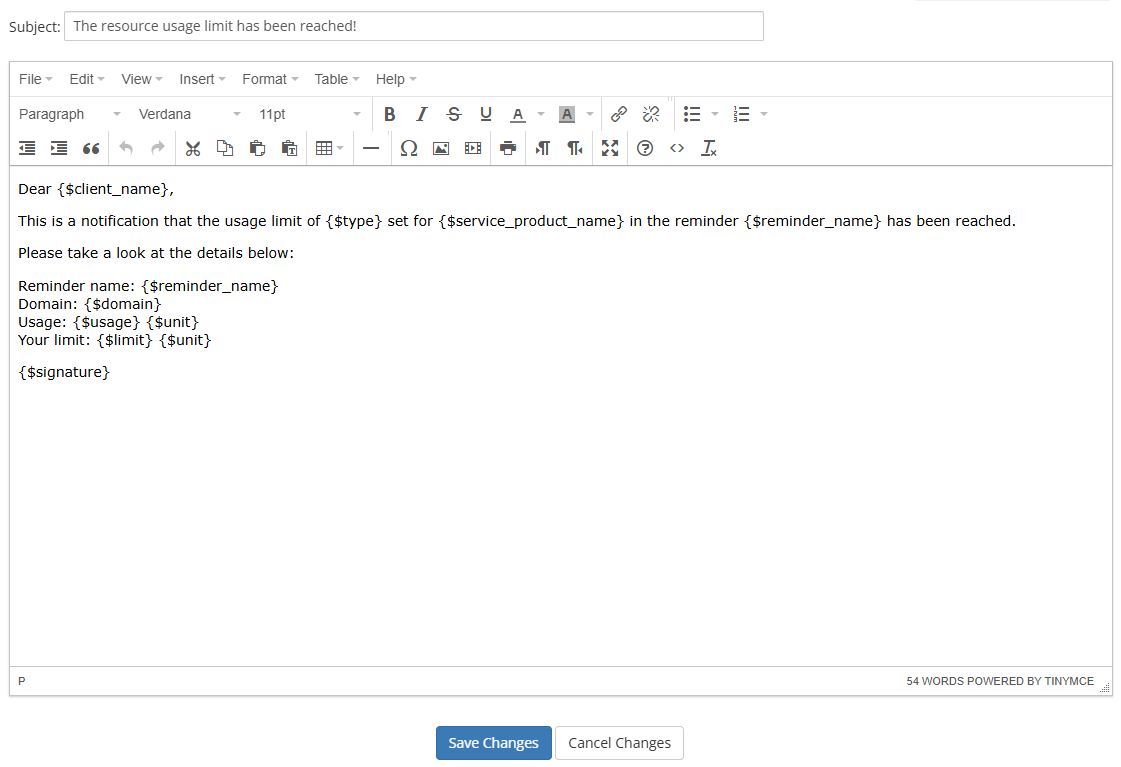
|
| Once the function is enabled, clients will see the 'Reminders' table where they can add and manage their notifications. To add a new notification click on the 'Add Reminder' button. |
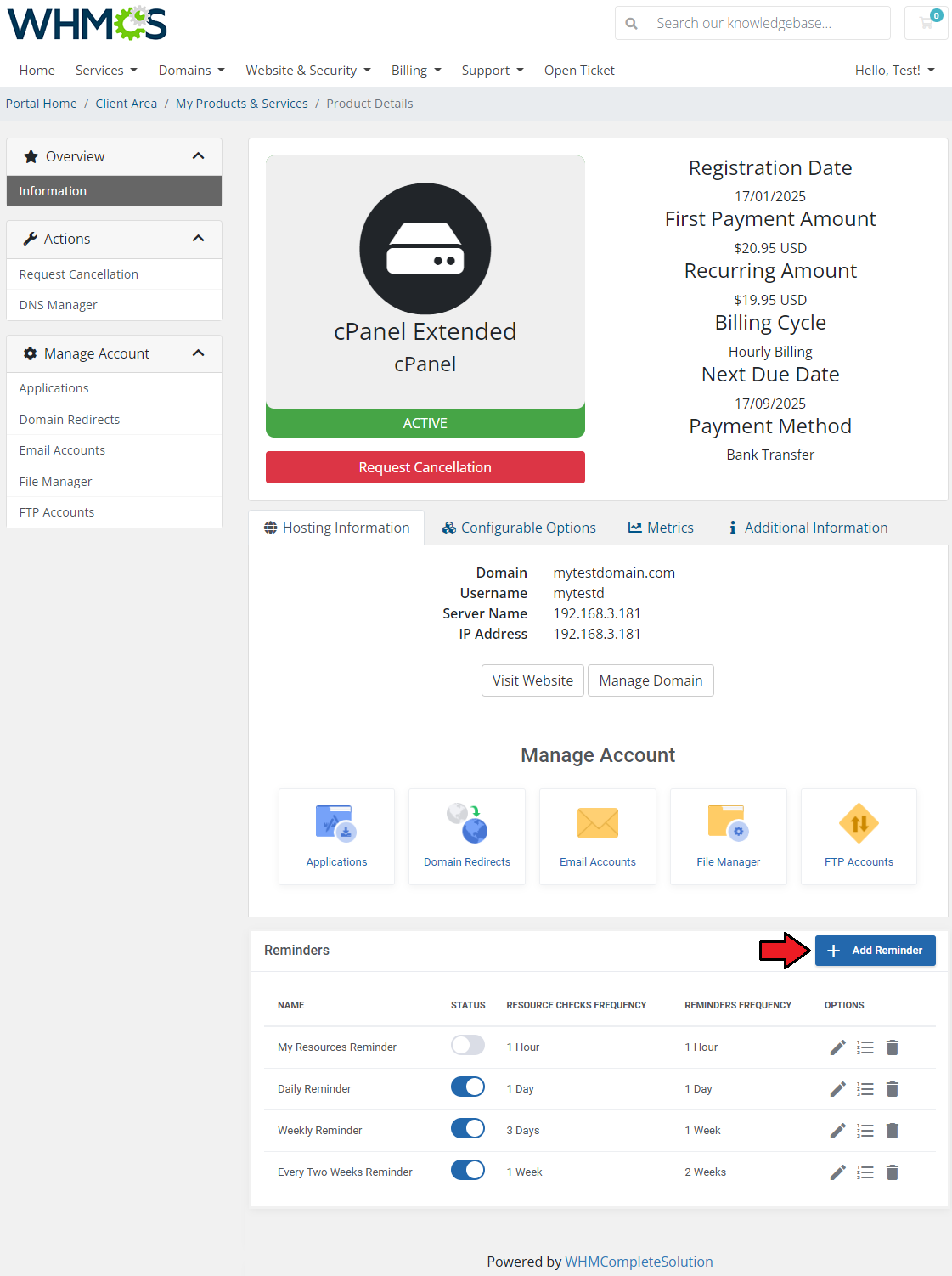
|
Provide the following:
|
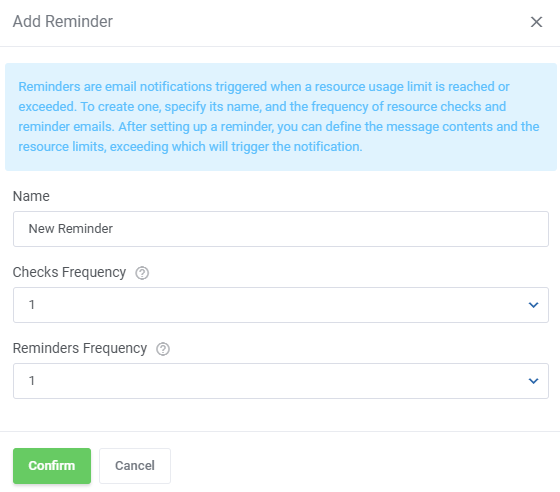
|
Once the reminder is added, it can be managed using the action buttons:
|
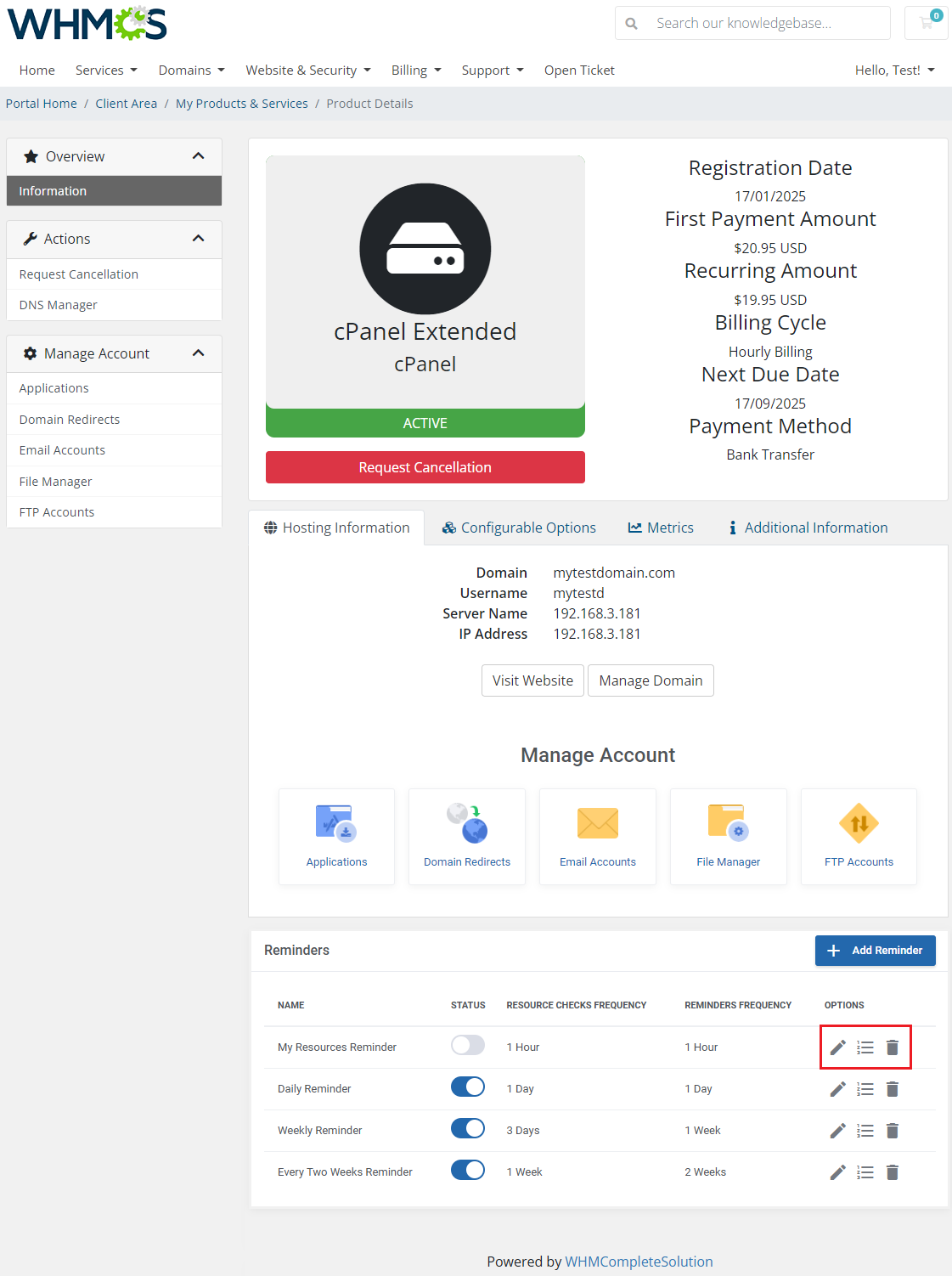
|
| While defining the limits, you can scroll the list of resources horizontally. The fields for each include:
For example, we can set the reminder to be sent after the bandwidth is 'is more' than 20000MB, as shown on the screen below. |
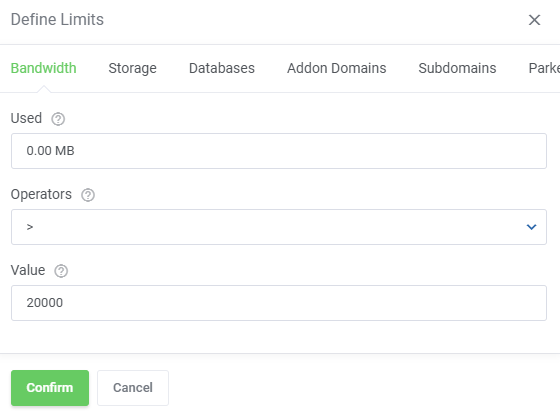
|
| Make sure to enable the reminder after the limits are defined for it. |
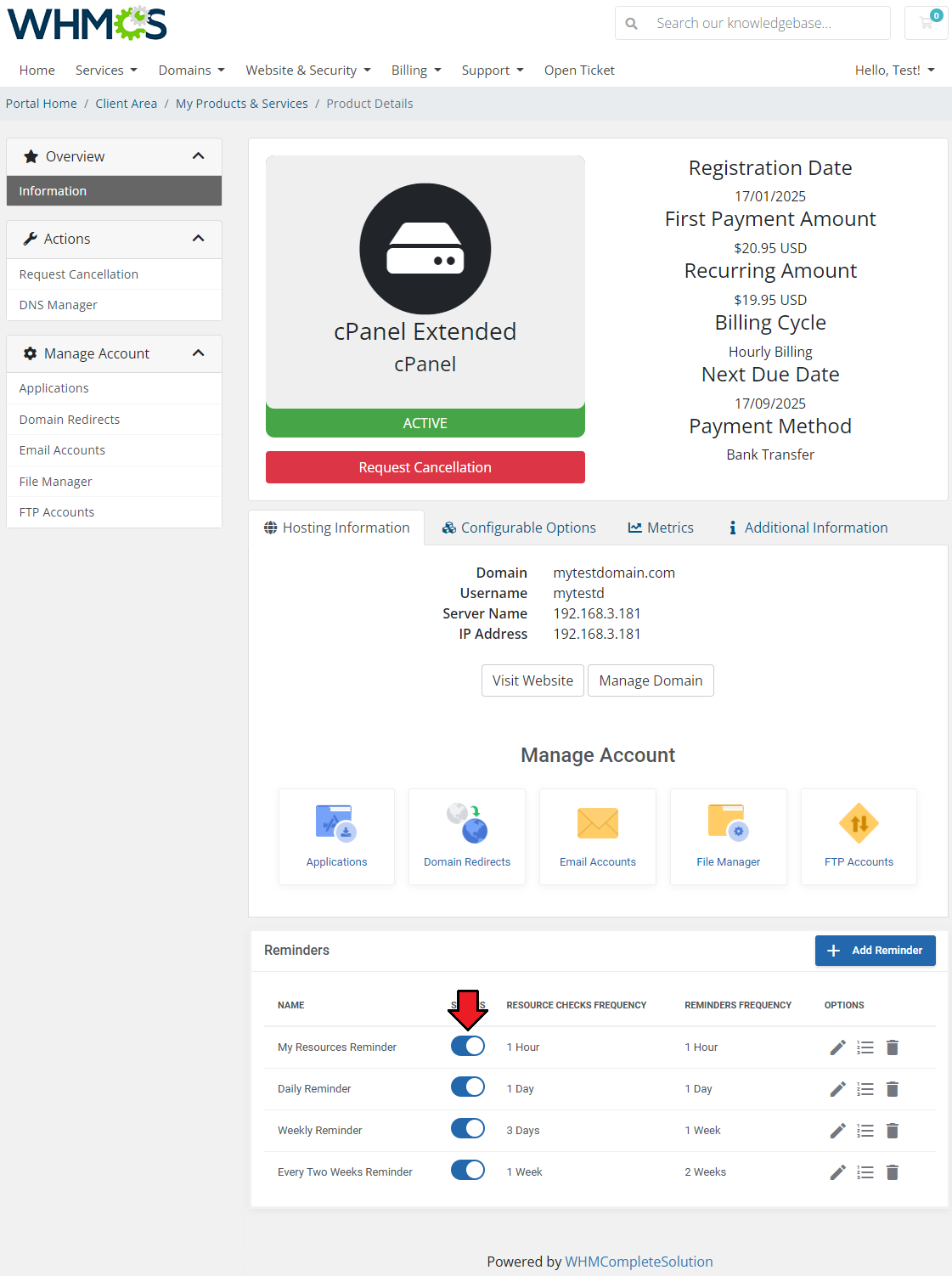
|
[edit] Usage Records
| Usage Records displays clients' resource usage data and usage history directly on the product page in the client area. This feature allows clients to easily track their resource consumption over time.
|
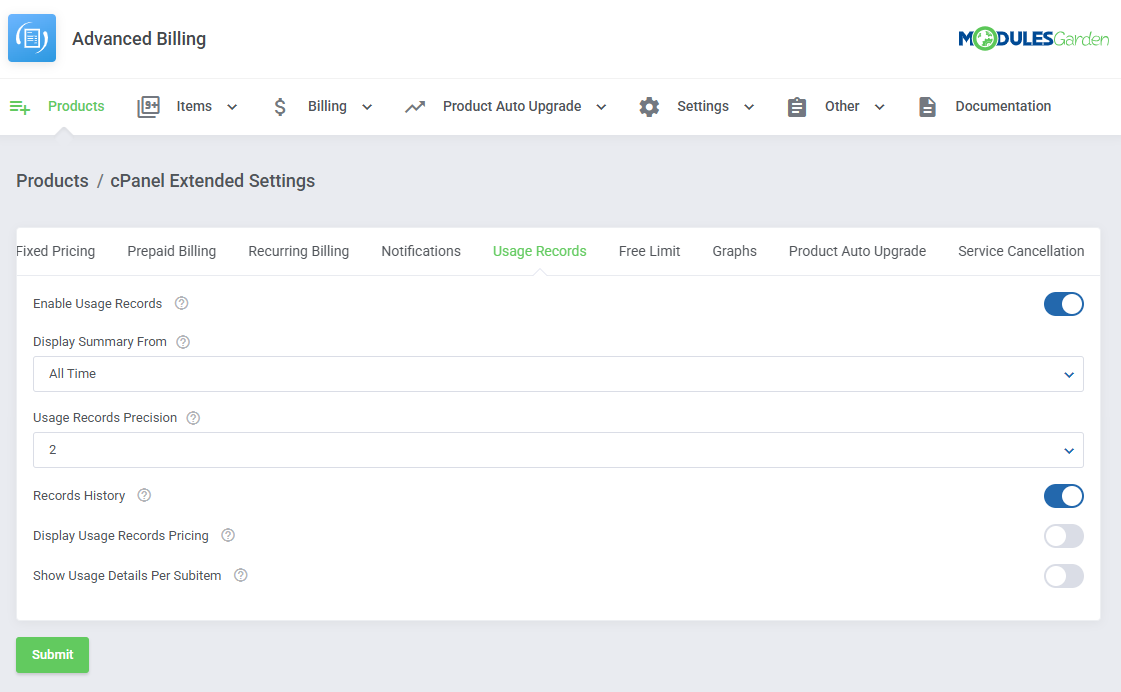
|
| Enabling the extension will display the current usage in the client area. Enabling the 'Records History' function will also display usage from previous periods. |
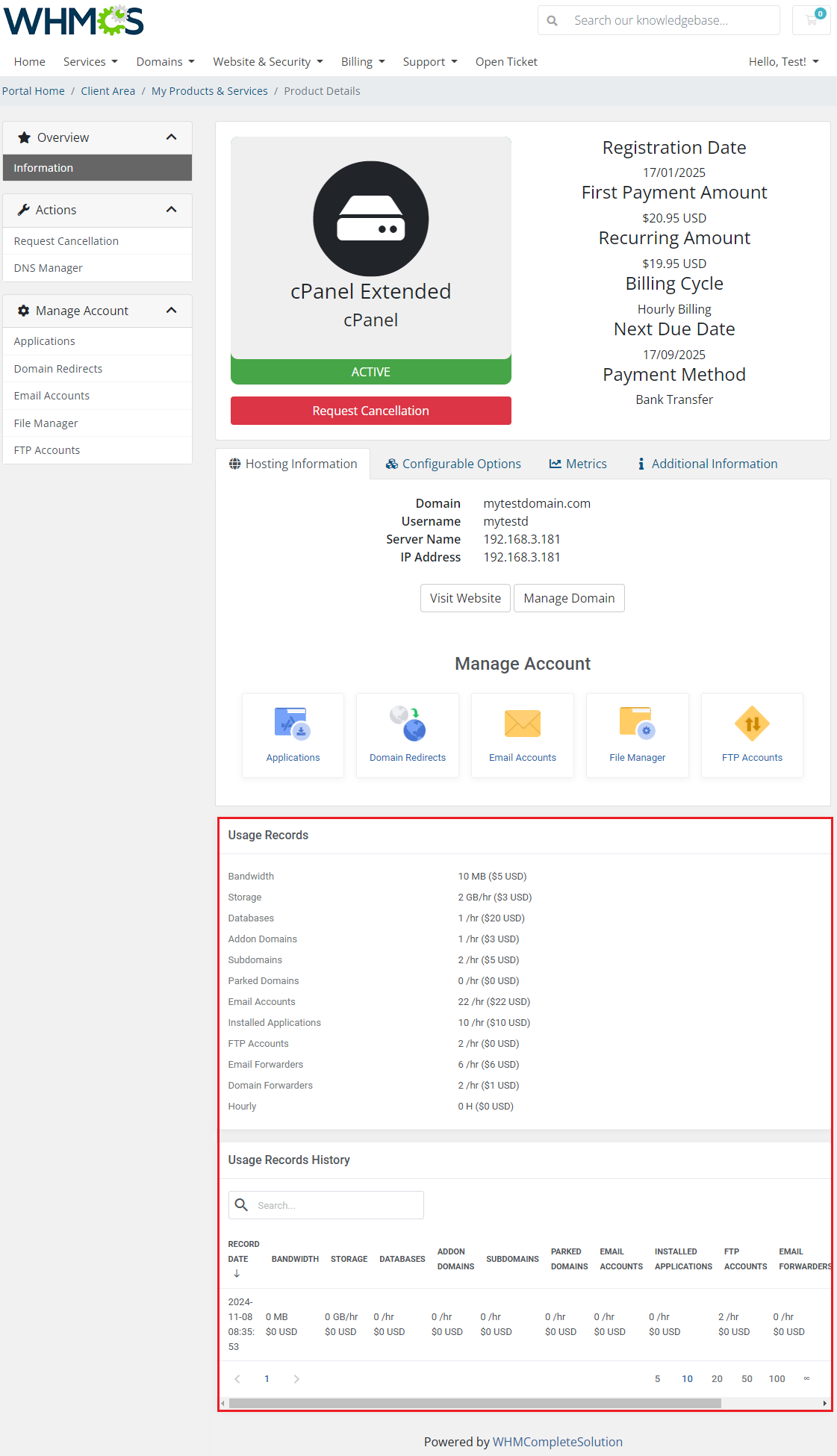
|
| The 'Display Usage Records Pricing' will display the pricing table when clients prepare thier order. |
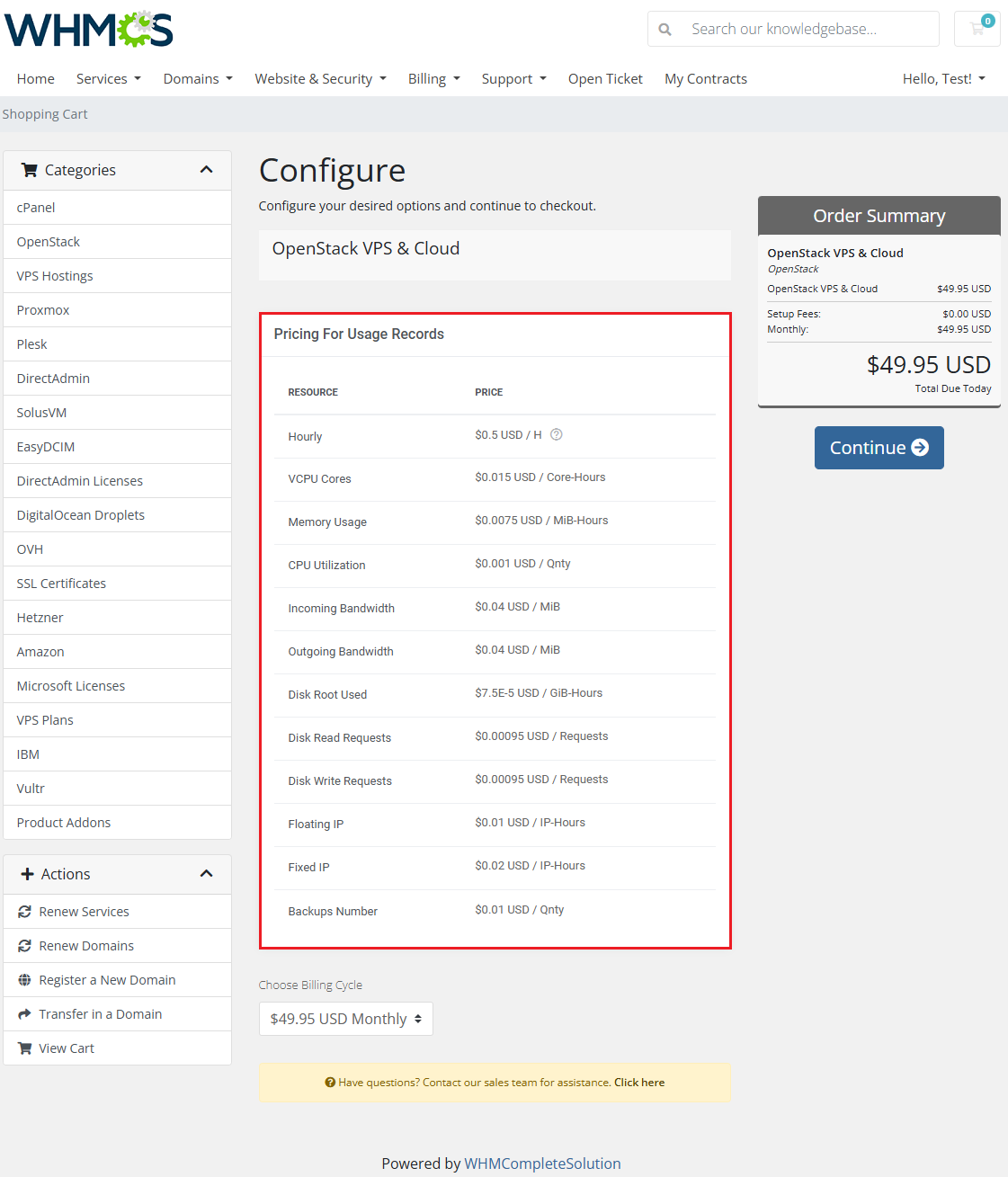
|
| The 'Show Usage Details Per Subitem' will display detailed usage history for subitems in cloud services. Additional usage details will be listed in the Usage Details Per Subitems on the service page in the client area. Note: The screen below is taken from the Proxmox VE Cloud VPS product view, not cPanel Extended, as all other illustrations in this section. |
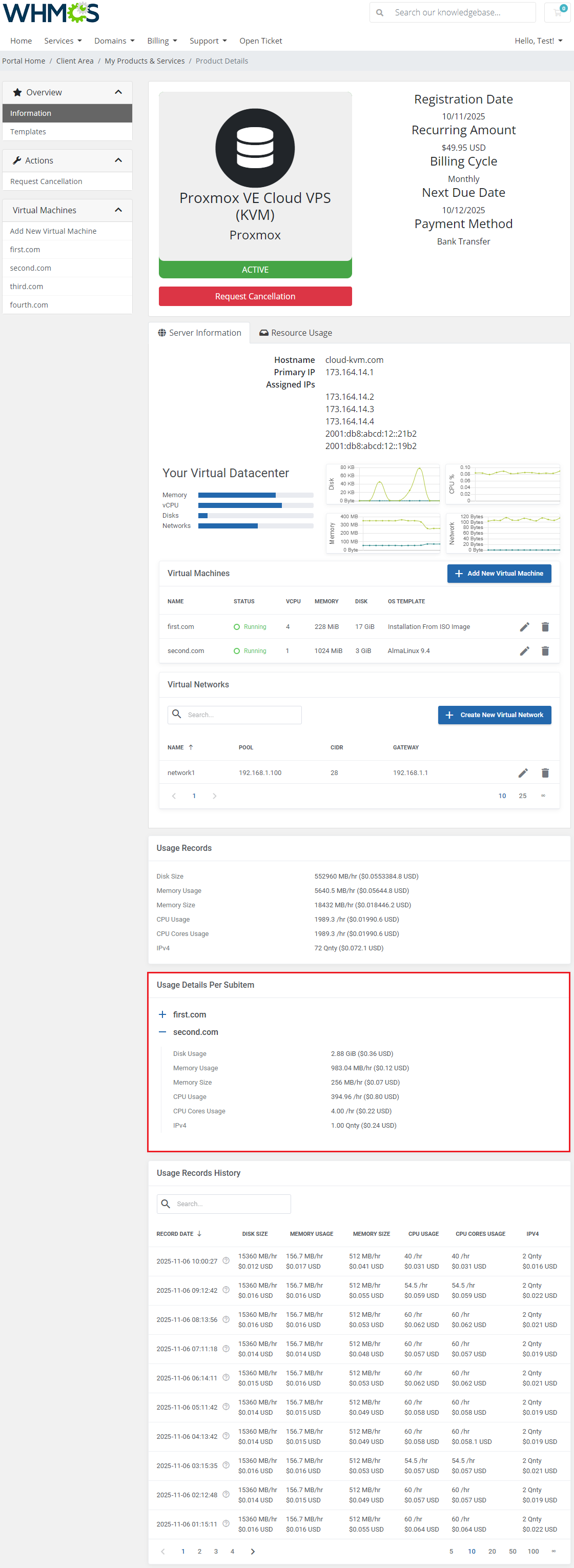
|
[edit] Free Limit
| Free Limit allows you to set free usage limits for a product based on its Configurable Options.
This feature enables precise control over complimentary usage thresholds before charges apply. |
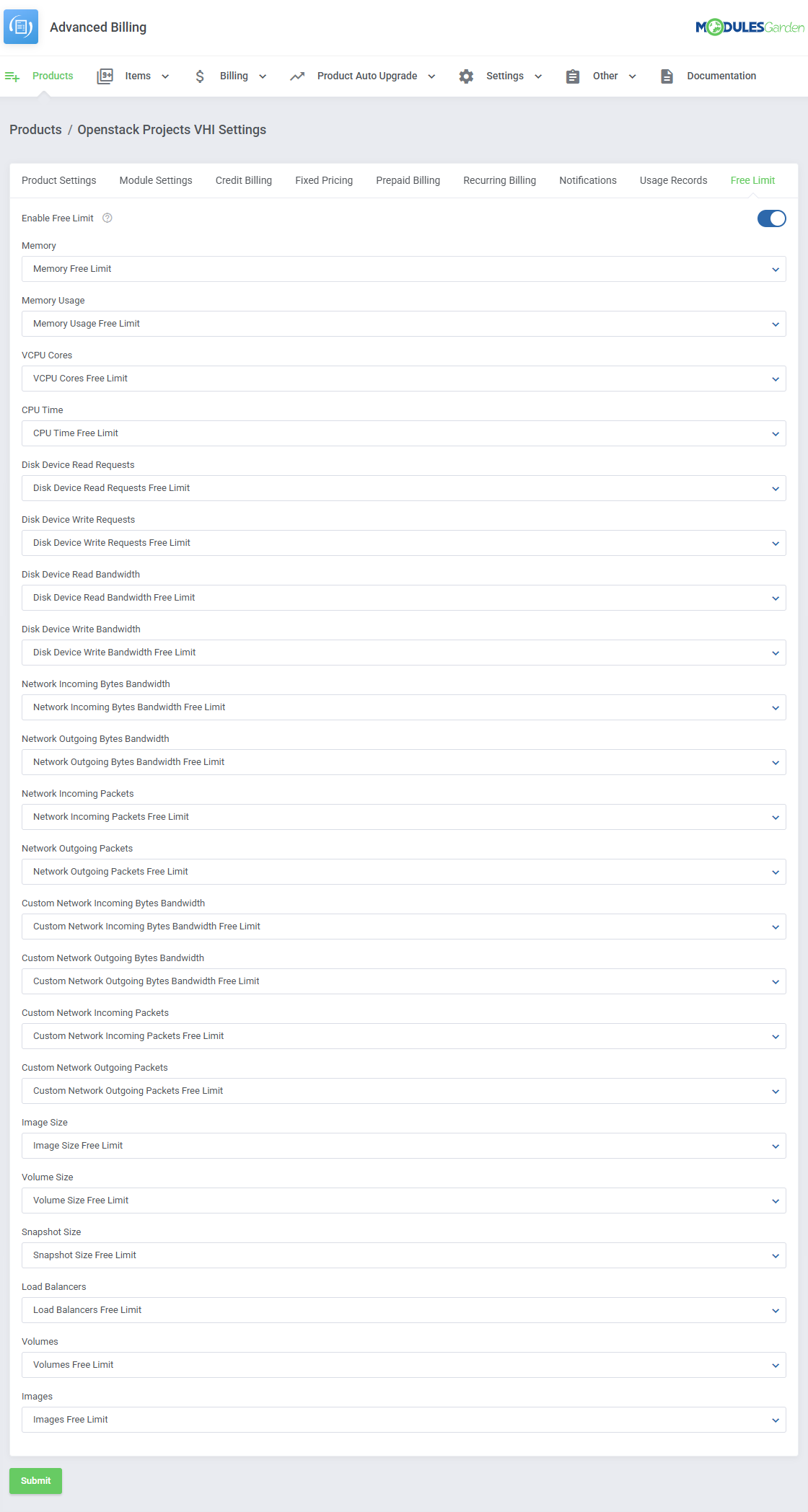
|
[edit] Graphs
| Graphs provide a graphical display of usage records for each configured service. This feature helps visualize resource consumption trends over time. Use the 'Show Enabled Records Only' option to hide records with no pricing enabled. |
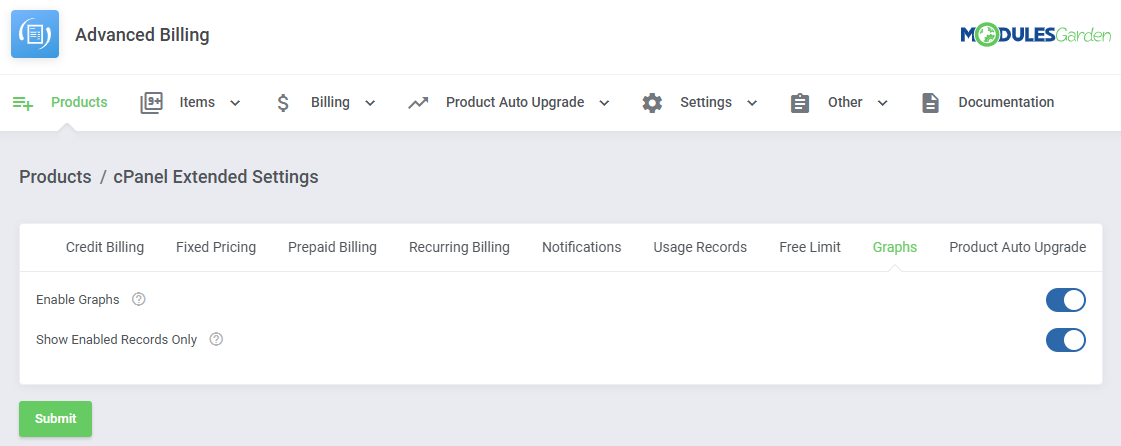
|
| With the functionality enabled, clients will find a graph of their usage displayed in the client area. They will be able to change the graph's scope and resources displayed. |
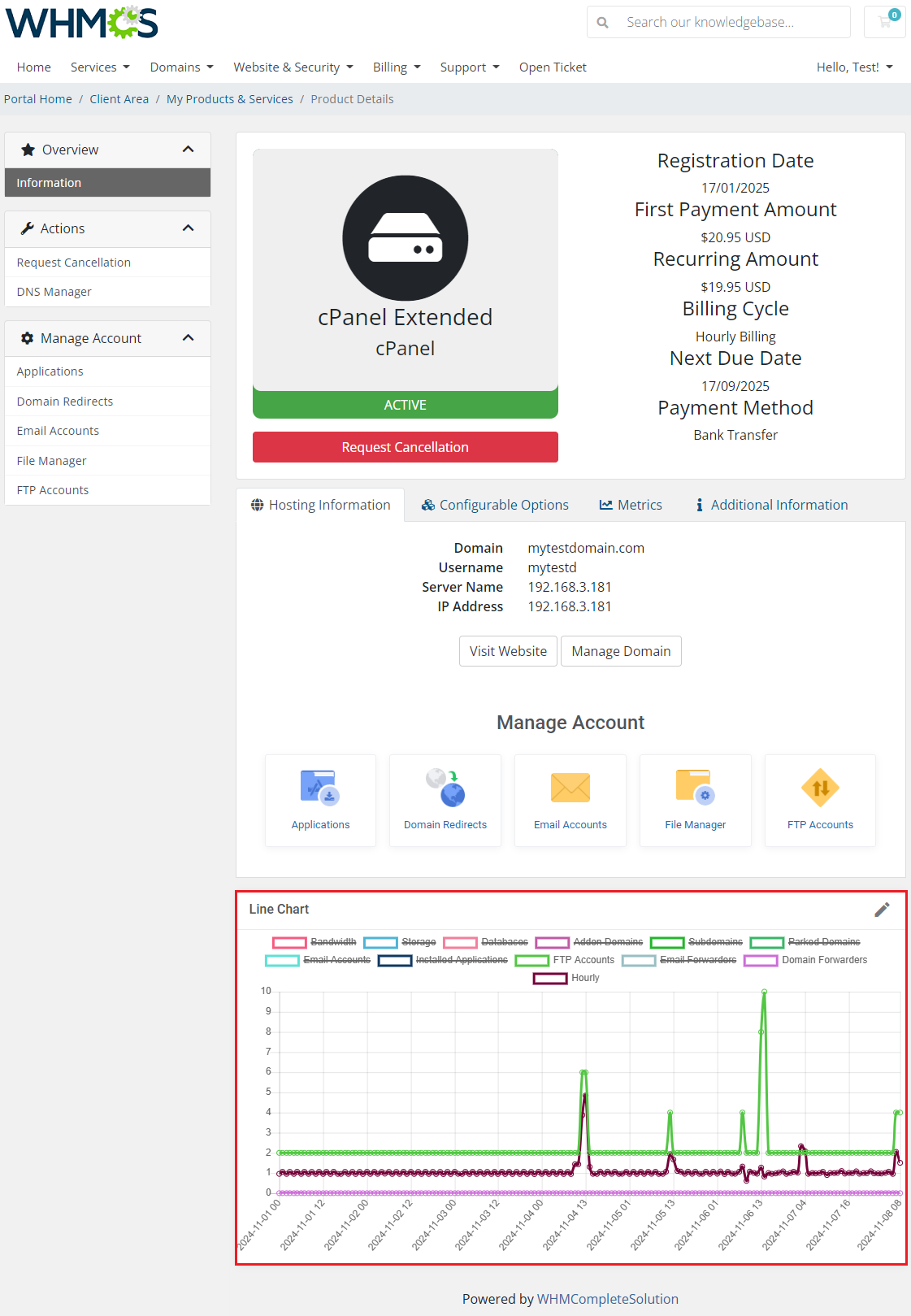
|
[edit] Product Auto Upgrade
| Product Auto Upgrade automatically upgrades or downgrades products based on resource usage, following the rules you set. Clients can choose whether to allow automatic adjustments and can even configure their own rules for product resizing. For more information on available settings, visit the Product Auto Upgrade Management section. |
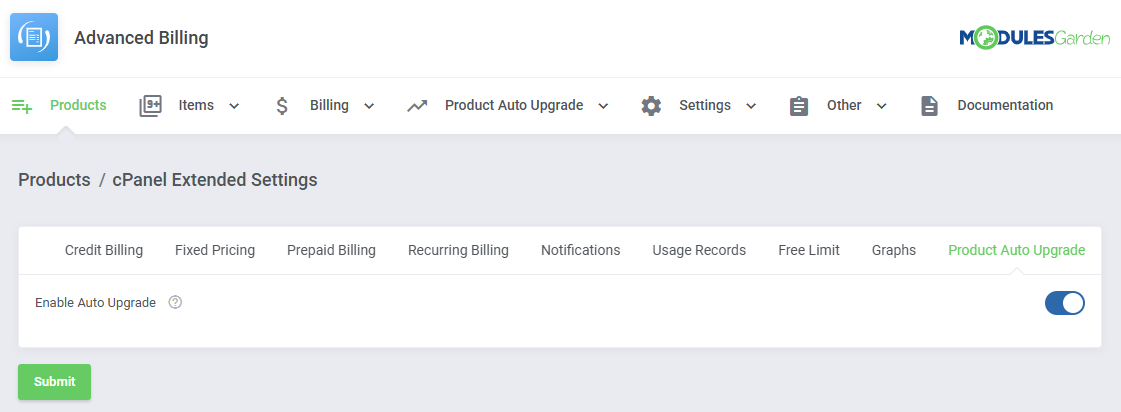
|
Depending on the settings, clients will be able to:
|
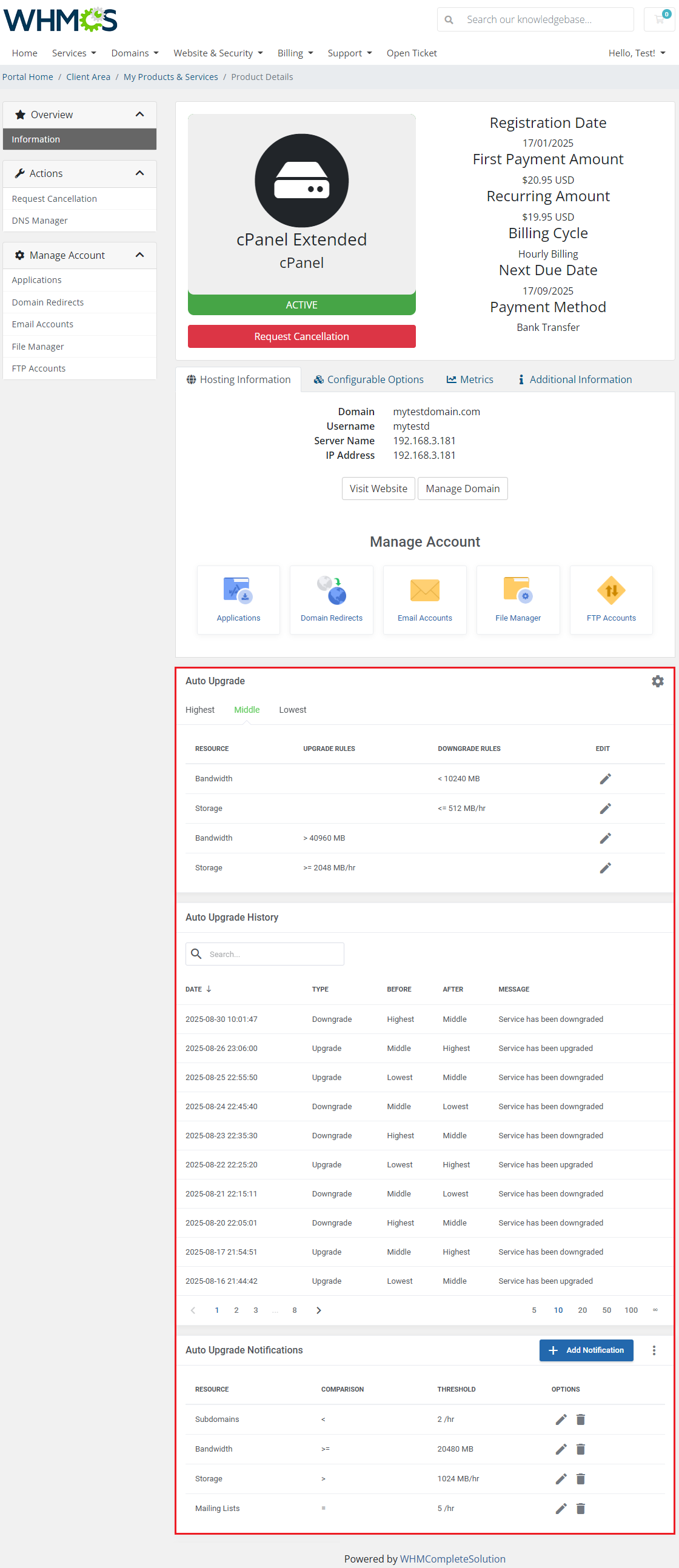
|
[edit] Service Cancellation
| When enabled, this setting allows clients to immediately terminate their service directly from the product page in the client area. The cancellation bypasses the standard queue, and the service is terminated right away. |
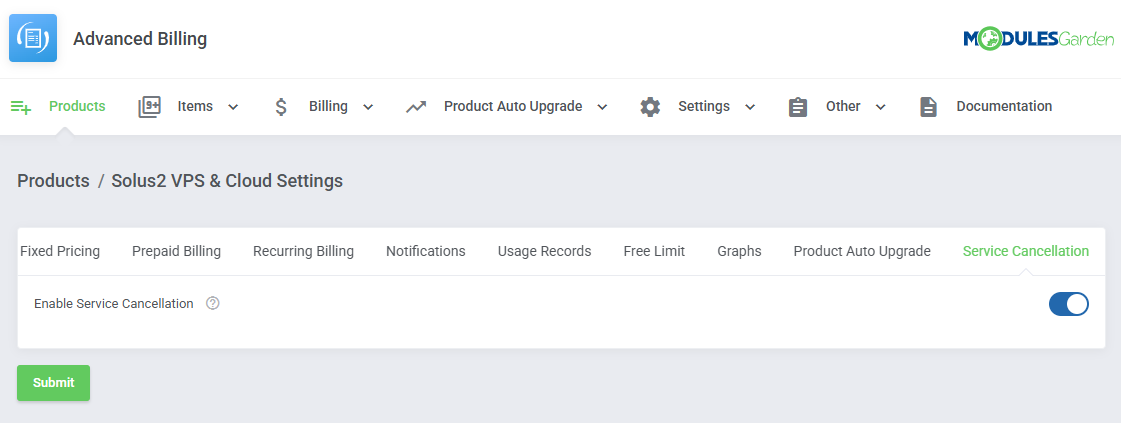
|
| In the client area, an additional box will appear at the very bottom of the product page with a "Cancel Service" button. Clients can click this button, provide a reason for cancellation, and confirm the action. The service will then be terminated immediately. |

|
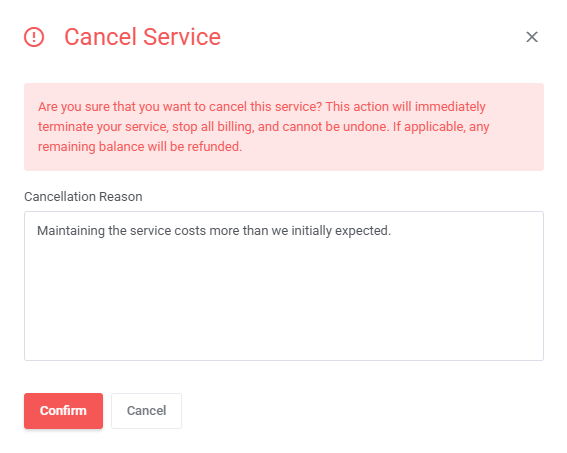
|
[edit] Items
| Items with resource usage counted can be found in the 'Items' section. The 'Item List' includes current billable items, while the 'Item Archive' lists historical items that are already billed. |
[edit] Item List
| You can find the 'Item List' under 'Items'. The list includes information such as:
And action button responsible for:
|
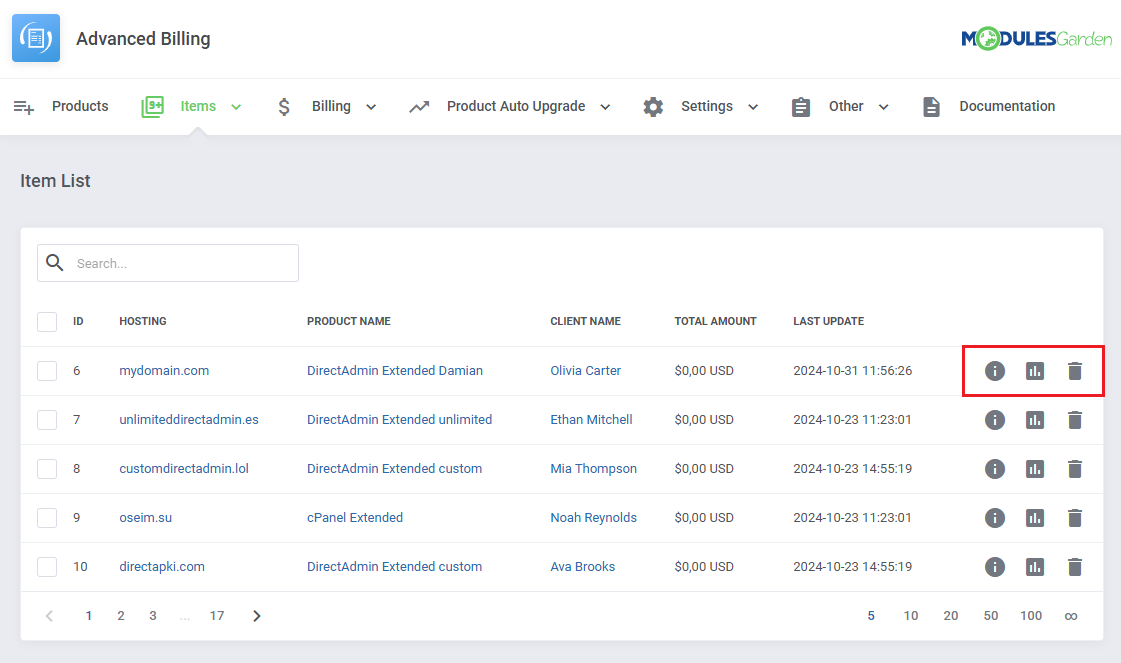
|
| You can mark multiple items with the mass delete function when necessary as well. |
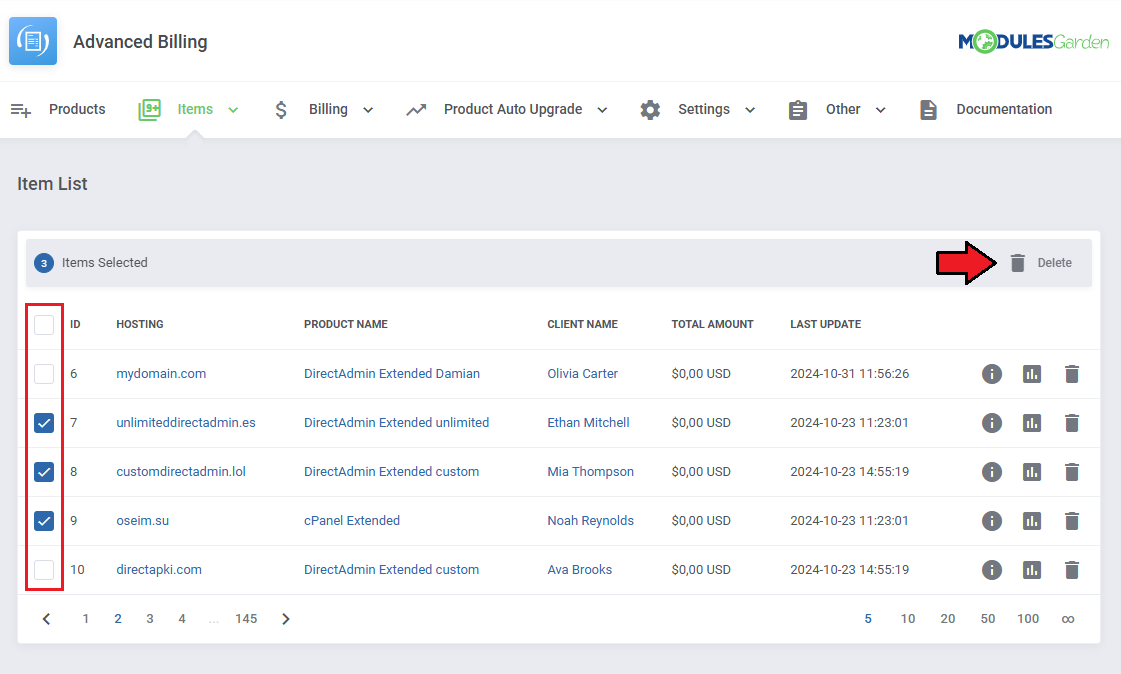
|
| Clicking on the 'View Details' button will display the page with all the usage recorded for Fresh and Houly usage records. The page includes action buttons responsible for:
|
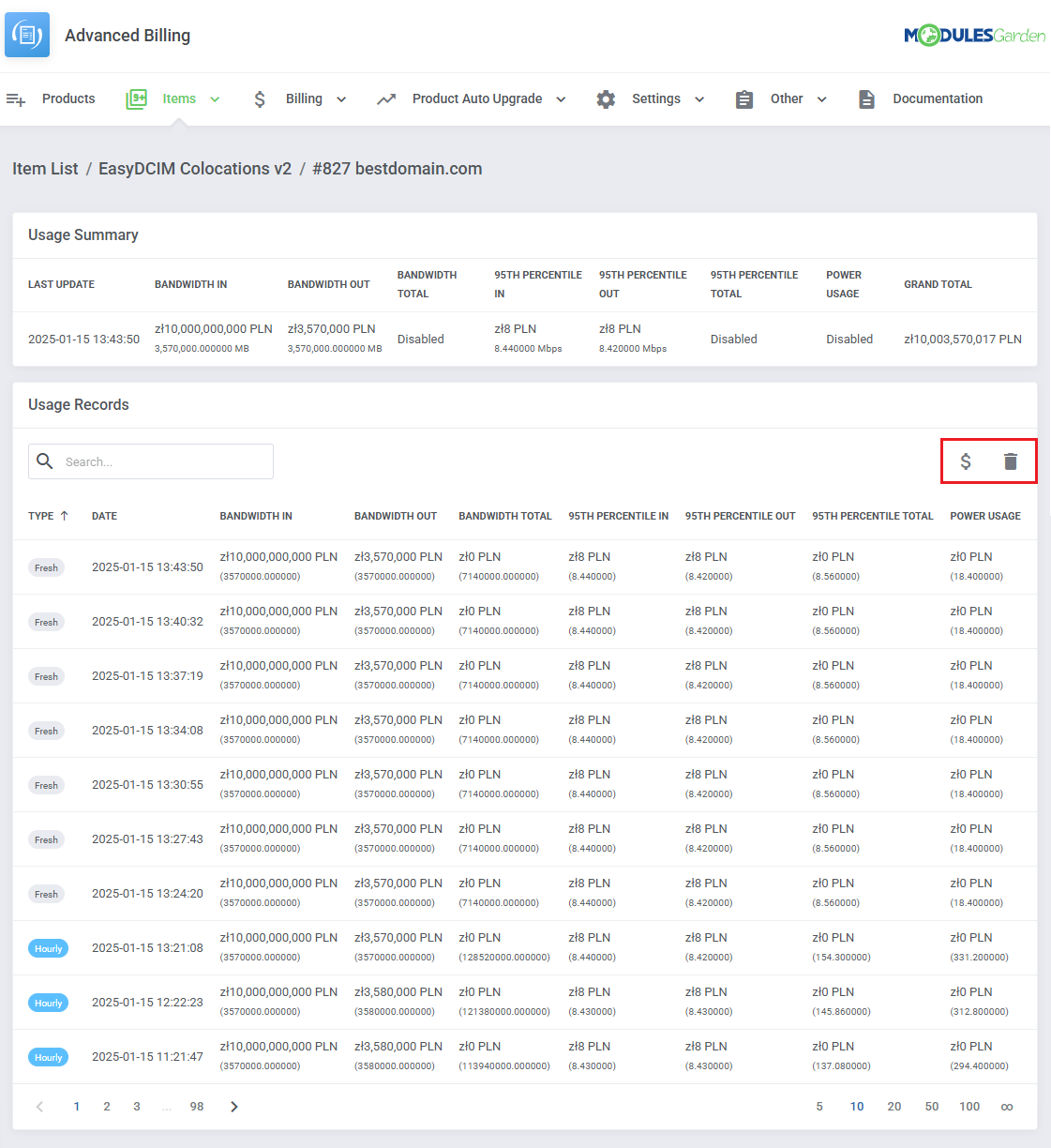
|
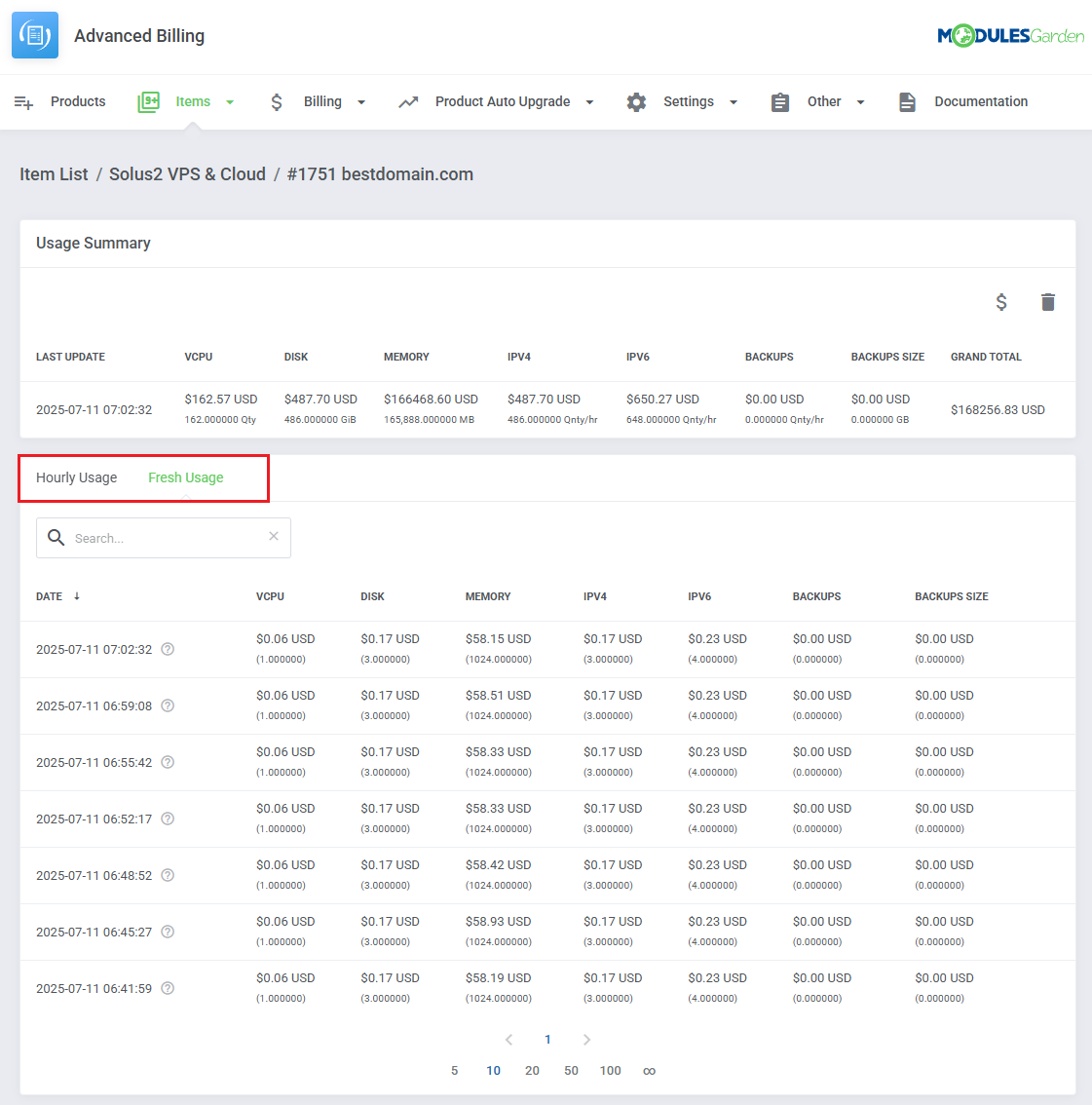
|
| The 'View Graph' button will, in turn, display a resource usage graph for the item. You can change aspects of the graph scope by clicking on the 'Edit' button. |
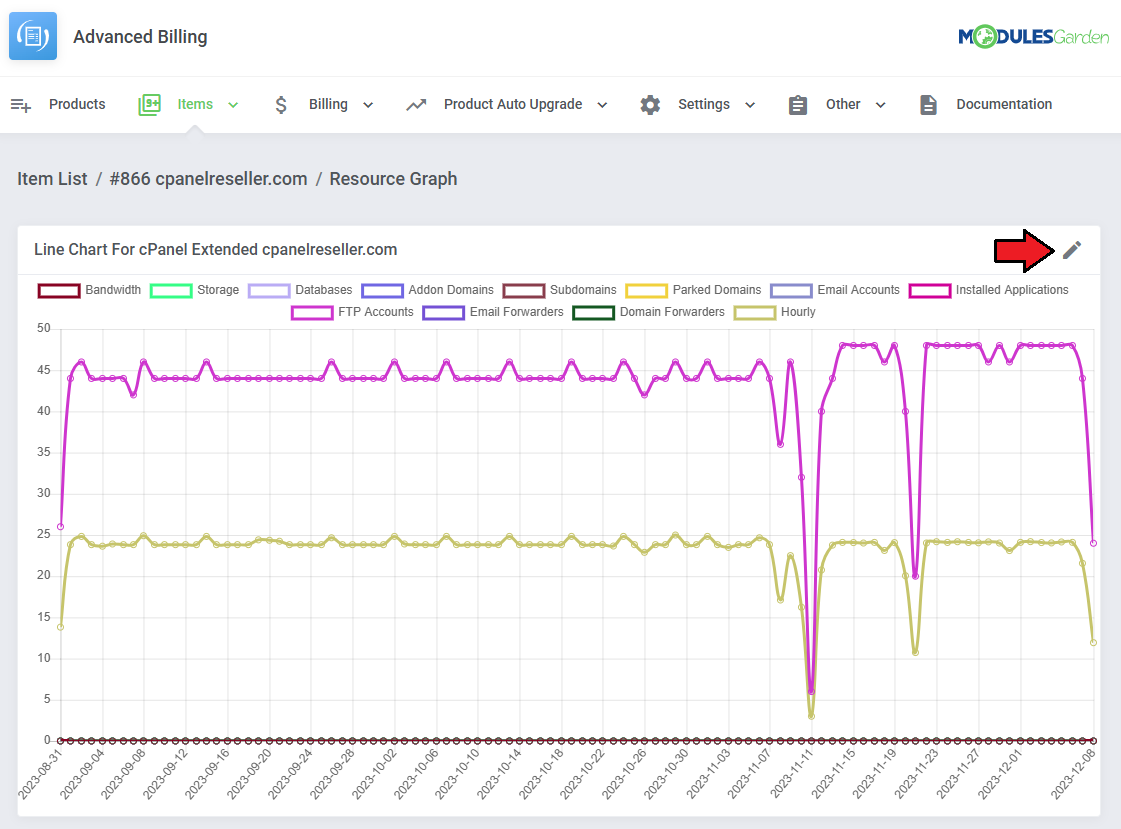
|
| Select the resources and time scope you would like the graph to include. |
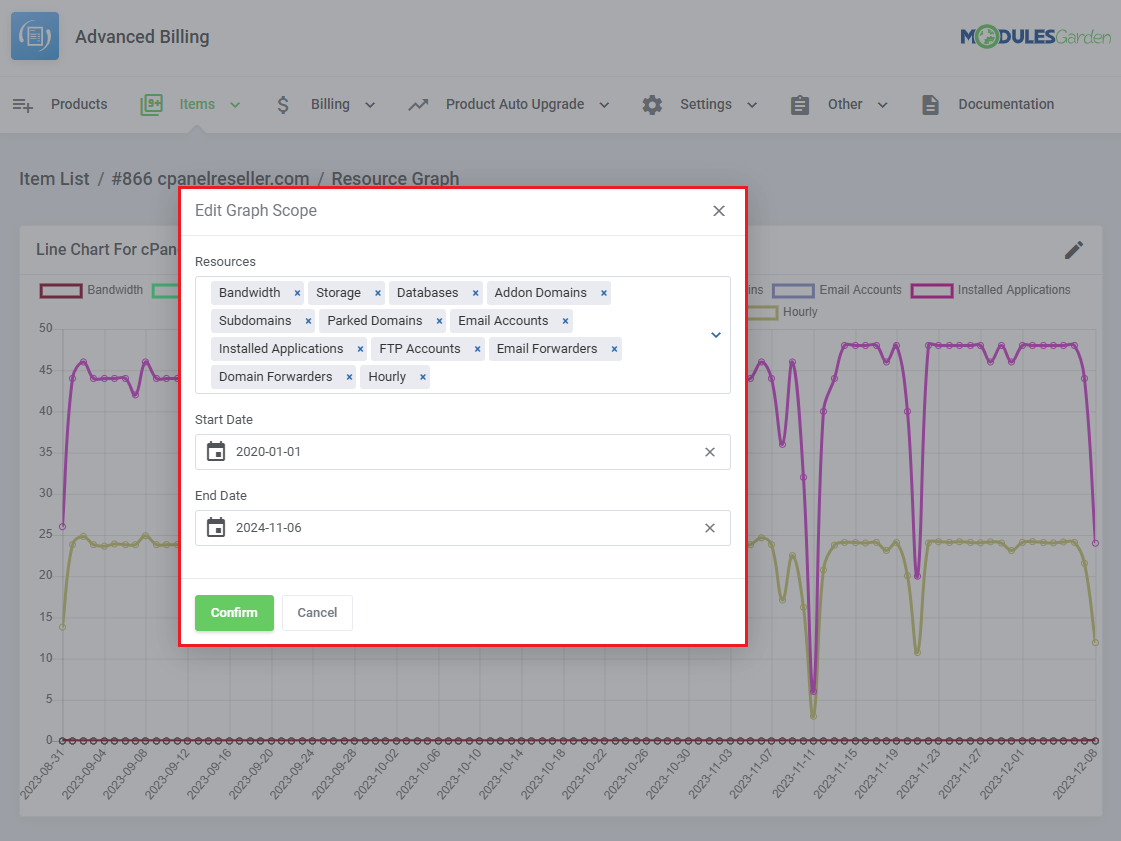
|
[edit] Item Archive
| You can find the 'Item Archive' under 'Items'. It included items that are already billed. The list includes information such as:
And action button responsible for:
|
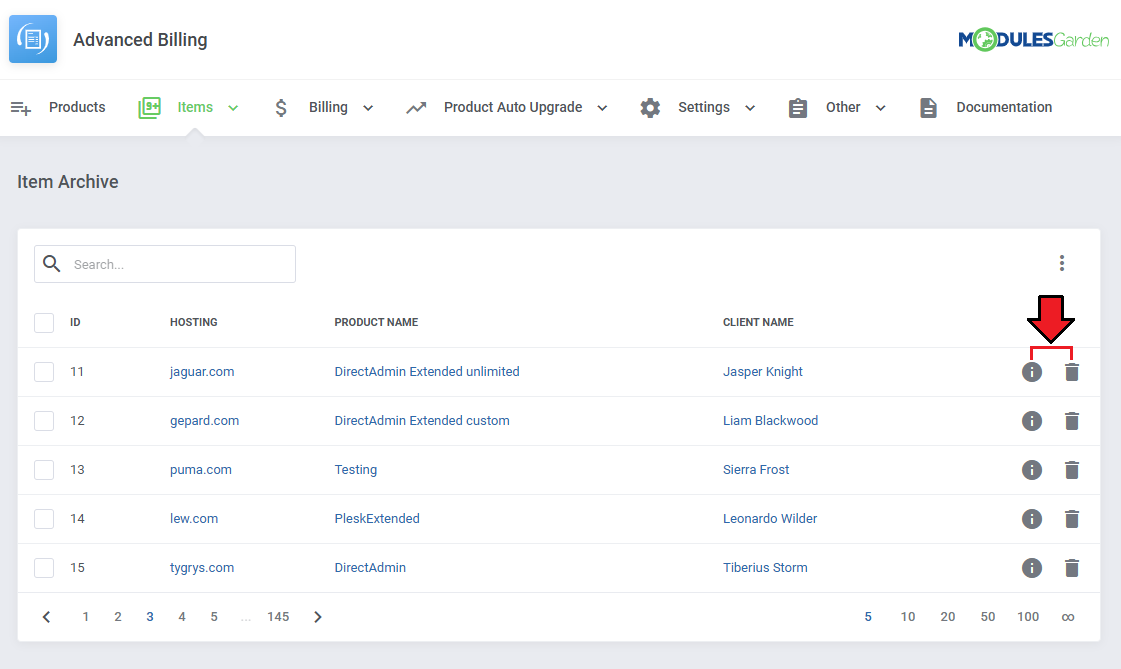
|
| You can mark multiple items with the mass delete function when necessary as well. |
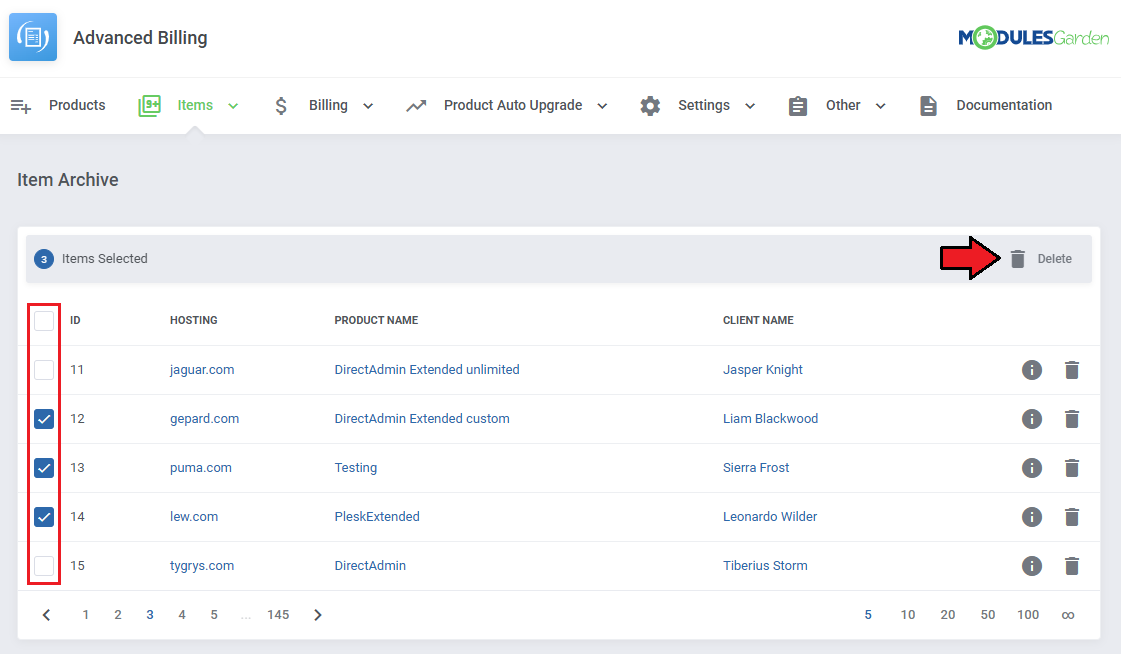
|
| Finally, you can flush your archive, deleting items meeting the criteria set in Item Archive Configuration. |
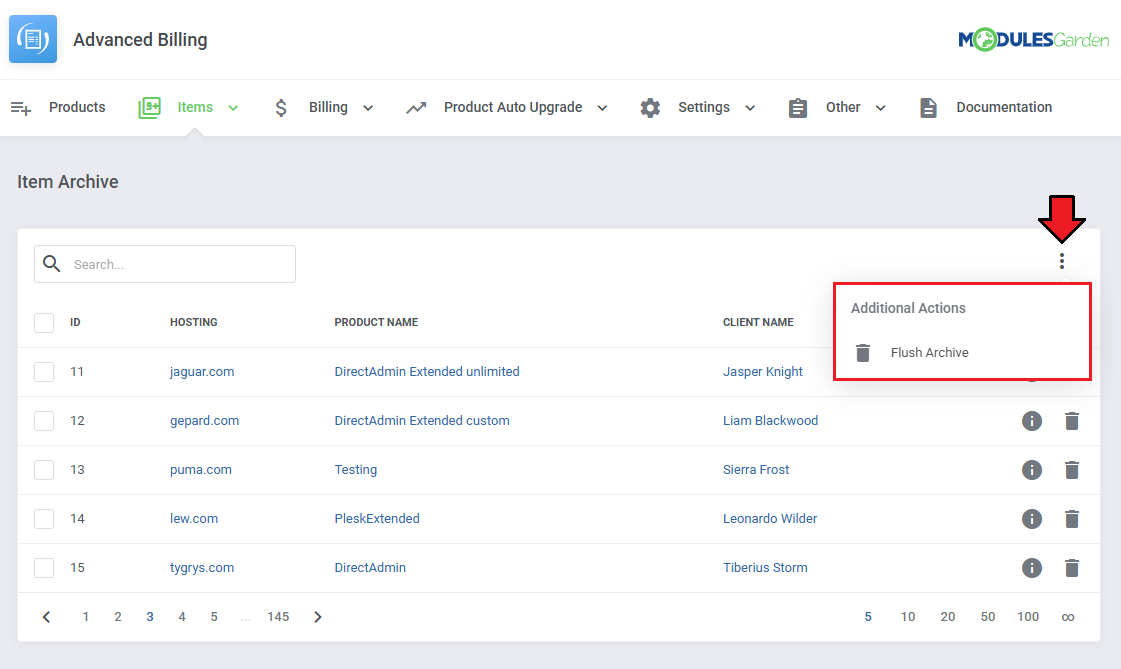
|
[edit] Billing
| All billing related management can be found under the 'Billing' section. This includes 'Invoices' and 'Credits'. |
[edit] Invoices
Invoices created both automatically and manually can be found here. The invoice list includes:
And action buttons are responsible for:
Important: Awaiting invoices will not be issued automatically until you manually approve them. |
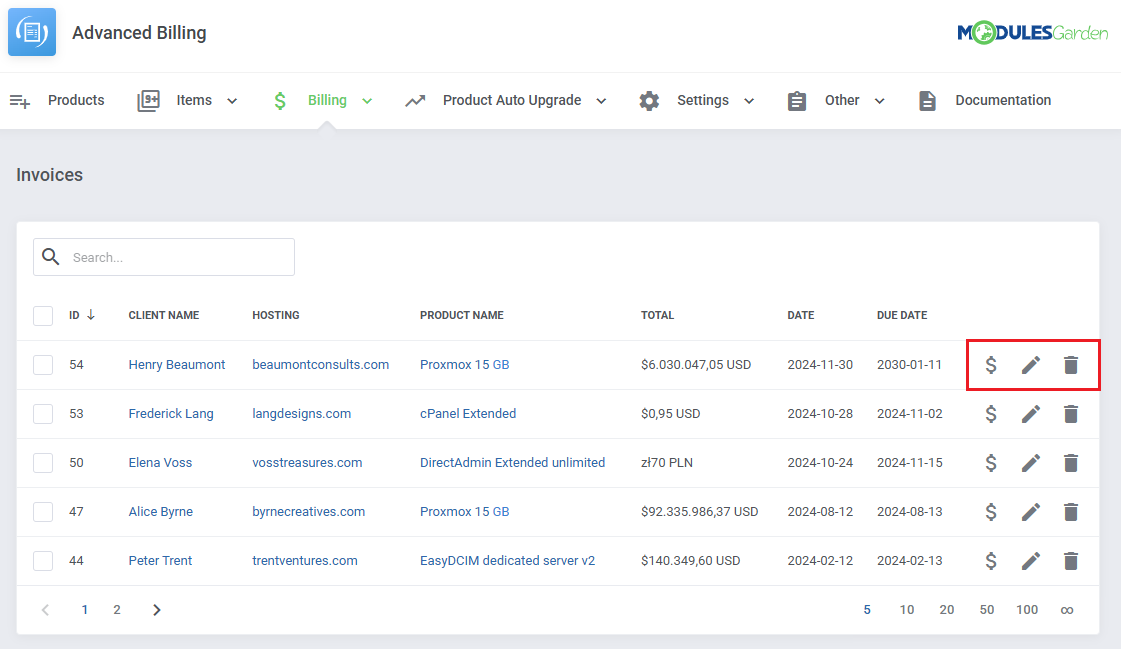
|
| You can also utilize the mass function to generate or delete multiple invoices at once. |
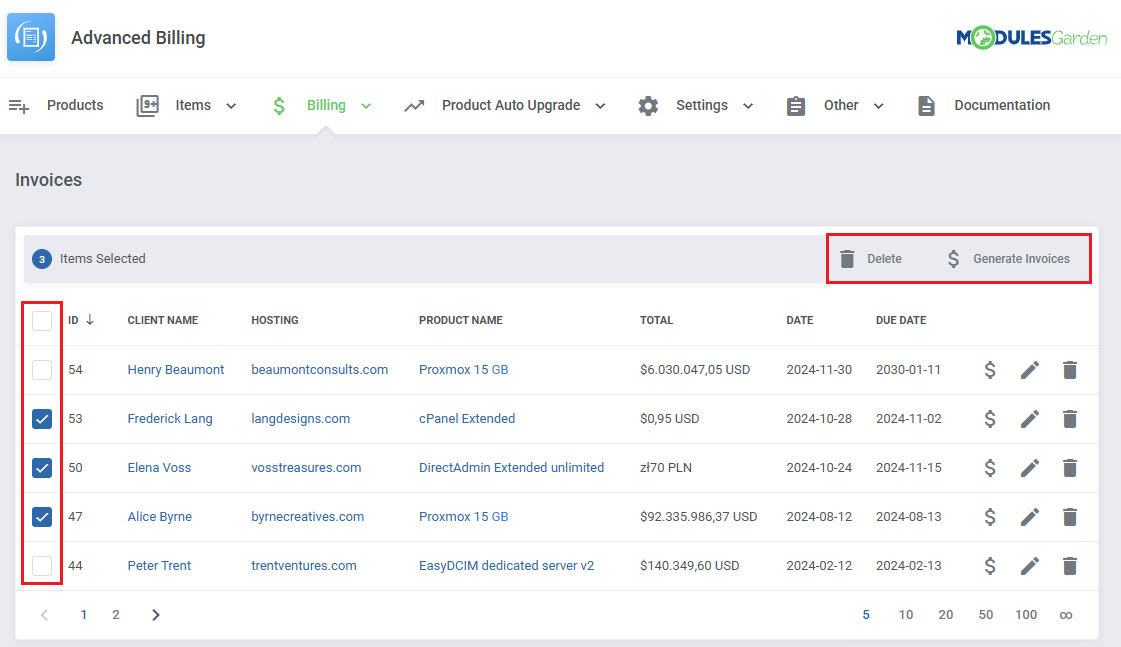
|
Invoice details consist of editable fields such as:
and every billed item with its:
|
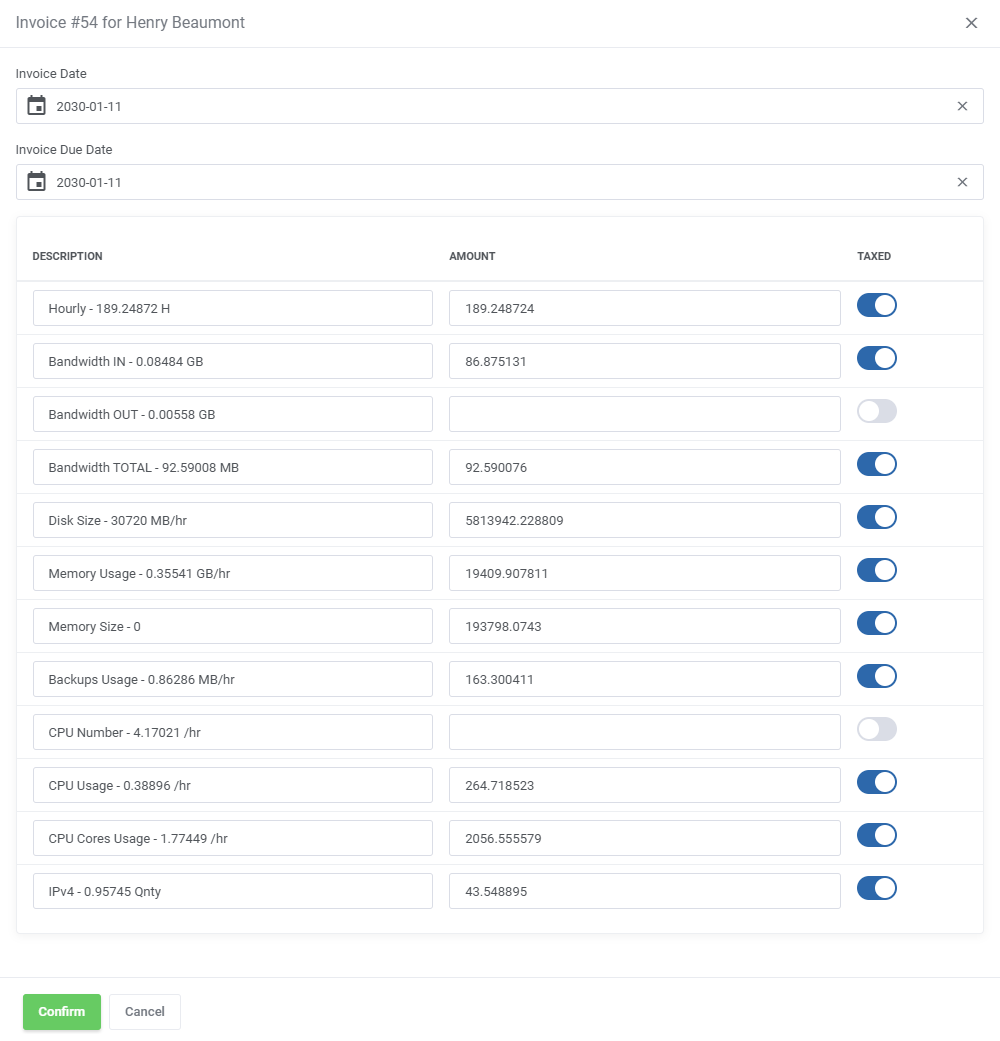
|
[edit] Credits
| This tab lists all credit top-ups issued by the clients with the 'Credit Billing' function. The list includes:
and an action button allowing the admin to 'Refund' the credits to WHMCS 'Credit Balance'. |
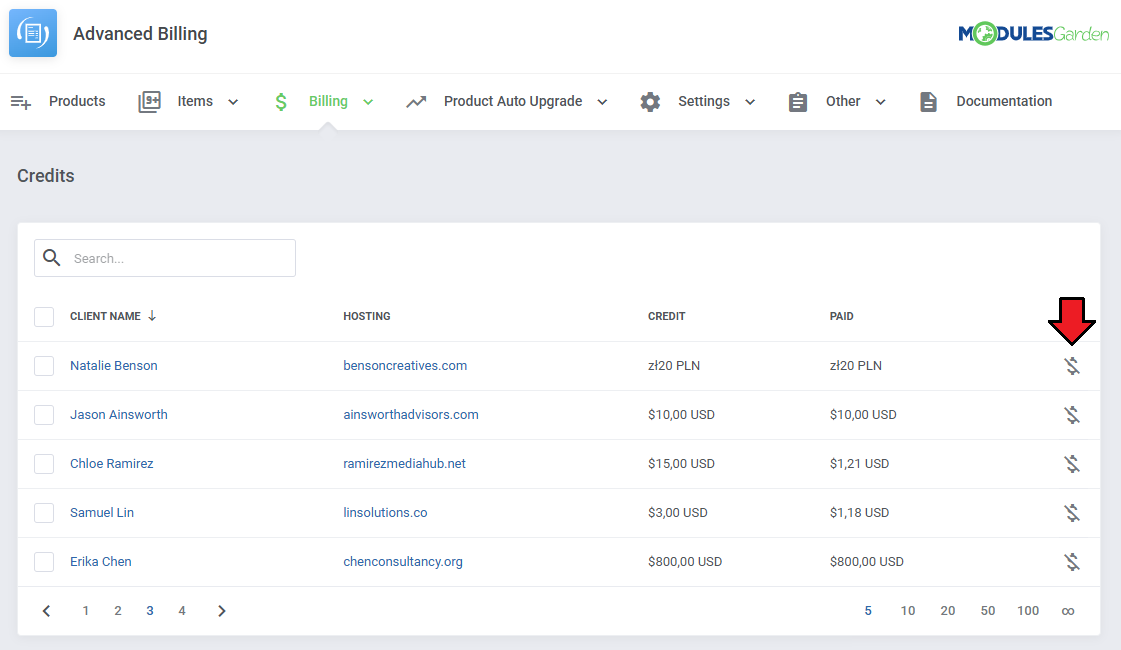
|
| Multiple top-ups can be selected to refund them at the same time. |
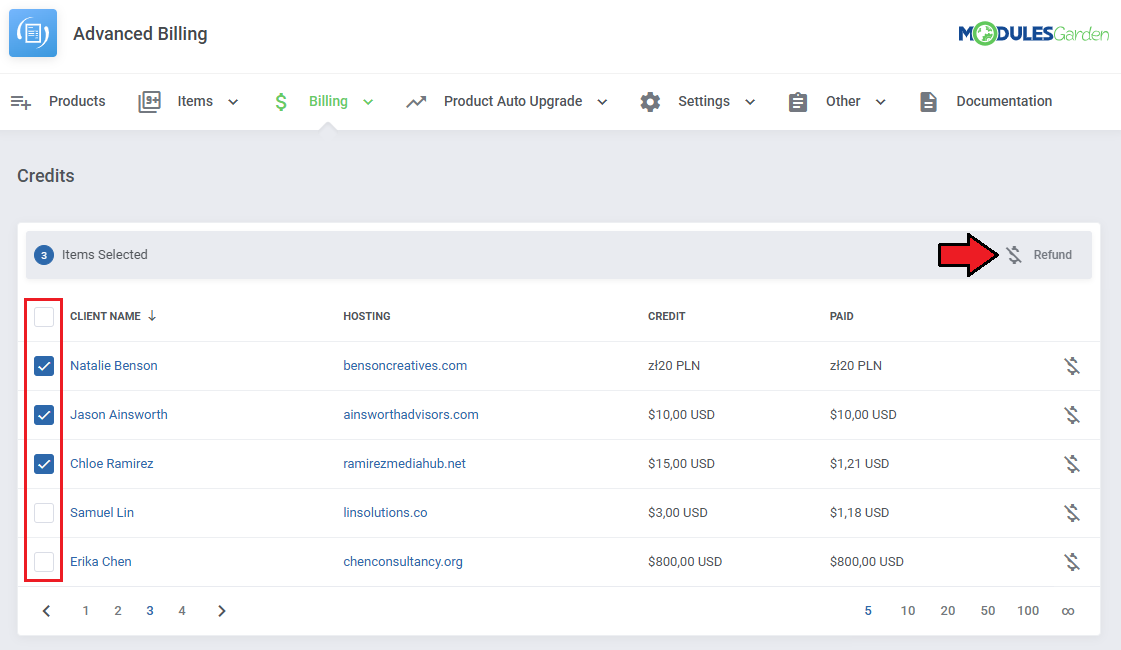
|
[edit] Product Auto Upgrade Management
| Under the 'Product auto Upgrade' you will be able to find tools to create and manage the auto upgrades based on resource usage. This section is only relevant for products with the Product Auto Upgrade function enabled. |
[edit] Configuration
| Find the 'Configuration' tab under ' Product Auto Upgrade' and click on 'Add Group' to add a new group. |
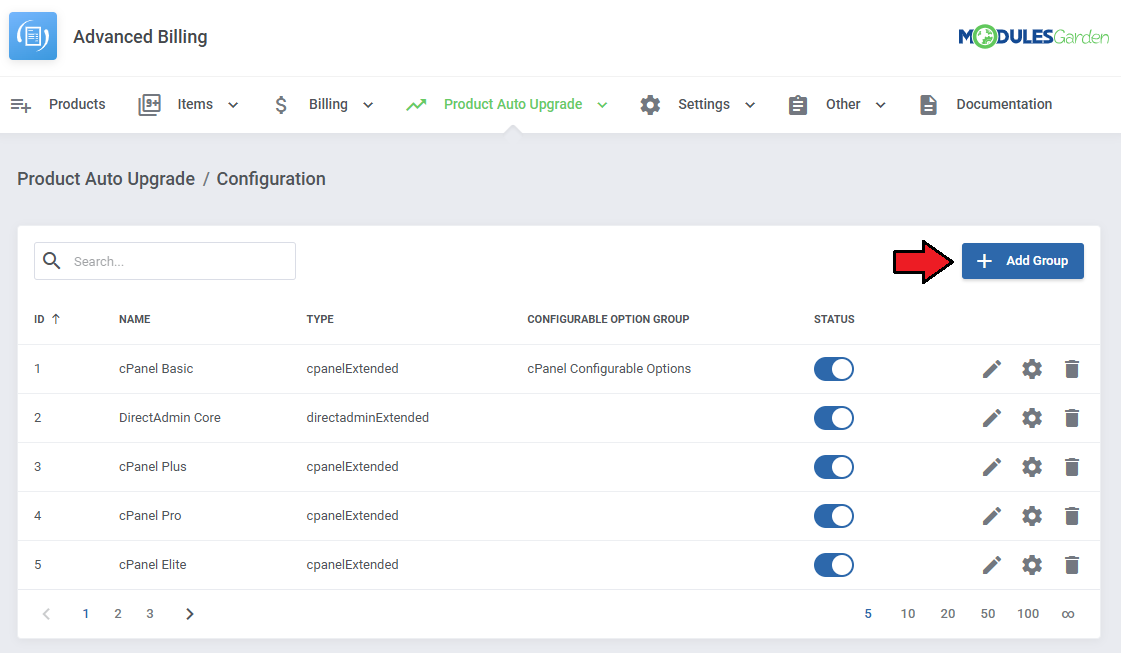
|
As you create the group, complete the following fields:
|
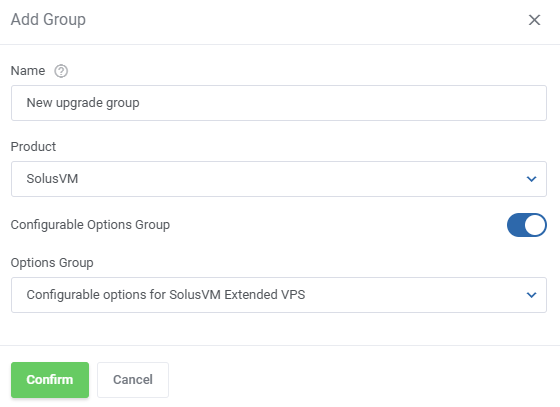
|
Once the group is added, the action buttons will allow you to:
|
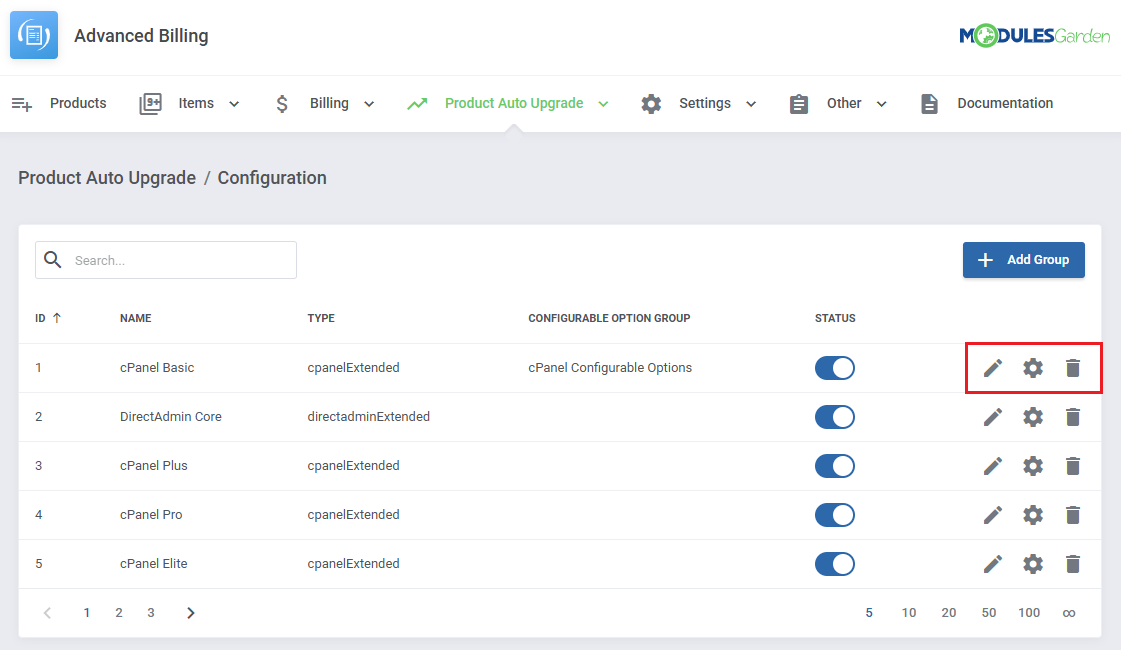
|
While editing the settings you will be able to change:
|
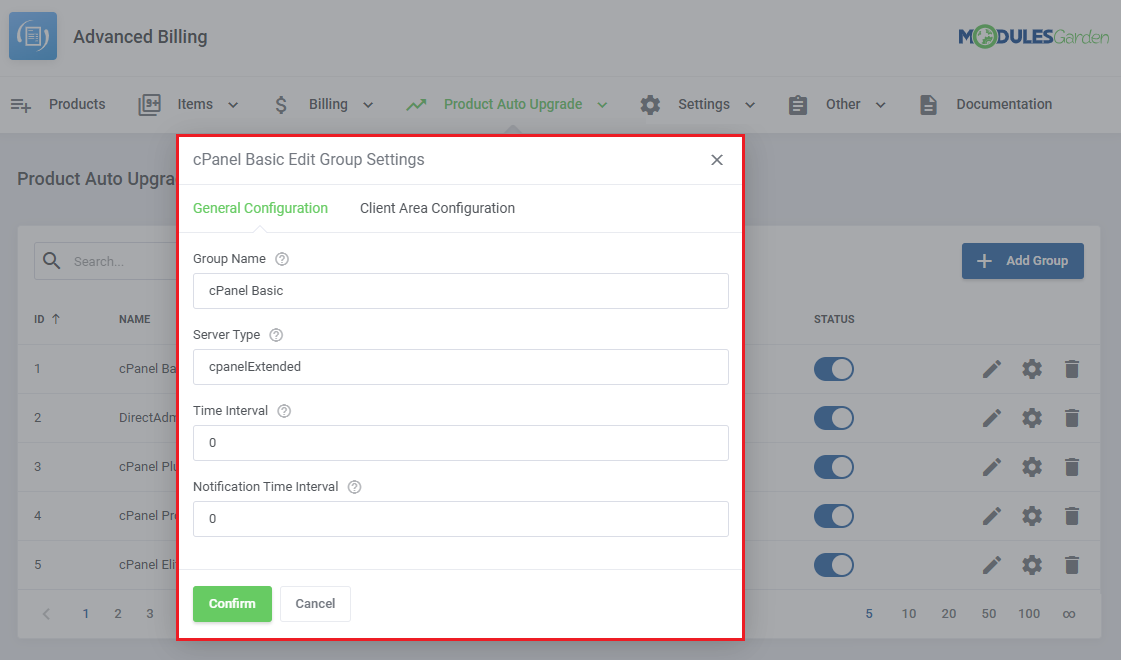
|
You can also change what the client is allowed to do:
Notification Email Template: |
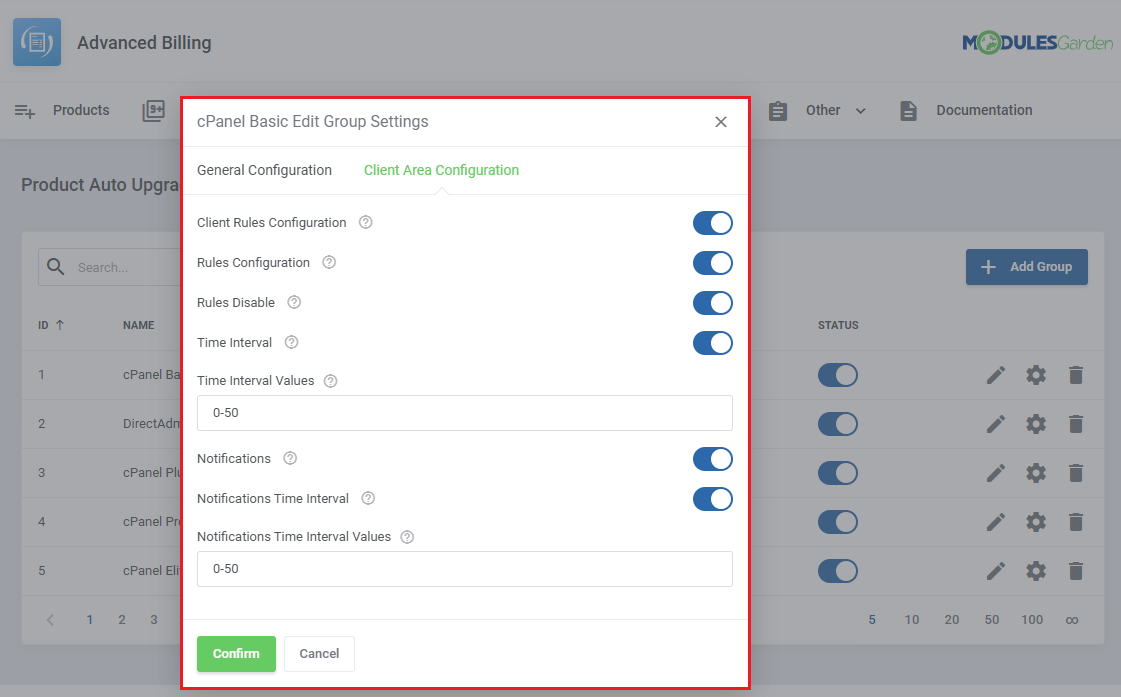
|
[edit] Option Configuration
| The 'Options' action will take you to a page where you can define upgrade/downgrade options within the group and manage their status. Before you can enable the Product Auto Upgrade single option, make sure the following configuration steps are completed:
All three steps must be completed before the toggle can be set to Enabled. Otherwise, you may encounter the following error message: You cannot enable the option. Please check the option configuration. To start, simply click the Add Option button and name your new option. |
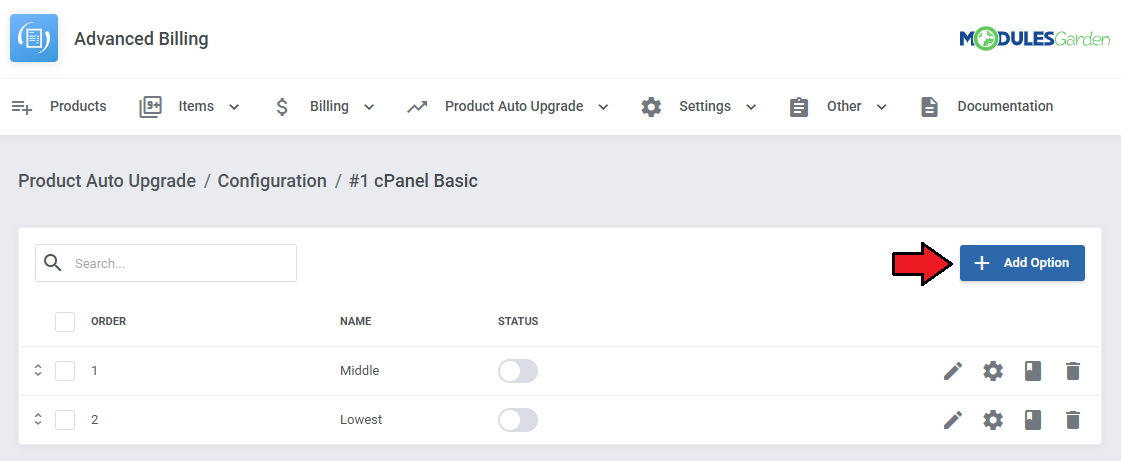
|
After the option is added, it will appear on the list. Use the action buttons to perform actions:
|
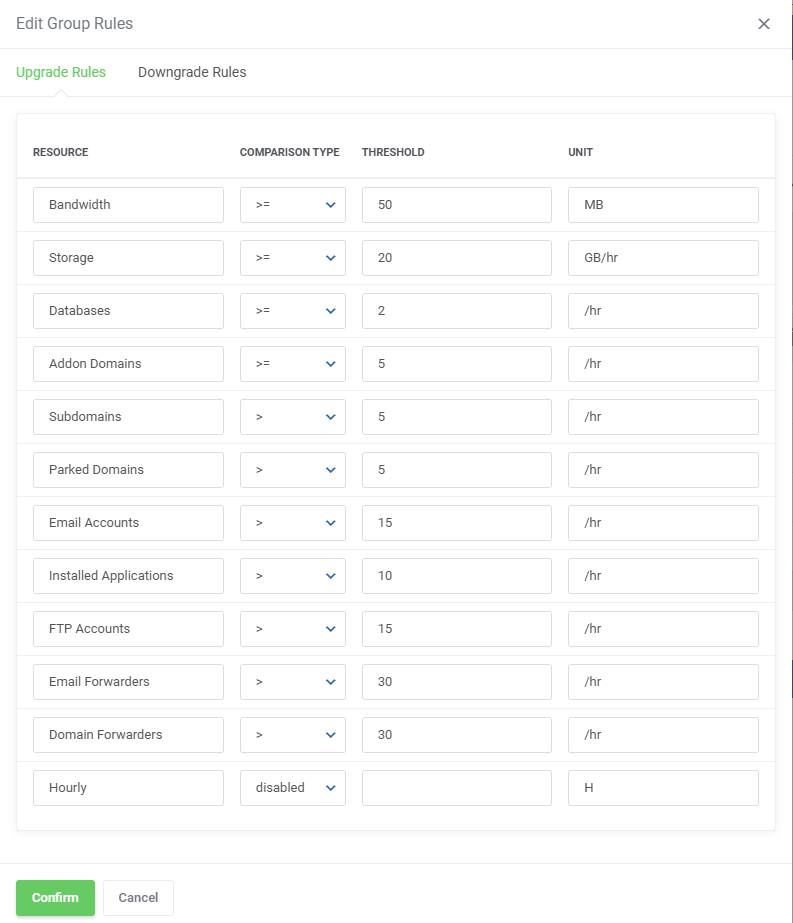
|
|
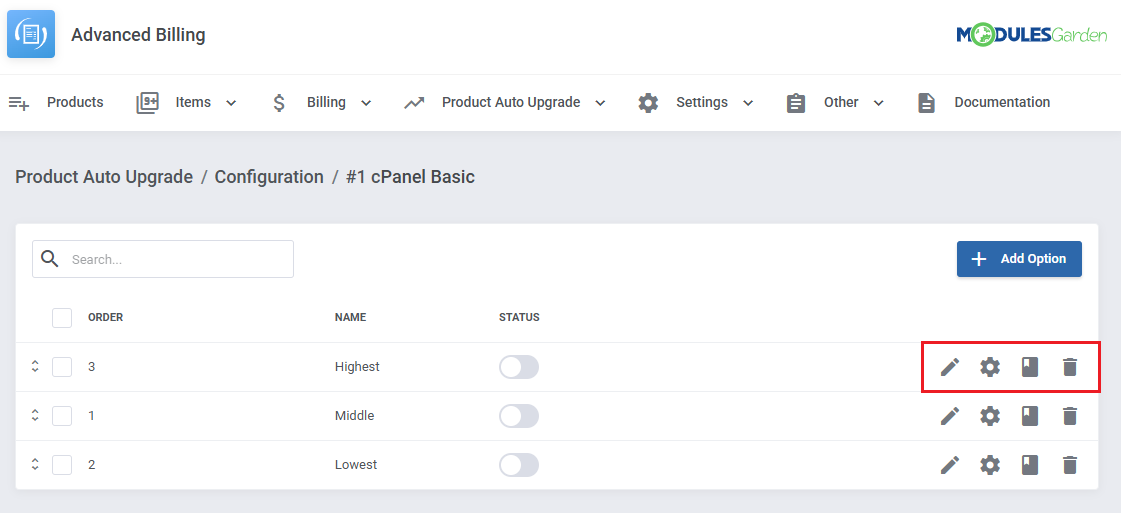
|
|

|
| You can also use the mass action tools to delete or change packages for multiple options at once. |
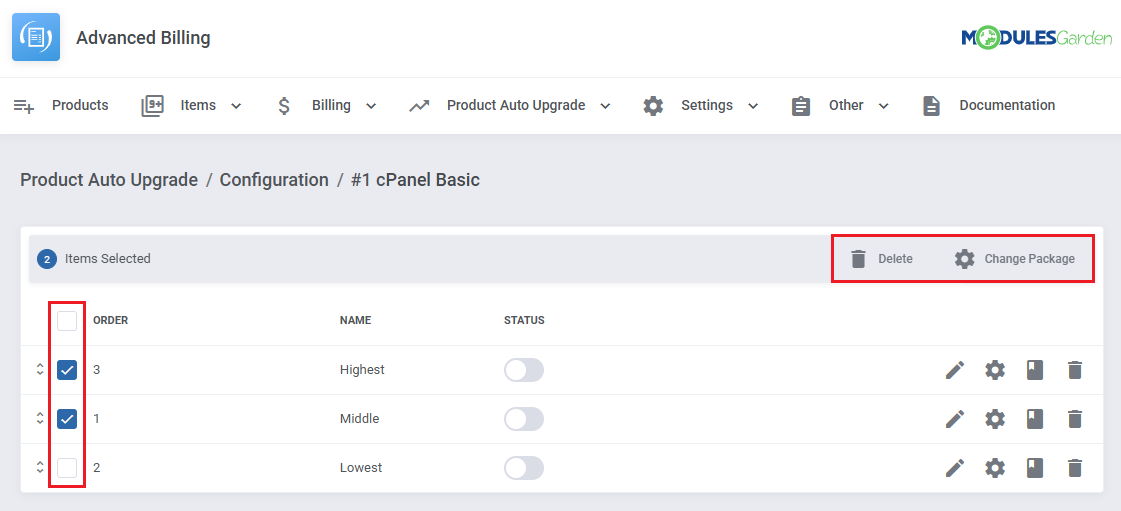
|
[edit] Accounts
| Services or 'Accounts' that make use of the 'Product Auto Upgrade' are recorded and listed in the 'Accounts' section under 'Product Auto Upgrades'. The list includes information such as:
The 'Details' action button will display more information on a specific account. |
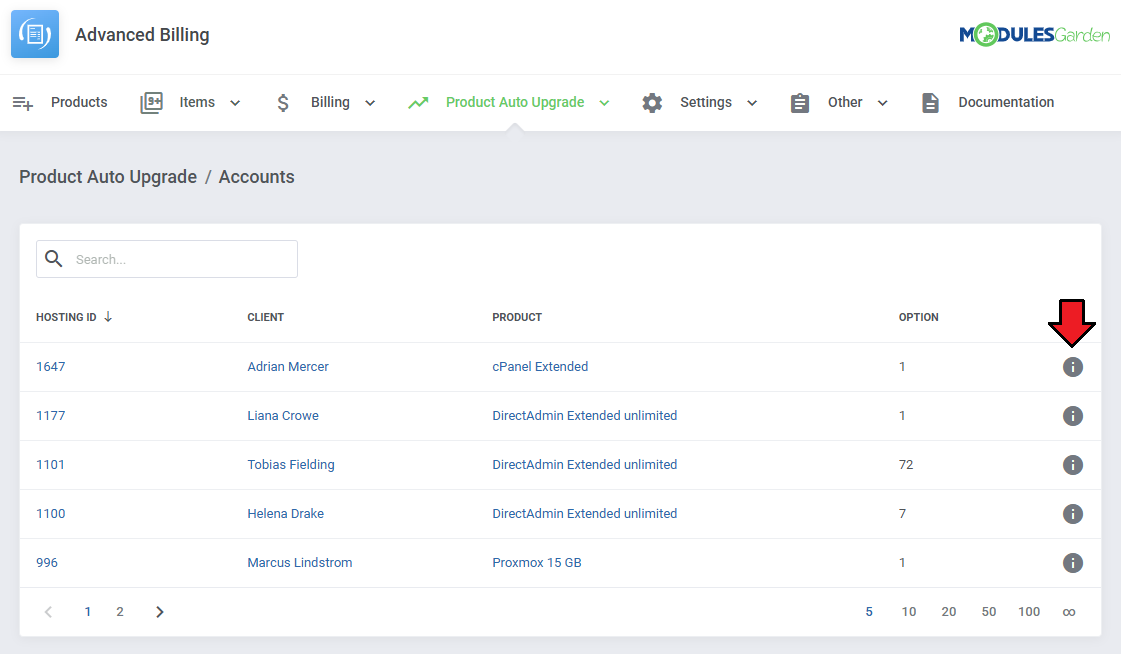
|
The details include a list of auto upgrades complete with:
|

|
[edit] Client Area
| Depending on the option's setting, several features can be made available to the client. Assuming 'Client Rules Configuration' is enabled, clients will be able to change how their service interacts with the system by clicking on the 'Settings' icon under 'Auto Upgrade'. |
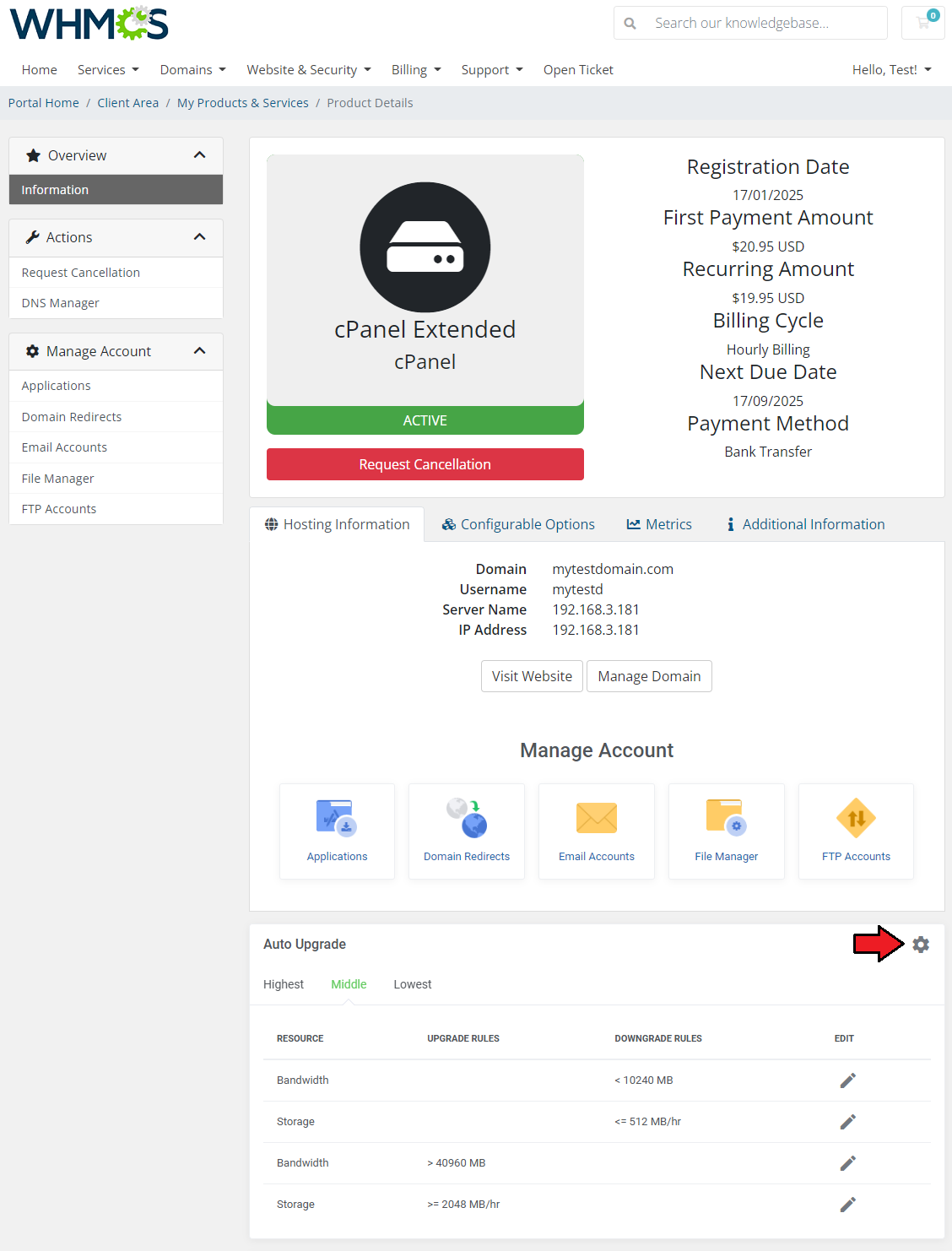
|
Options may include:
|
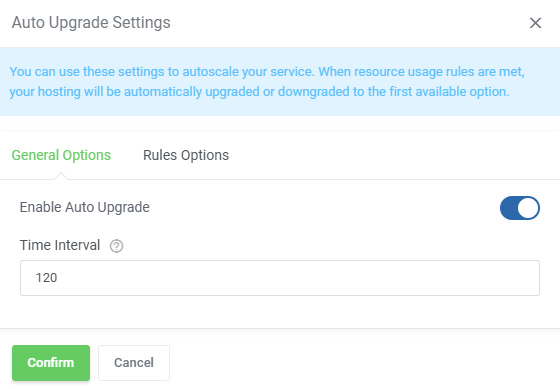
|
| Under the 'Rules Options' tab, the client can select which rules to enable. |
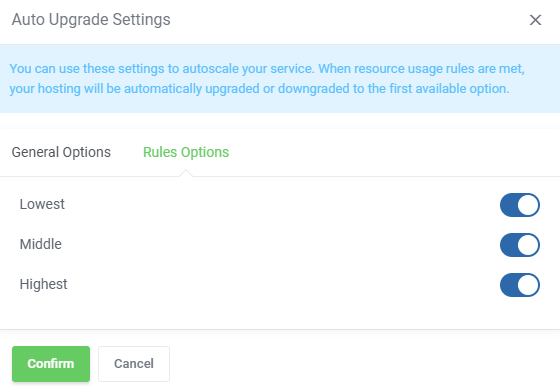
|
| Service upgrades are recorded and displayed in the 'Auto Upgrade History' table. |
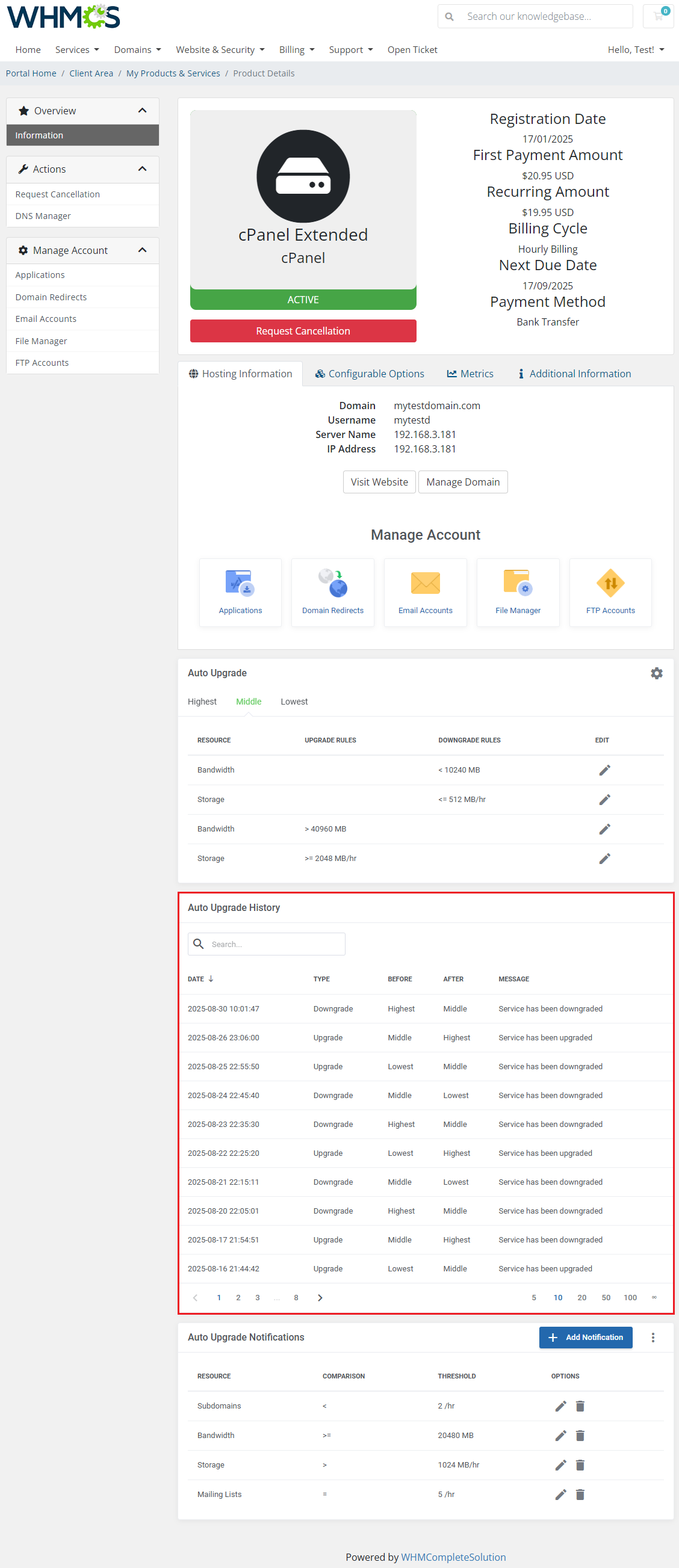
|
| Notification messages for upgrades can be set up by the user, first, click on the additional actions button. |
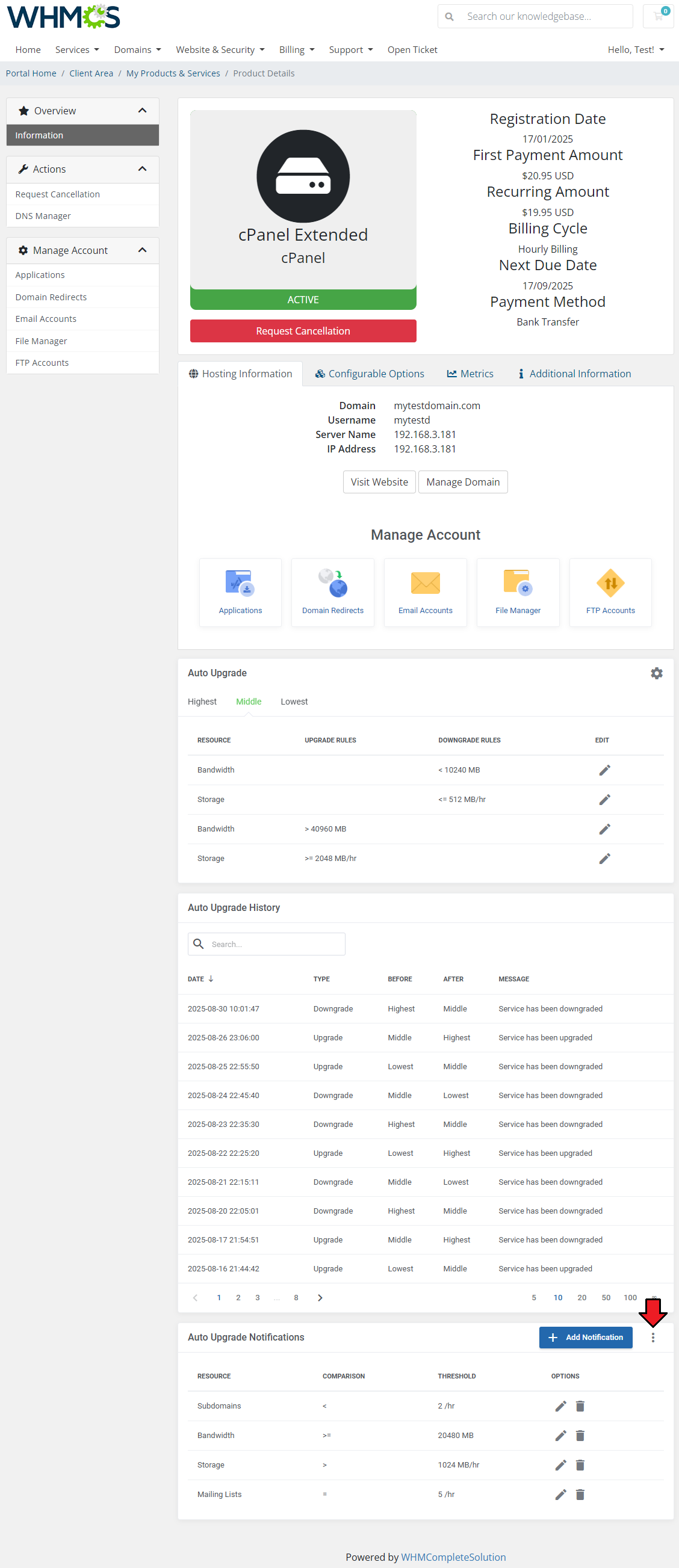
|
| Enable the function and select the interval between each message. |
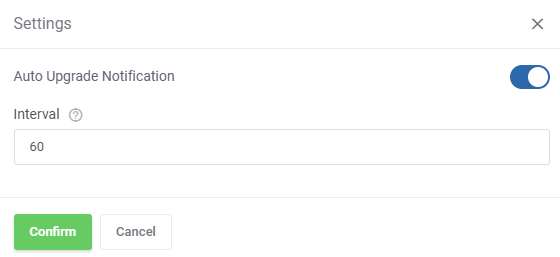
|
| To add a new notification use the 'Add Notification' button. |
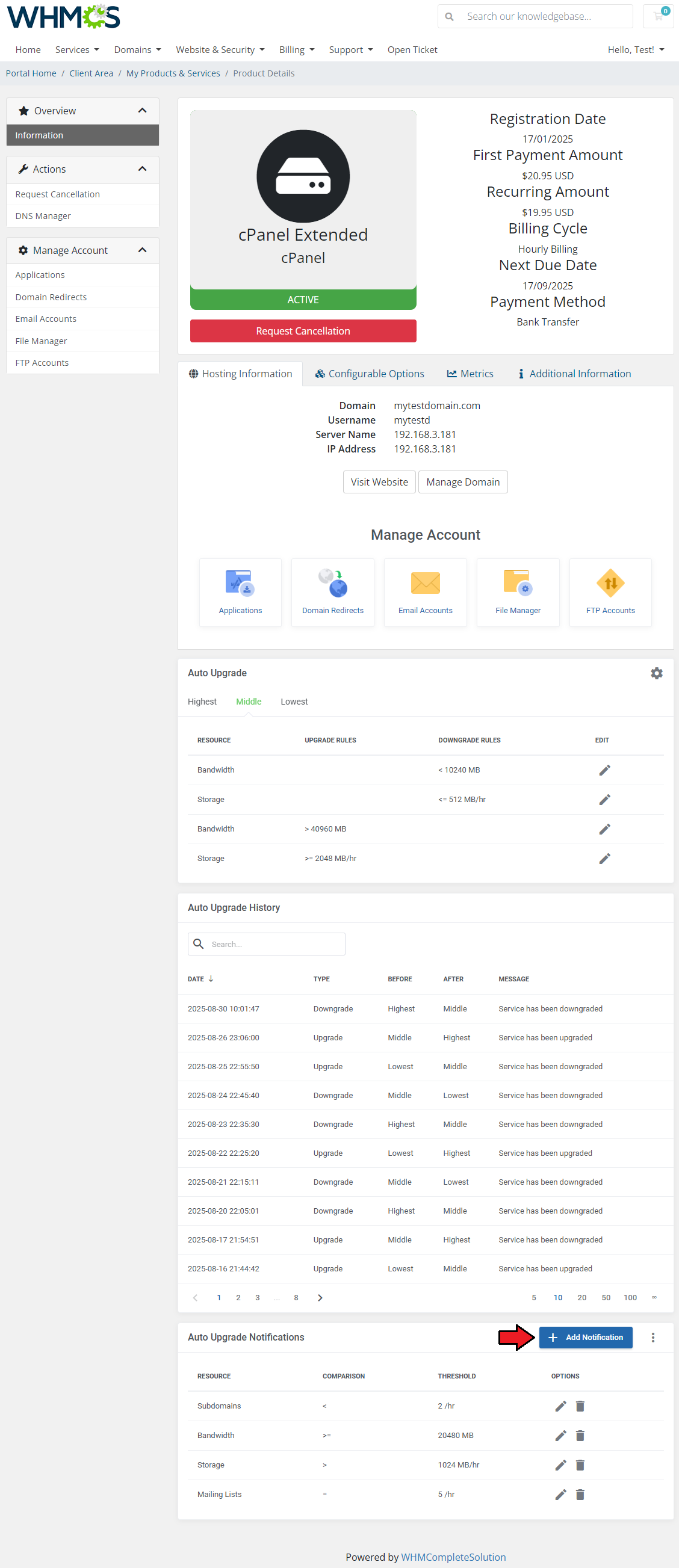
|
| Select the resource, comparison and unit for the notification. |
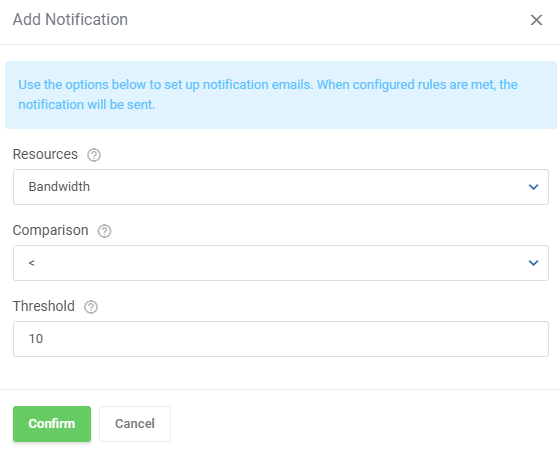
|
| You can add as many notifications as you would like. Action buttons allow you to edit or delete the notification. |
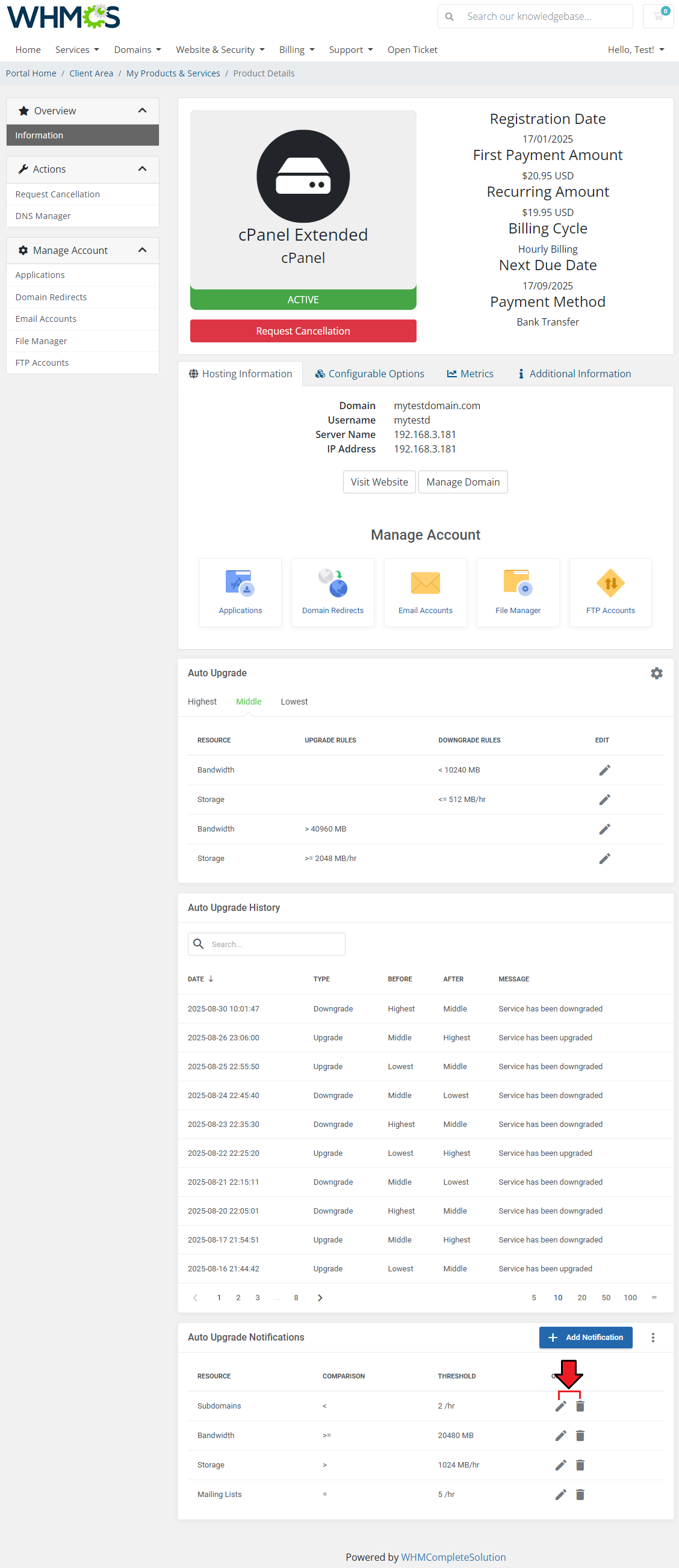
|
[edit] Settings
[edit] Cron Job Settings
| This section provides the command required to initiate the billing process handled by the module. The cron job is essential to perform automated billing actions in the background. Please manually add the below command to the crontab, remember to adjust the path to match your WHMCS installation: php -q /your_WHMCS/modules/addons/AdvancedBilling4/cron/cron.php cron |
The cron can be customized with the following options:
|
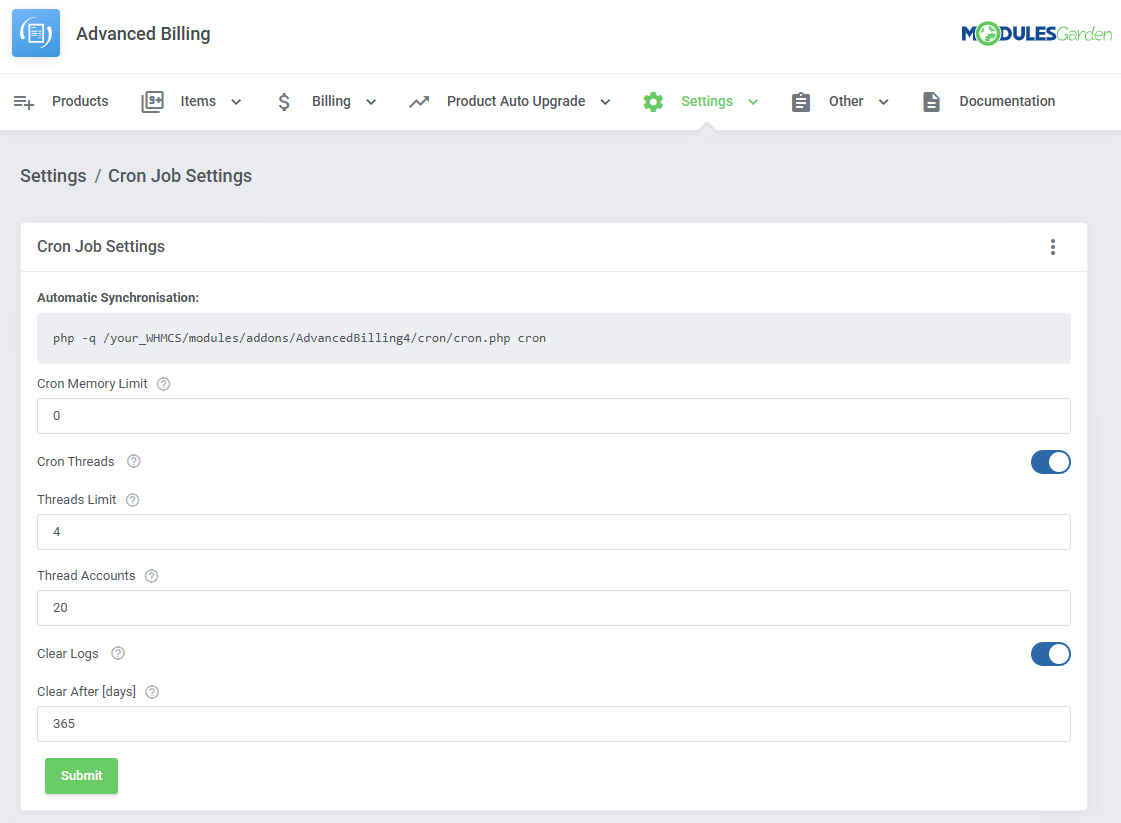
|
Cron job additional options:
|
[edit] Item Archive Configuration
In this section, you can set up the item archive to your preferences. The top of the tab includes a counter that lists the total archived items and how much disk space it occupies.
|
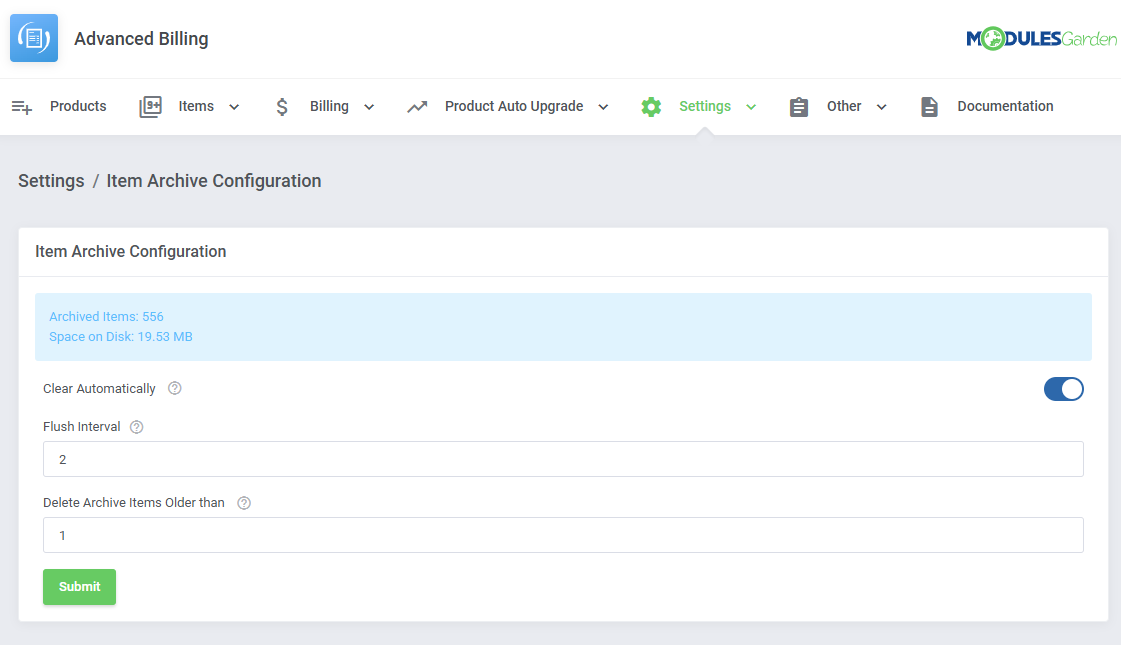
|
[edit] Other
| Other useful tools and features directly related to the module functioning can be found in the 'Other' section. This includes:
|
[edit] Translations
| Customizing language files is now extremely easy with the "Translations" tool that is now available directly in the addon. Its user-friendly design makes managing various language file tweaks a smooth and efficient process. Prepare translations for the original English files with this handy built-in tool. For specific instructions on how to use this tool please refer to its dedicated article, you will find it here. |
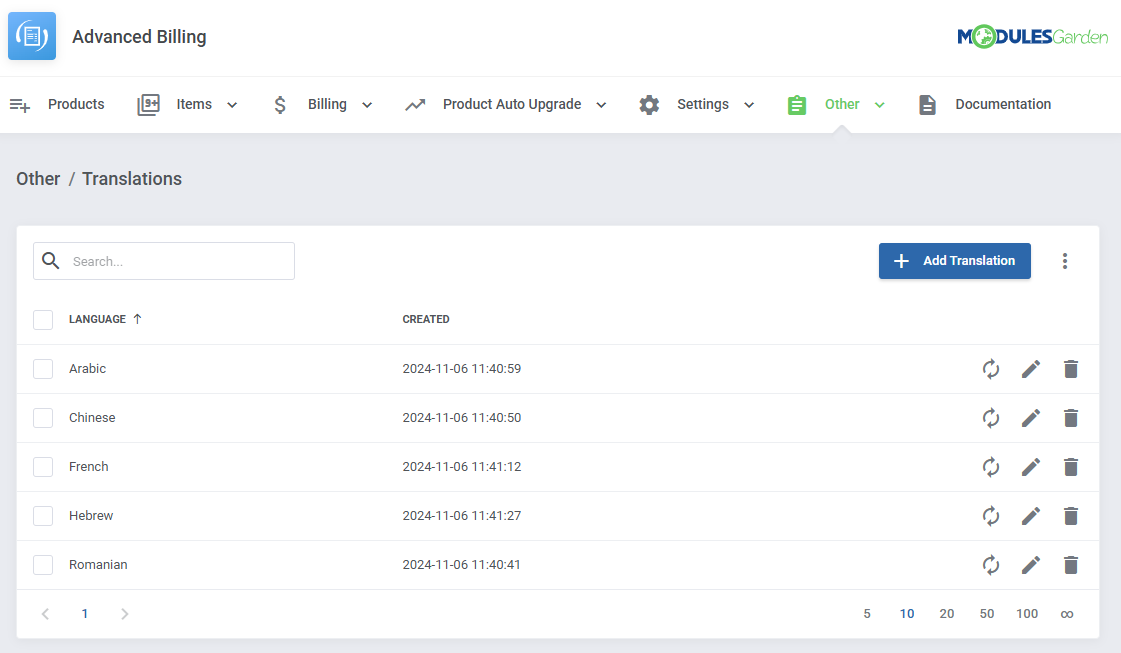
|
[edit] Access Control
| 'Access Control' allows you to specify and control exactly which sections of the module can be accessed by your administrators. The way it works is that you create access control rules in which you decide if a specific admin, or admin role has full access, or is restricted to only specific sections. For more detailed information on the available modules that include this tool, please refer to the Access Control Tools Wiki Page. |
[edit] Rules
|
Start with creating a new rule, click on the 'Create Rule' button and a dedicated form will appear. Below you will find a description of every field required in the form. |
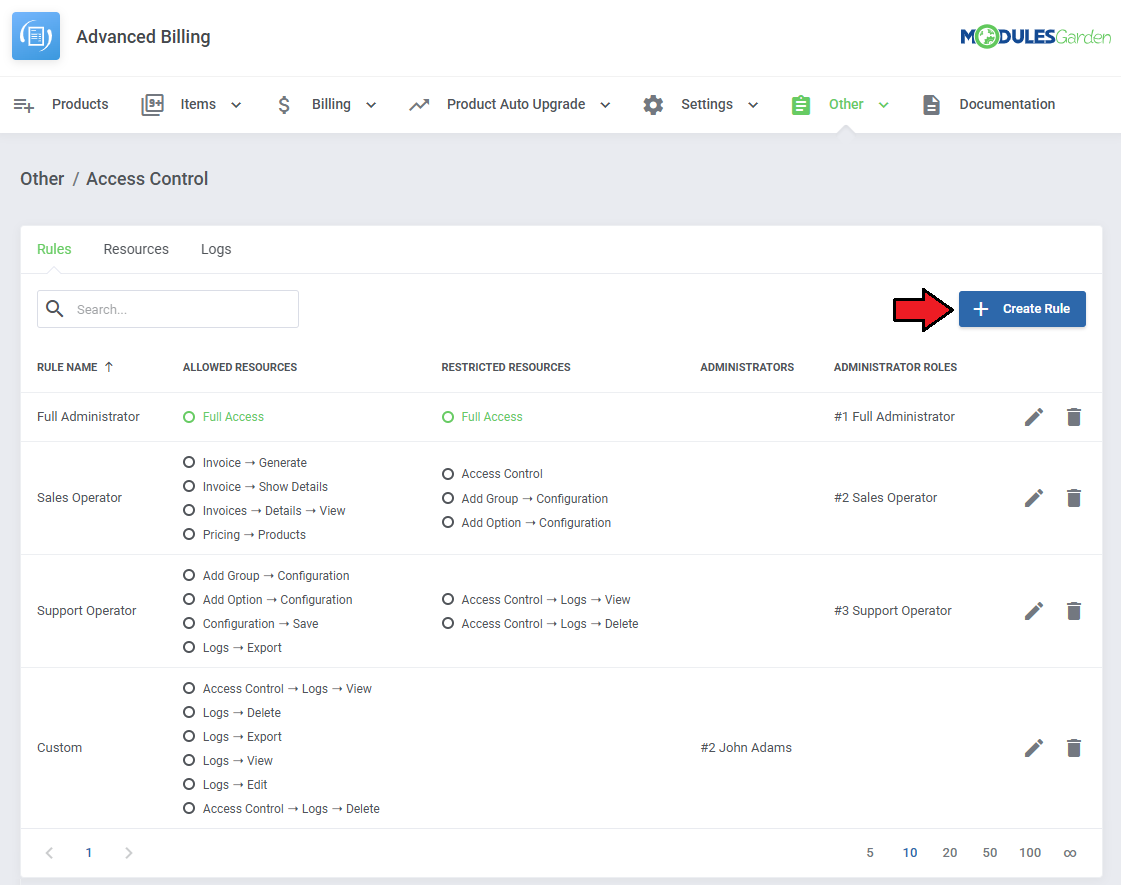
|
Fill out the following fields to create resources access rule:
Important: When picking specific sections, keep in mind that allowing a parent section will also allow all of its children. |
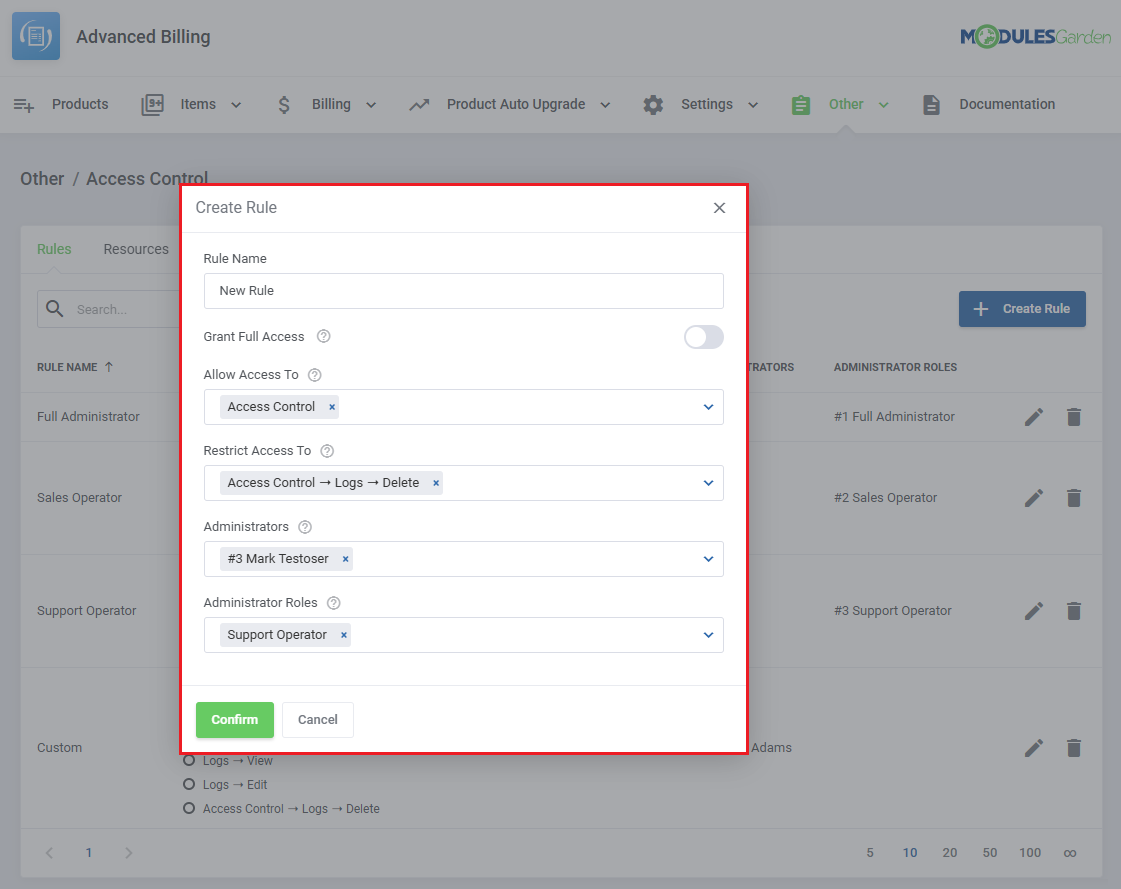
|
| To edit or delete existing rules, use the icons to the right. |
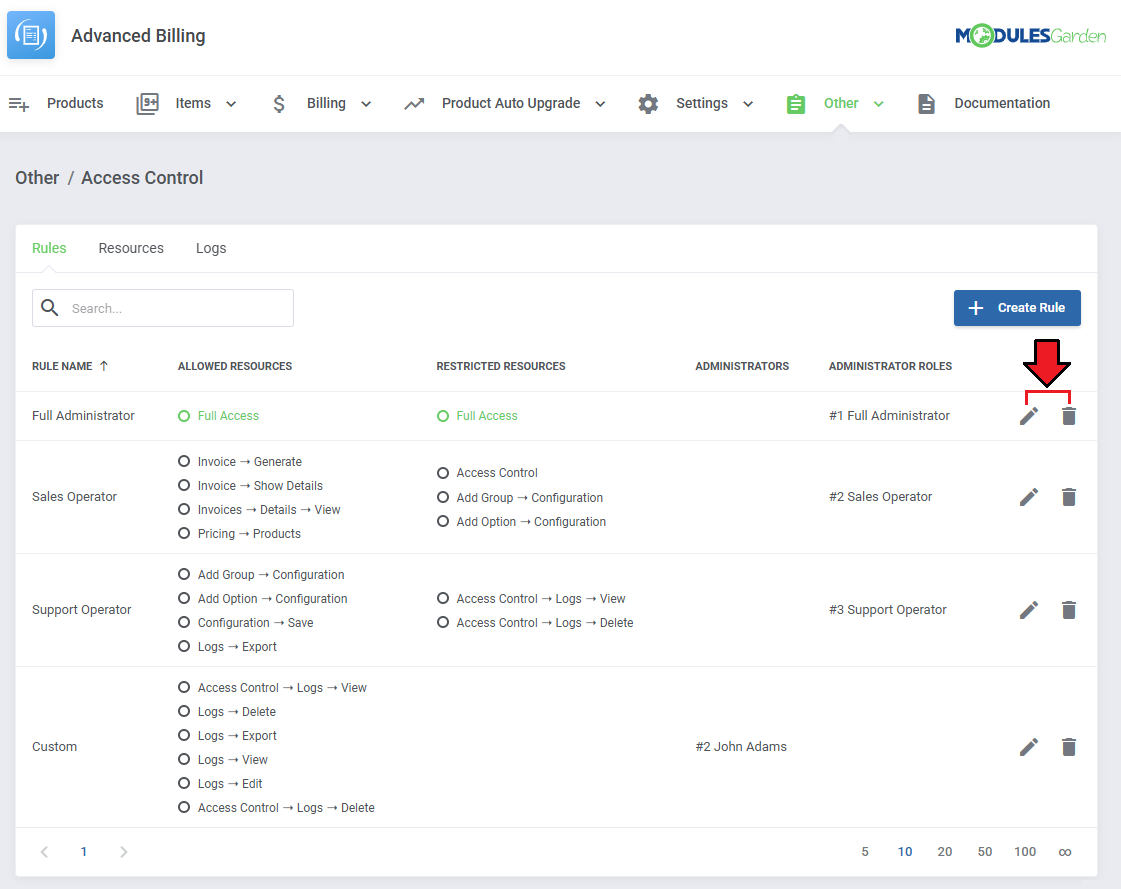
|
[edit] Resources
| Use the toggles in the 'Resources' section to specify which of them should be subject to logging, found in the 'Logs' section. Every time an administrator requests a toggled resource, it will be recorded. |
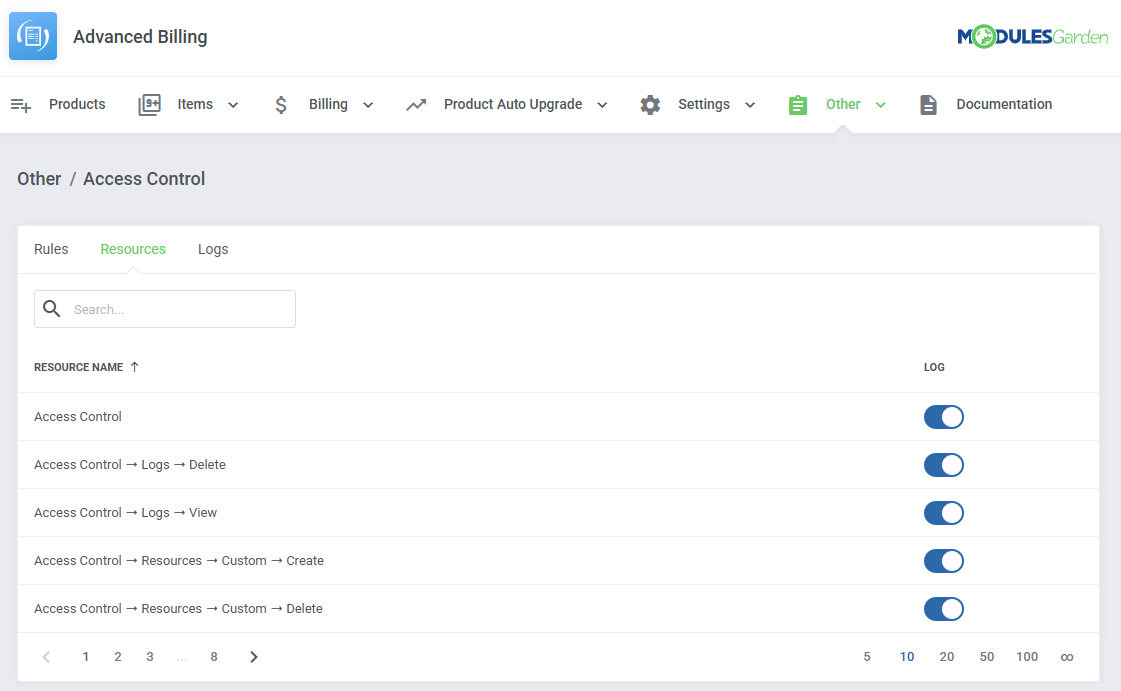
|
[edit] Access Control Logs
The logs section includes:
Use the trash bin icons to delete specific logs, or utilize the mass action function to delete multiple logs at once. |
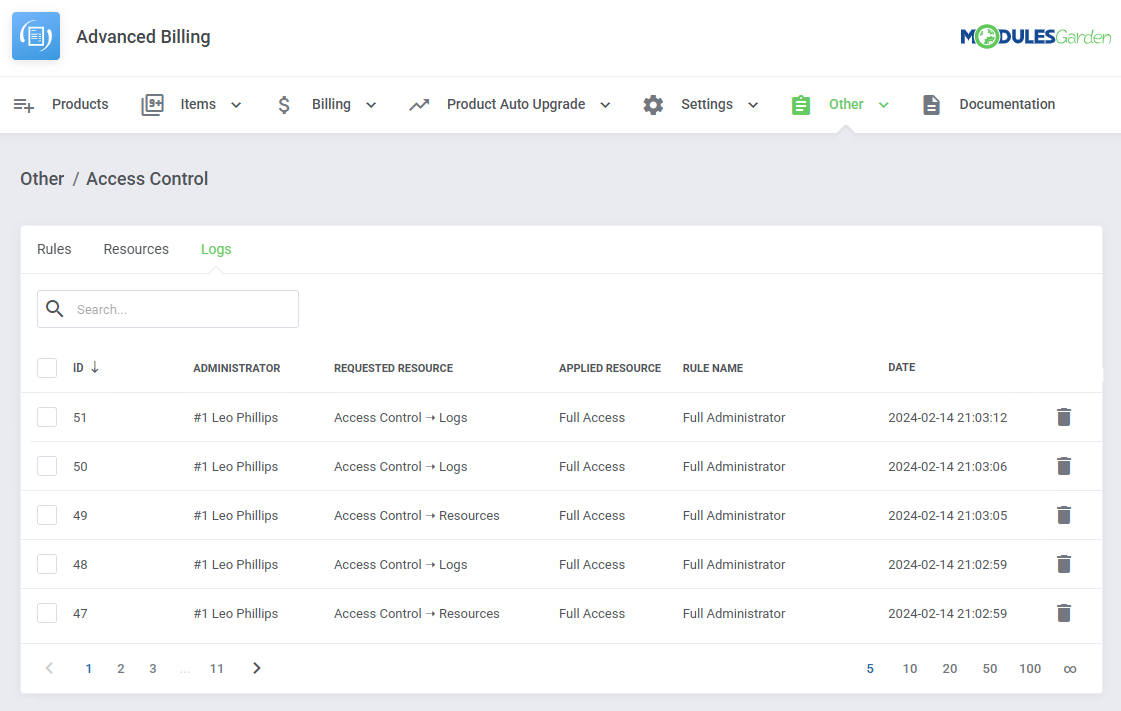
|
[edit] Logs
| The 'Logs' section under 'Other' is where the module logs are stored. You can filter the module logs by type with the 'Show' buttons:
|
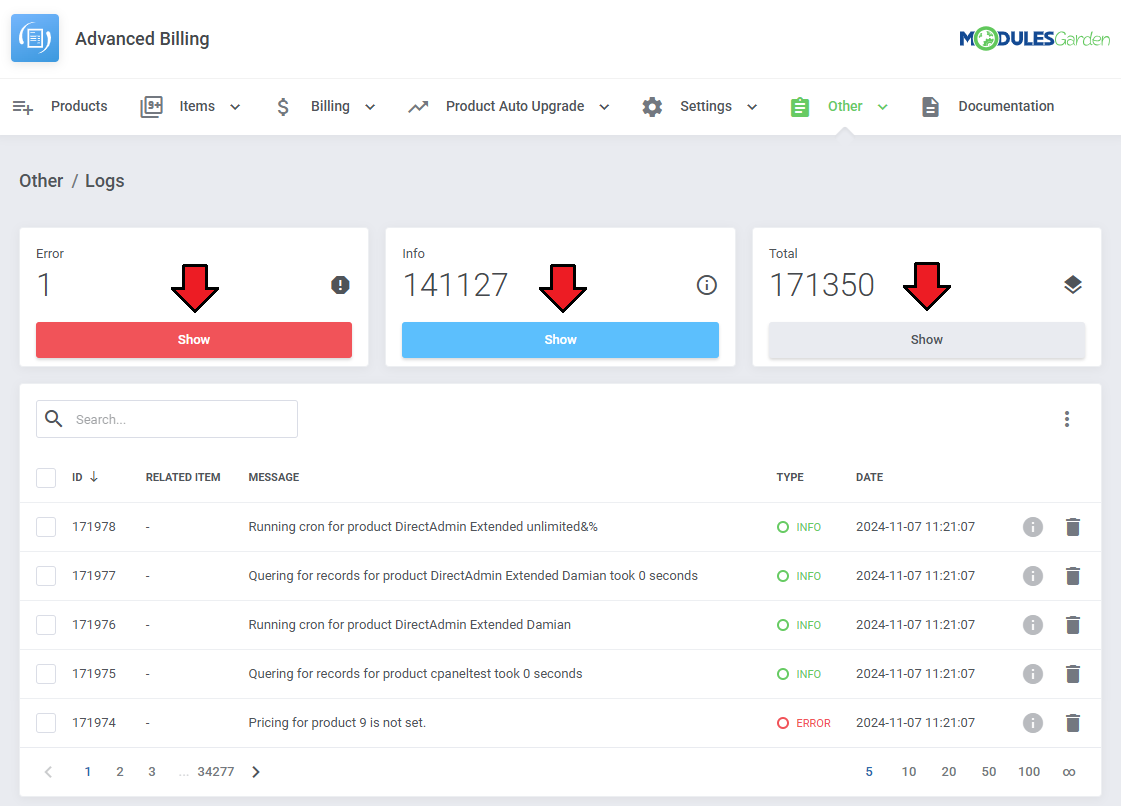
|
| You can delete logs either one by one or with the mass function. |
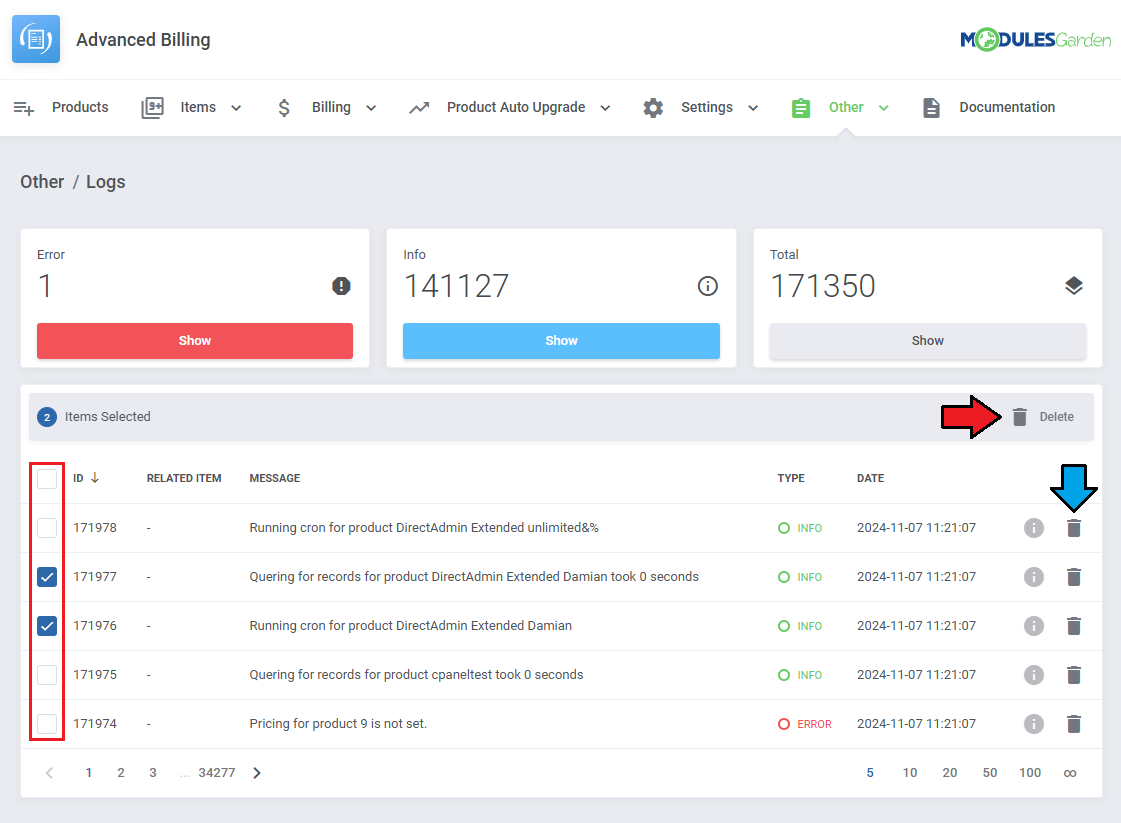
|
Additional actions include:
|
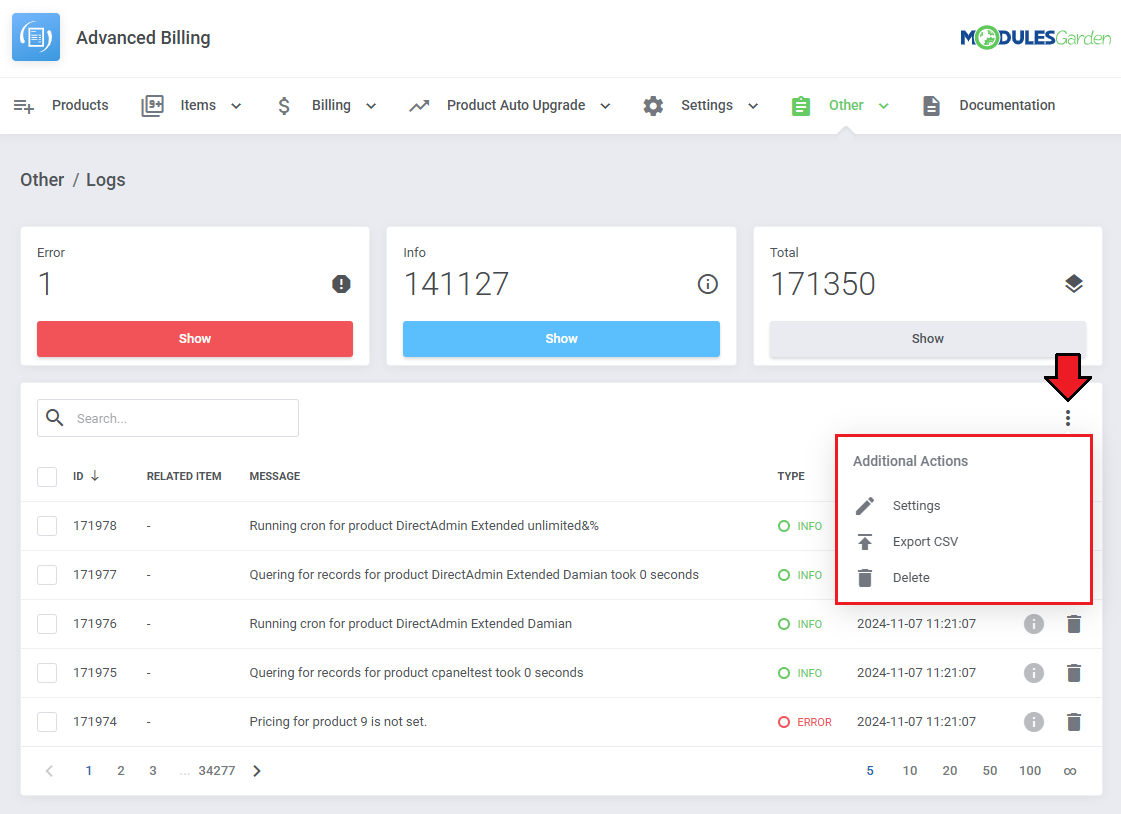
|
In the settings you may decide:
|
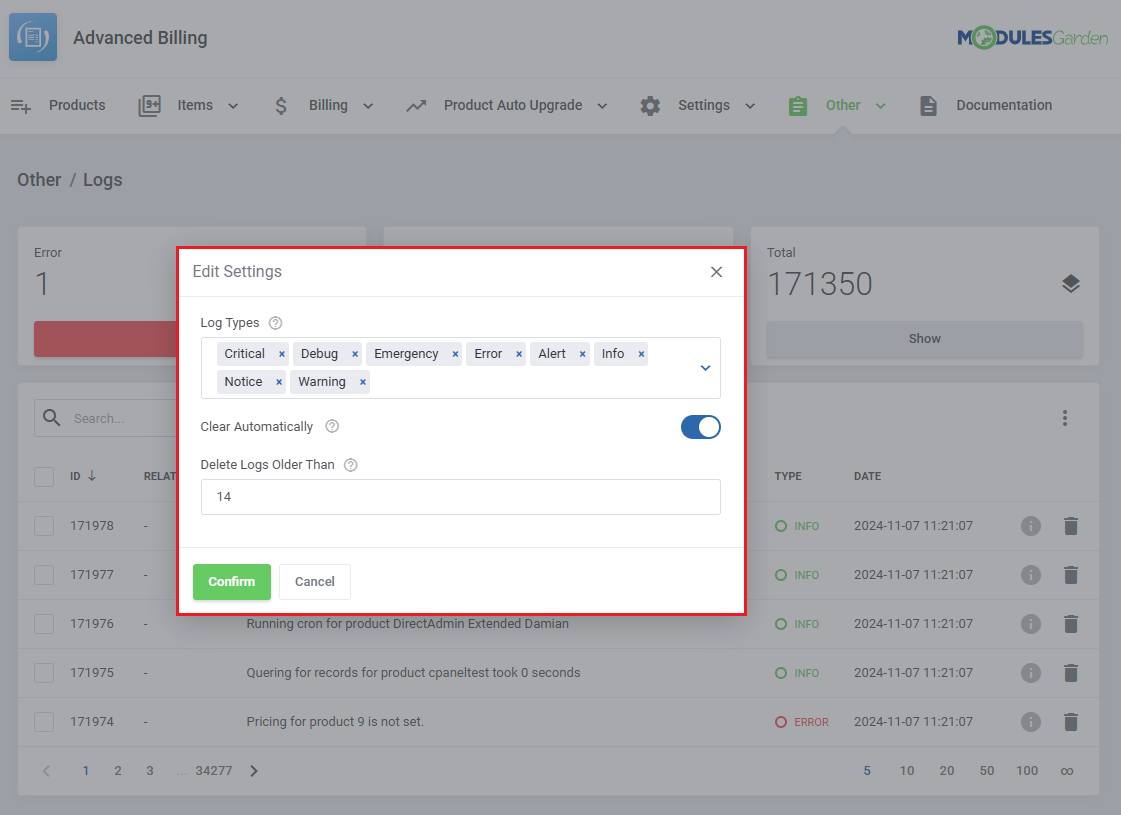
|
While exporting you will have to specify which logs to export:
|
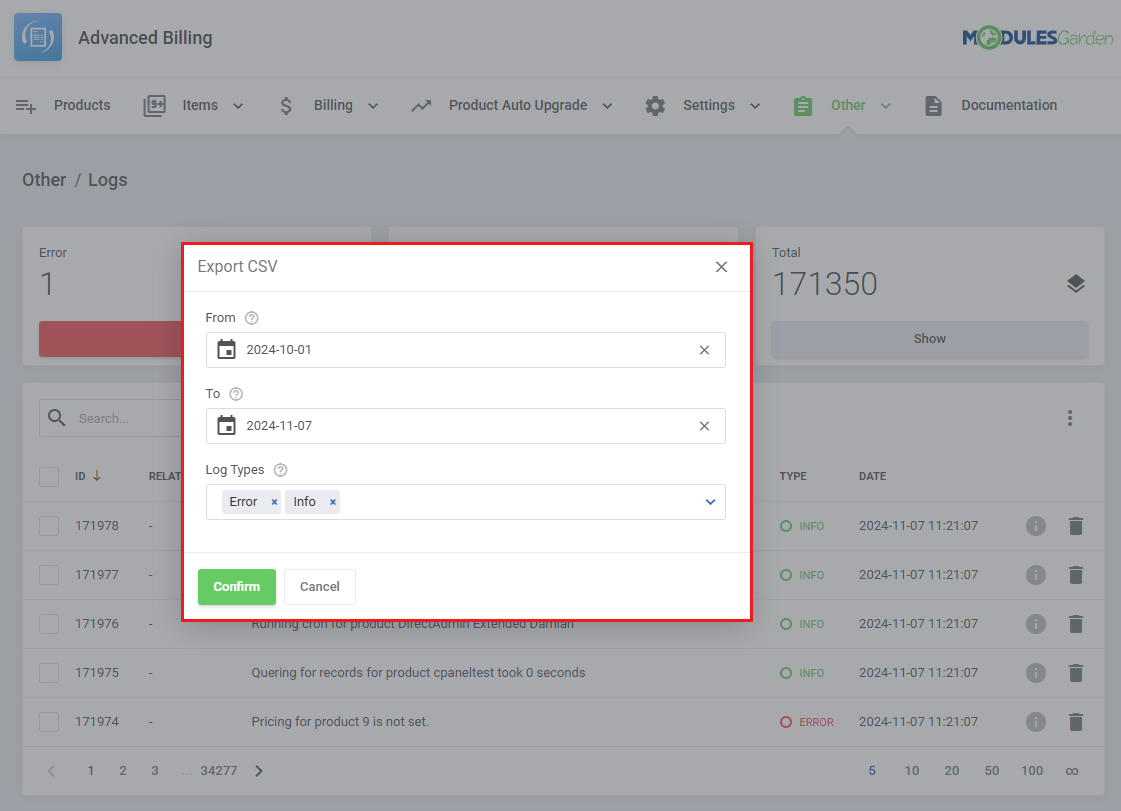
|
| You may also delete specific logs without finding them manually. Simply define:
|
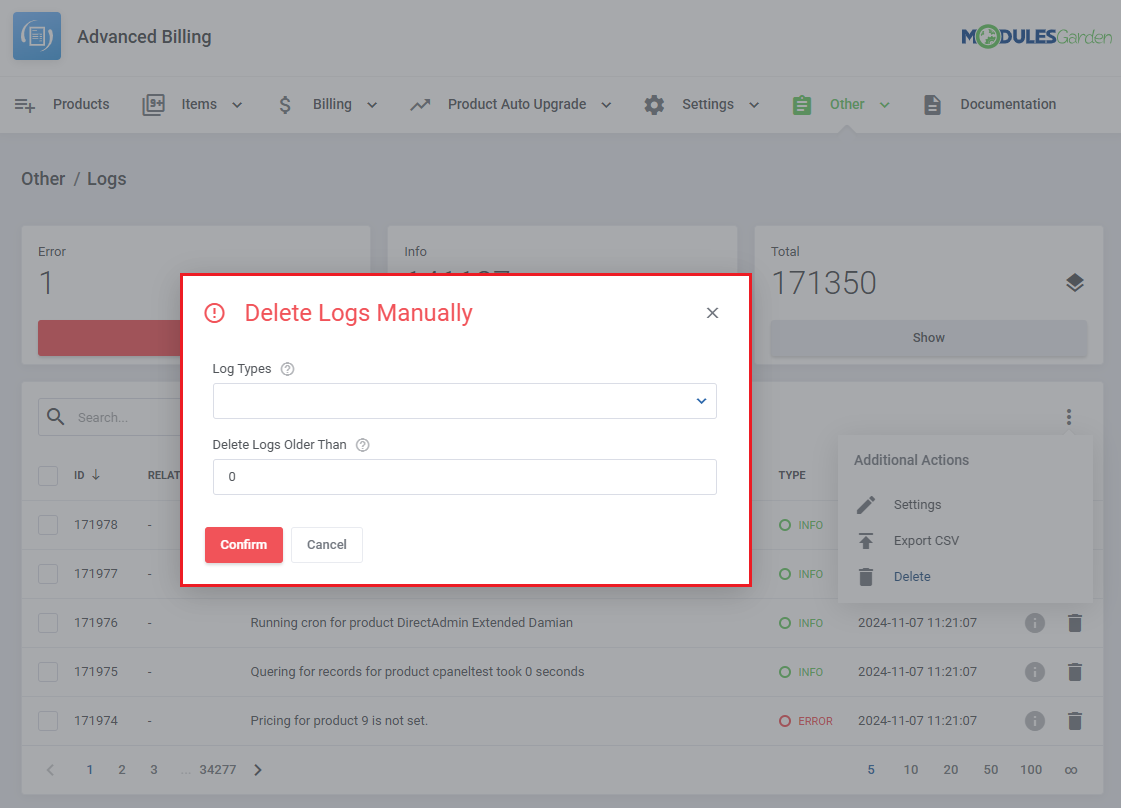
|
[edit] OpenStack Projects Configuration
[edit] Configuration in Files
| To use this feature, the client must have OpenStack Projects For WHMCS version 1.11.0 or later. Additionally, the default metric provider must be changed in the following file: At the top of this file, you will find the following lines: #metricProvider: "quotas" metricProvider: "gnocchi" The
The rest of the |
[edit] Example Configuration - Quotas
quotas:
metrics:
cores:
resource:
unit: "Core-Hours"
availableUnits:
"Core-Hours": 1
fixed_ips:
resource:
availableTypes:
"Hourly": "Hourly"
"Highest": "Highest"
availableUnits:
"Qnty-Hours": 1
"Qnty": 1
floating_ips:
resource:
unit: "Qnty-Hours"
availableTypes:
"Hourly": "Hourly"
"Highest": "Highest"
availableUnits:
"Qnty-Hours": 1
"Qnty": 1
injected_file_content_bytes:
resource:
unit: "Byte-Hours"
availableUnits:
Byte-Hours: 1
KiB-Hours: 1024
MiB-Hours: 1048576
GiB-Hours: 1073741824
injected_file_path_bytes:
resource:
unit: "Byte-Hours"
availableUnits:
Byte-Hours: 1
KiB-Hours: 1024
MiB-Hours: 1048576
GiB-Hours: 1073741824
....
|
For any quota not defined in this file, a default configuration will be used:
friendlyName: "quota_name" description: "Billing for quota_name" unit: "Qnty" availableTypes: Hourly: "Hourly" availableUnits: Qnty: 1 GiB-Hours: 1 MiB-Hours: 1 Qnty-Hours: 1 |
Explanation of configuration fields:
|
[edit] Example Configuration - Gnocchi
providers:
gnocchi:
metrics:
"memory":
query:
resource_type: 'instance'
operations: "(aggregate sum (metric memory mean))"
search: 'project_id={$project_id}'
request:
start: "{$start}"
stop: "{$stop}"
groupby: 'project_id'
details: "False"
needed_overlap: "0.0"
metricUnit: 'mb'
unit: 'gb'
....
|
Explanation of configuration fields:
|
| Replacement fields Several replacement fields dynamically pulling values from the module can be used:
|
[edit] Additional Configuration Files
In the modules/addons/AdvancedBilling4/app/Config/openstackprojects/ directory, apart from metrics.yml you will also find: auth.yml and quotas.json files.
|
[edit] Configuration in Addon
| The addon interface allows for configuration of key OpenStack Projects billing parameters directly from the WHMCS admin area. Available settings:
The "S3 Storage" metric is available for both gnocchi and quotas providers. It only works when Billing Mode is set to Domain. If set to Project, the metric value will always be 0. |
| Quotas Configuration Example: |
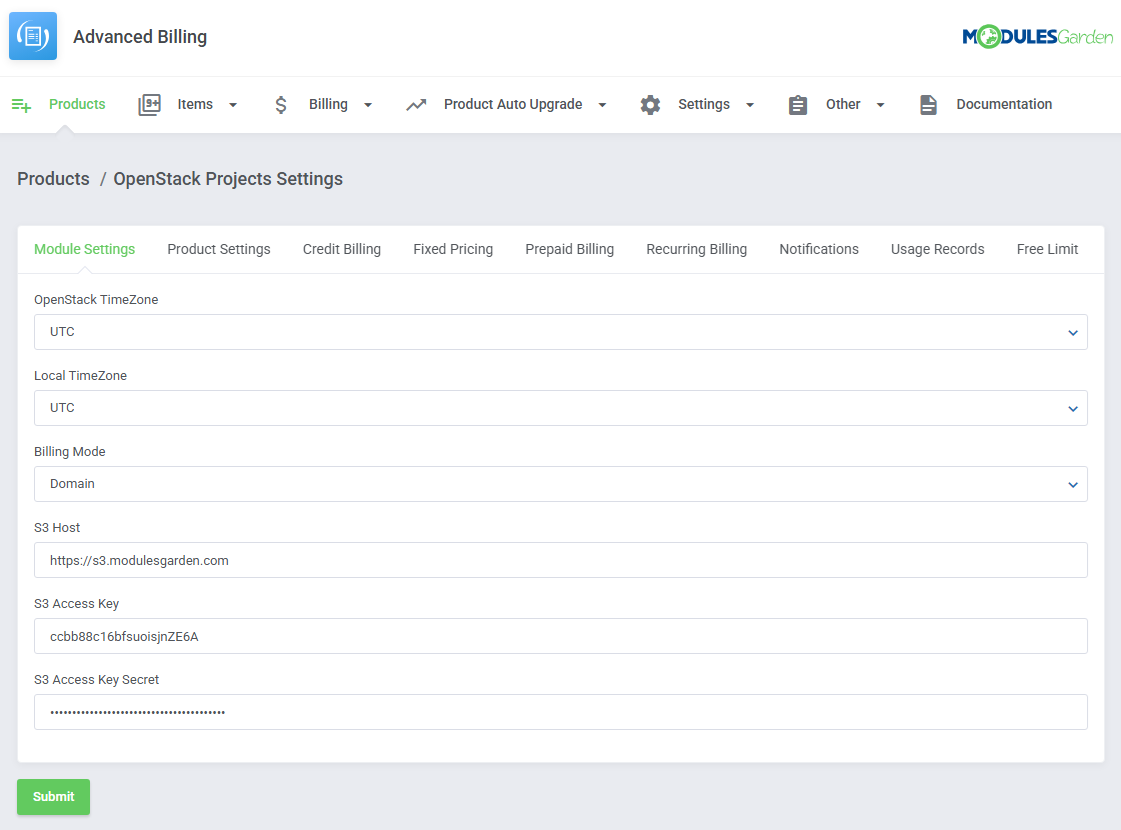
|
| Related metrisc list: |
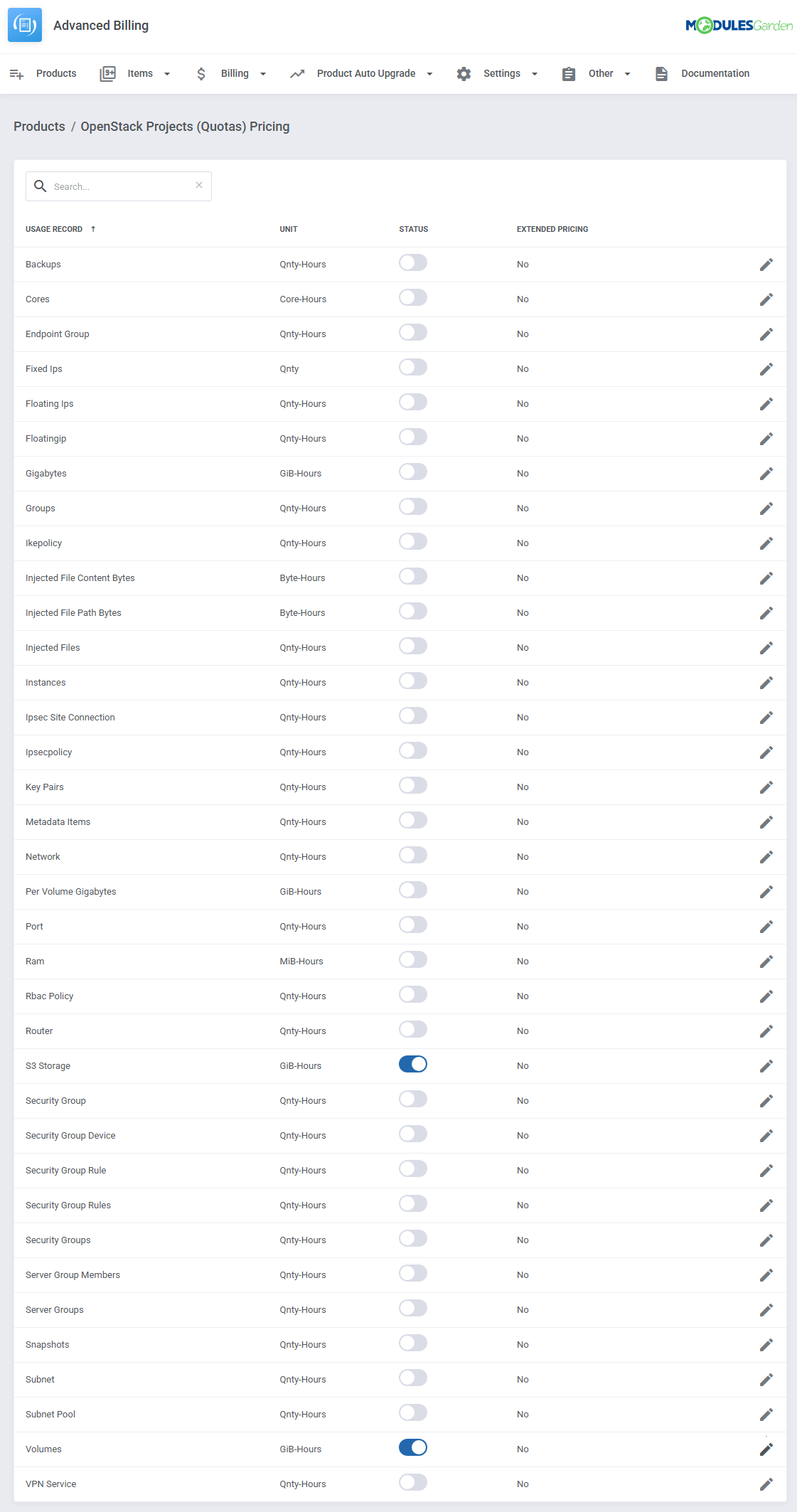
|
| Gnocchi Configuration Example The following options are managed directly in the Advanced Billing addon, apart from the standard ones mentioned above:
Important: Virtual Machines are billed only when they are directly connected to a custom network marked for billing by the administrator. |
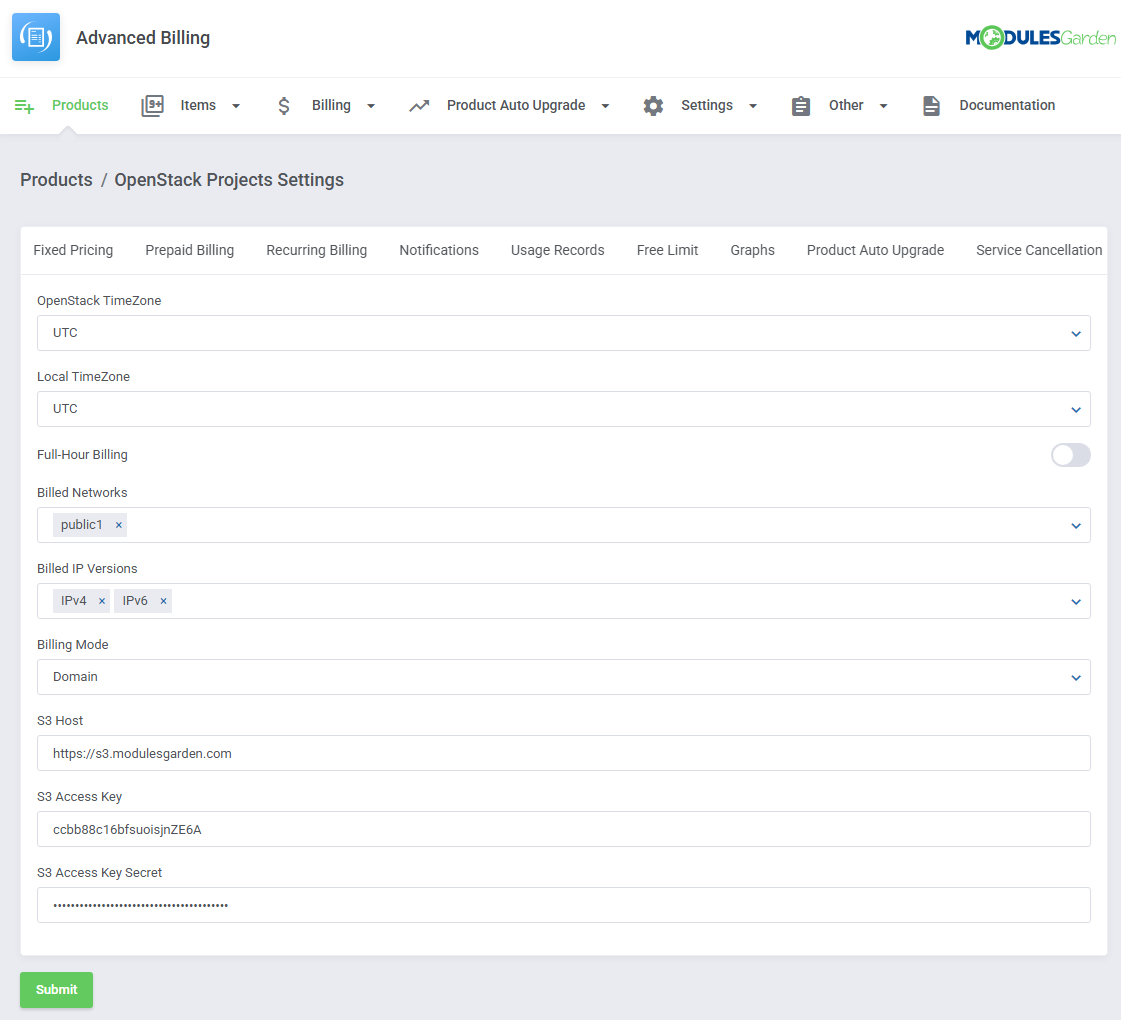
|
| Related metrisc prewiev: |
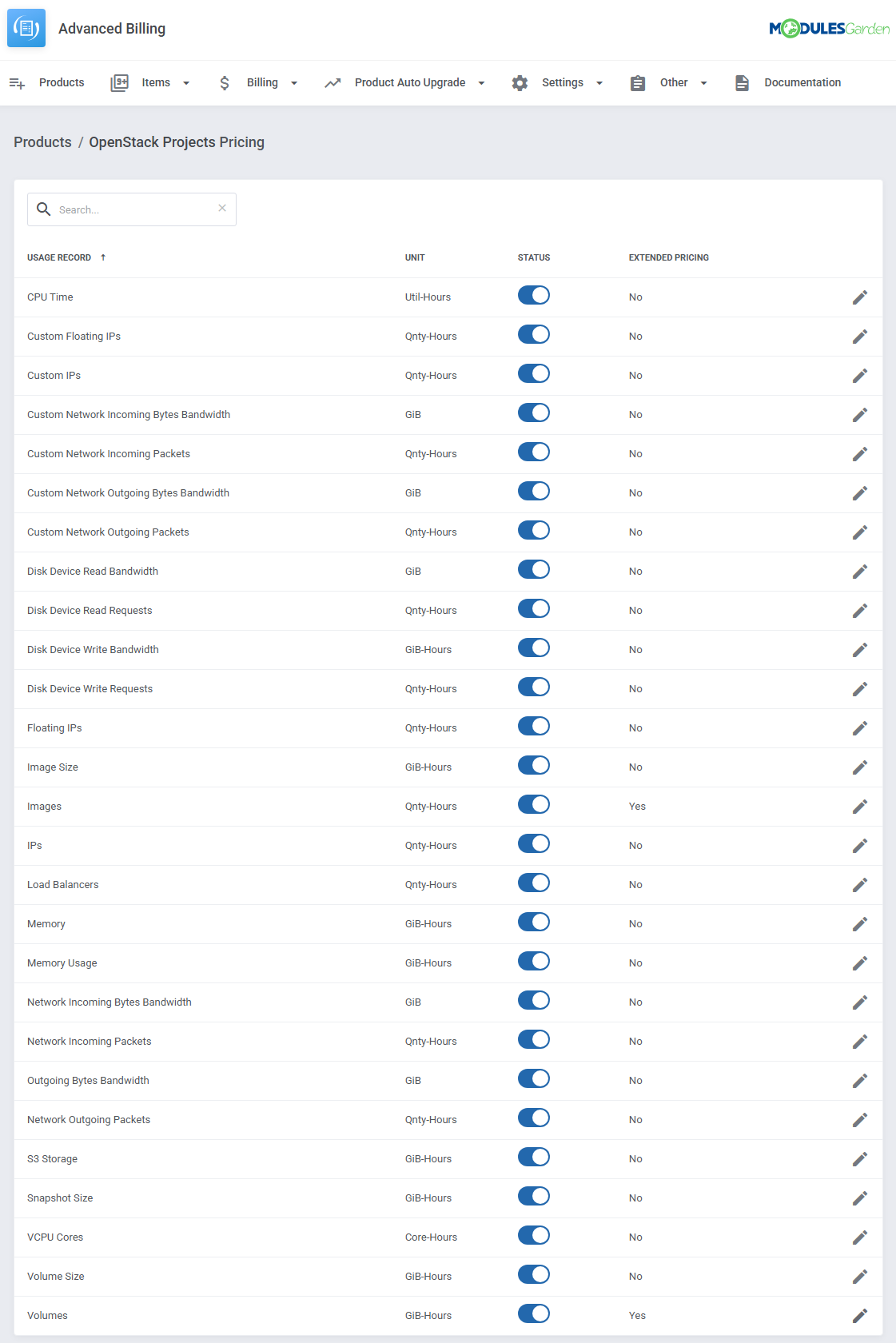
|
Important: Changing the metricProvider setting (in metrics.yml) will alter the available metrics shown in the interface. The S3 Storage metric is the only one that remains consistent across both providers. |
[edit] Use Cases
| This section provides sample scenarios that demonstrate common use cases, showing how the module’s features can be applied in real-world situations. Explore the examples below for practical insights into how the module works. |
[edit] Flexible Cloud Services with Prepaid Billing and Cost Control
| With Advanced Billing For WHMCS, you can deliver a cloud-like experience that gives clients full control over resource selection, deployment, and billing preferences. Clients can top up their account balance and then deploy and manage virtual machines on demand, eliminating the need for separate orders. You benefit from full cost transparency, a secure prepaid system, and automated billing, while your clients enjoy fast provisioning and real-time insights into their usage and expenses. |
[edit] Key Benefits
|
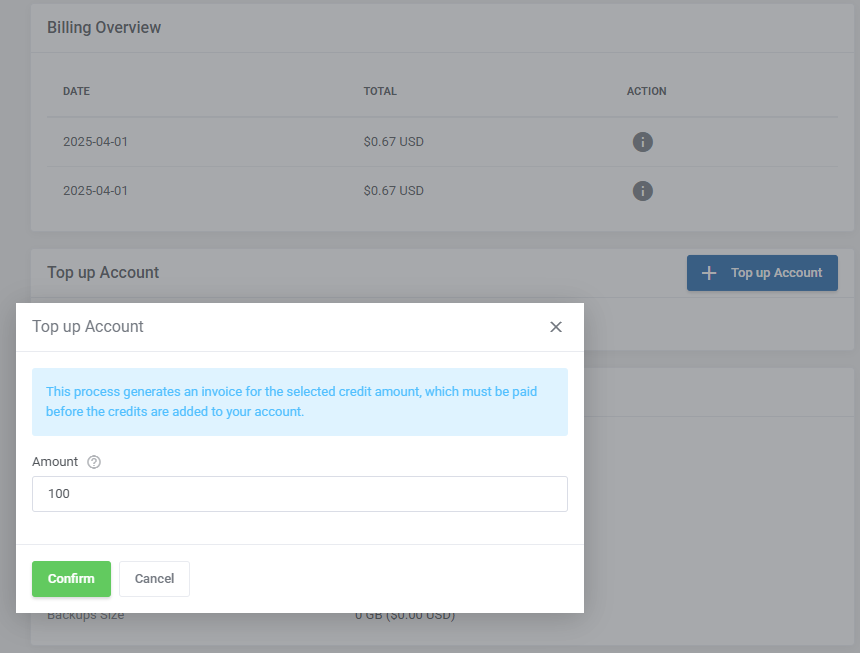
|
|

|
|
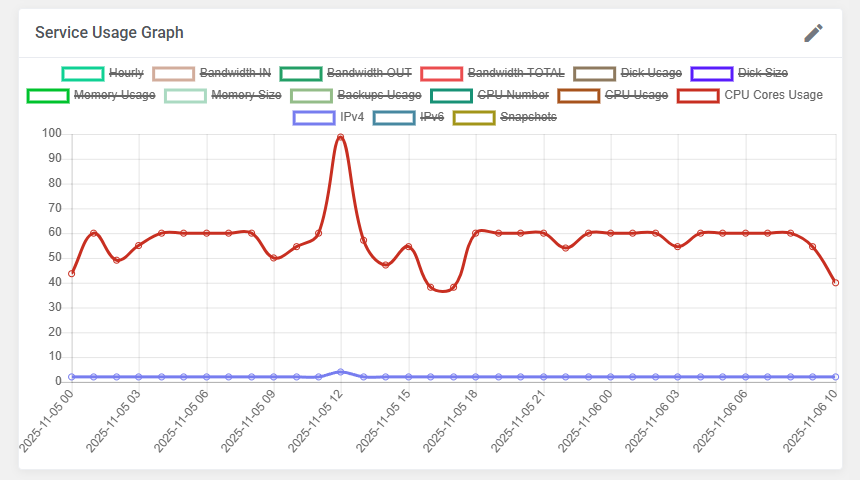
|
Billing options available in the module:
|
[edit] Recommended Integrations
| For cloud deployments, we recommend starting with:
For enterprise-level solutions, you may use:
|
[edit] Configuration steps
| 1. Install and configure your provisioning module. In this example, we use OpenStack Projects For WHMCS module. Follow the installation guide to prepare the product for Advanced Billing integration. |
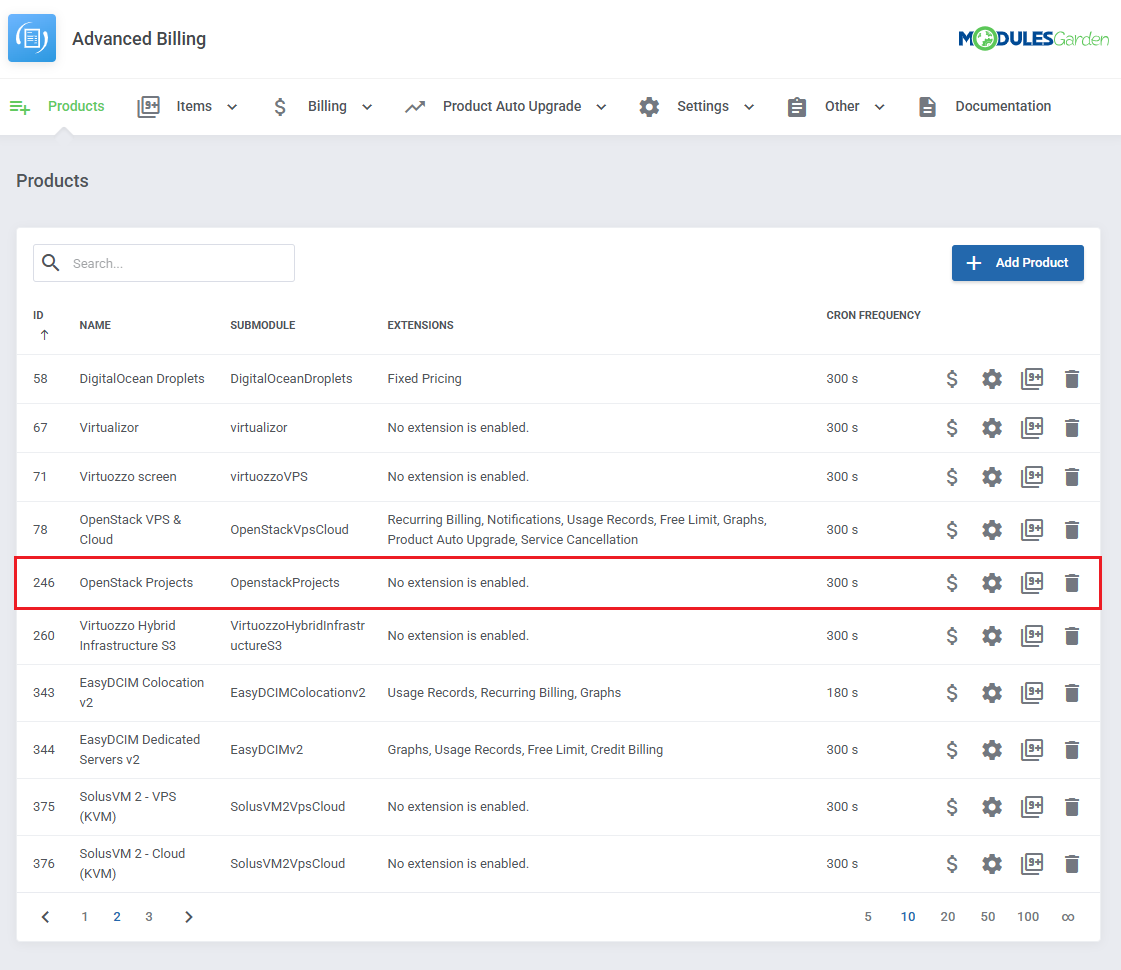
|
| 2. Define pricing for each usage record. |
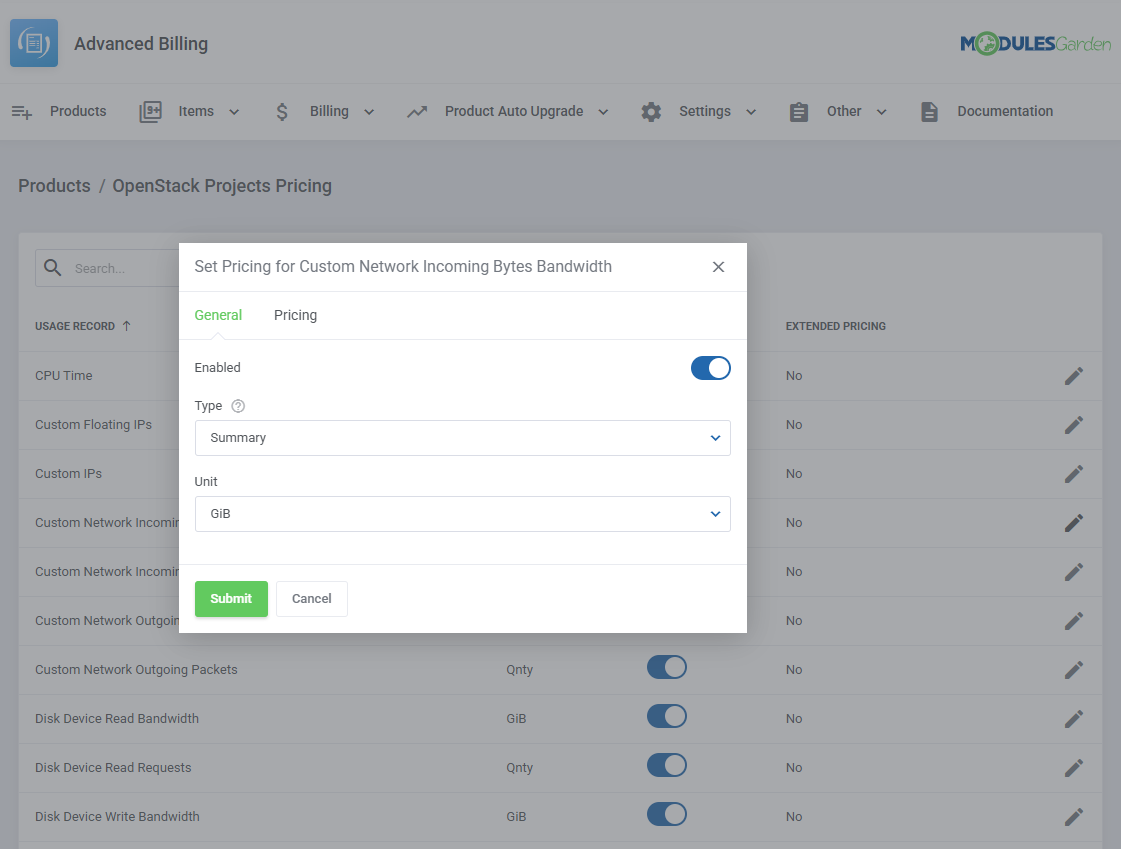
|
3. Move to Product Settings of the OpenStack Projects product and adjust the following:
|
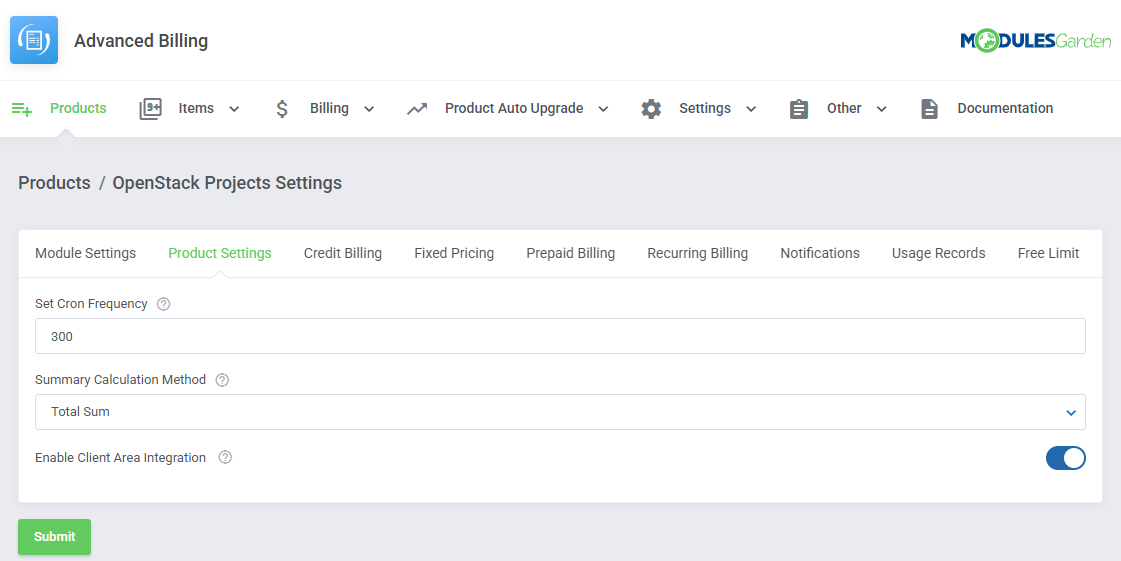
|
4. Enable and configure Prepaid Billing for the product and fine-tune the billing behaviour:
|
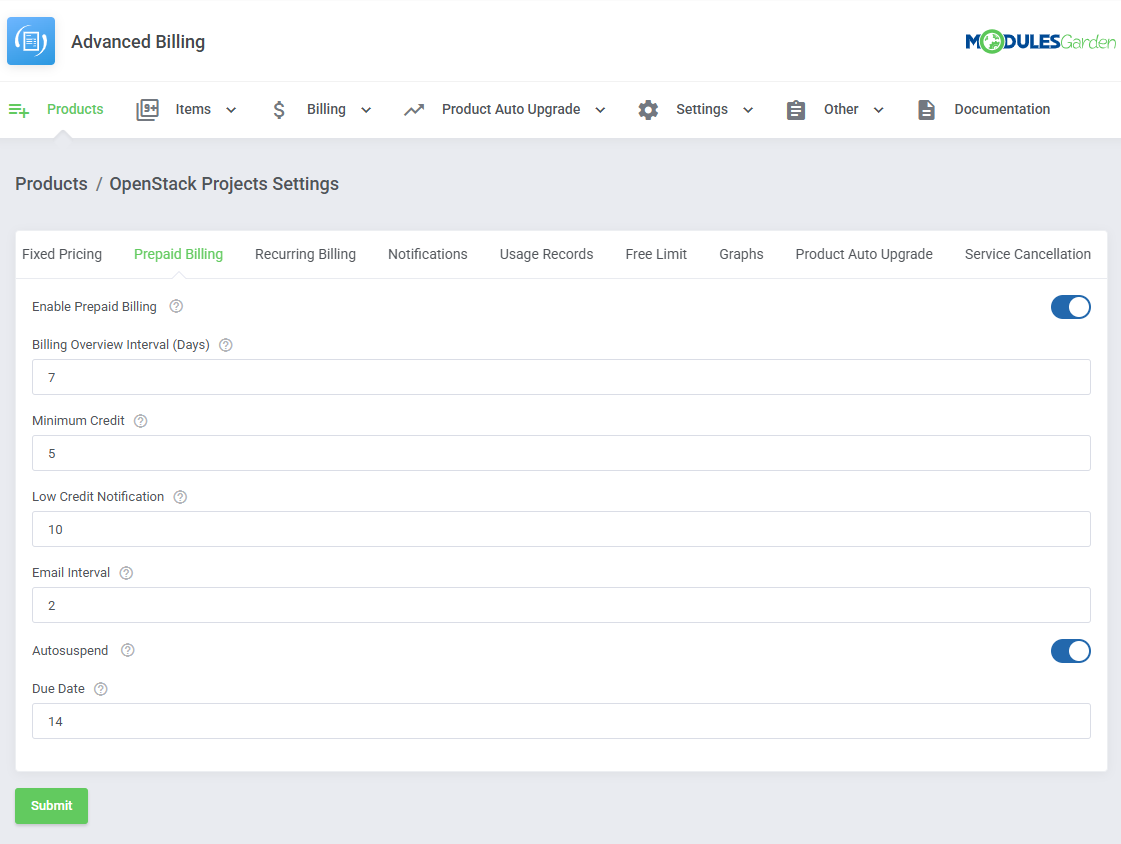
|
5. Activate optional extensions for advanced usage visibility. We recommend activating:
|
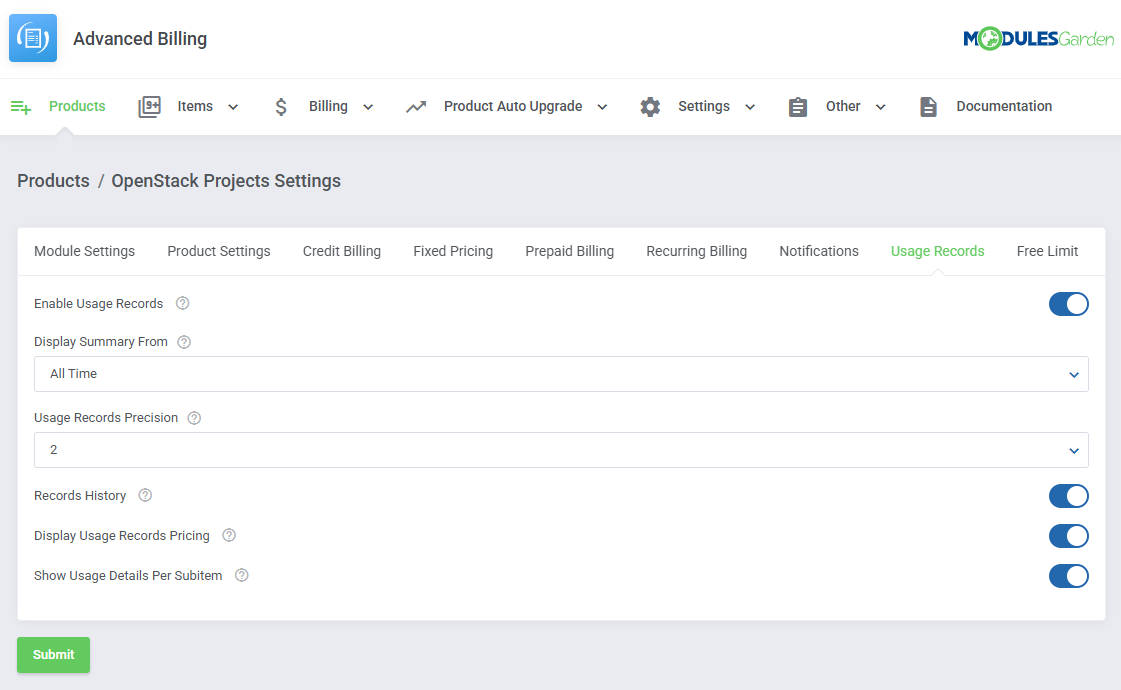
|
| 6. That is all. Your configuration is complete. From this point on, Advanced Billing For WHMCS will handle cost tracking and charging automatically. Your clients can now top up their balance, deploy services, monitor usage, and manage everything directly from the WHMCS client area. |

|
[edit] Tips
| 1. In version 4.0, the "Extensions" section has been removed, so the module license must now be placed in the "license.php" file. If upgrading from version V3.X, re-add the license to the "license.php" file and reissue it from your client area panel. |
[edit] Update Instructions
| Essential guidance through the process of updating the module is offered here Ensure successful completion of the module update by carefully following each step, thereby preventing data loss or any unforeseen issues. |
[edit] Module Upgrade From V3.X to V4.X
Upgrading from version 3.X to 4.0 requires additional steps due to the changes in the module structure. Please follow the instructions carefully to ensure a smooth transition.
|
[edit] Upgrade Guide
| Seeking a solution that offers greater flexibility, customization tailored to your precise needs, and unrestricted availability? There is an option that not only proves to be cost-effective in the long run but also includes prioritized support services, making it a truly valuable investment. Opt for the Open Source version of your Advanced Billing For WHMCS module to unlock these benefits. Follow a comprehensive guide covering the transition process, the advantages it brings, and step-by-step instructions on what to do next after the order has been successfully finalized. |
[edit] Common Problems
| 1. When you have problems with connection, check whether your SELinux or firewall does not block ports. |
| 2. Cron Threads feature currently does not work for the EasyDCIM submodule. In case you have enabled Cron Threads, cron tasks for EasyDCIM submodule will be executed in a basic way. This option will be implemented in future releases of the Advanced Billing module. |
| 3. If you encounter metric calculation problems with OpenStack Projects products, make sure you are using version 1.9.0 or newer of OpenStack Projects, as earlier versions are not supported. |
4. If you encounter the error message: "You cannot enable the option. Please check the option configuration." when trying to enable auto upgrade for a group, make sure all the conditions are met:
|